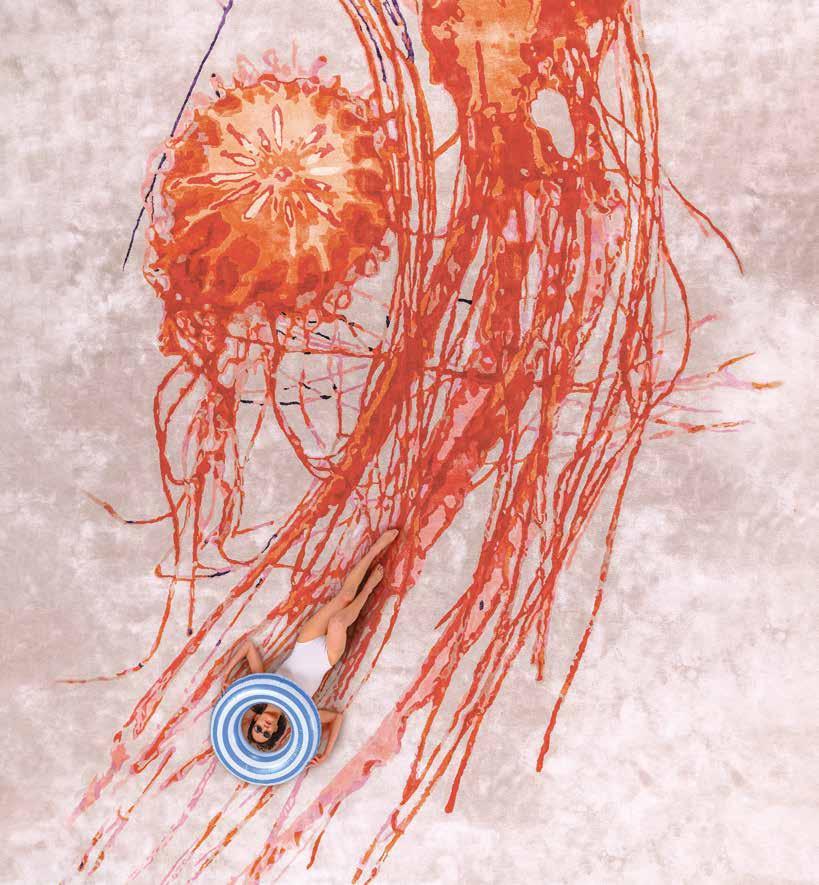



WORLD LEADING MANUFACTUERER OF HAND MADE CARPETS








CARING for BEAUTY since 1873
EXPLORE THE HOUSE OF YACHTING AT BENETTIYACHTS.IT

Thanks to the unmatched expertise of BGH, we proudly present a groundbreaking new range of multihull boats with foiling technology, pushing boundaries and setting a new standard for what lies ahead.










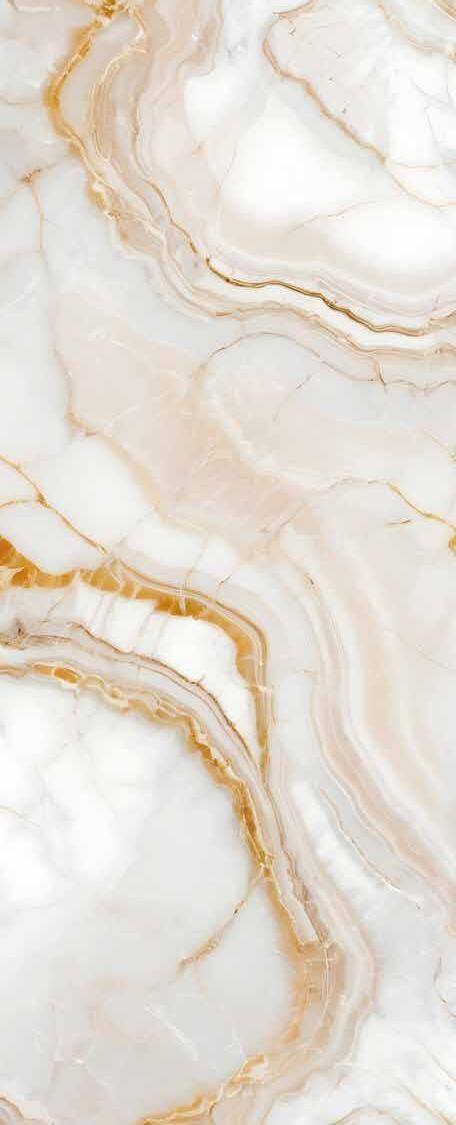
Dear Readers,
We begin 2025 with the knowledge that we have many new developments to discuss, enough to occupy us for the entire year! The mega- and giga-yacht sectors look set to enjoy further growth in both sales volumes and new developments in exterior design and interior furnishings.
As always, we’ll make our contribution to the flow of information through the pages of THE ONE Yacht & Design and the social and digital media, but from this year we’ll also be organising information-sharing events and talks on various aspects of the world of on-board yacht design. We’ll post the schedule on line soon.
Meanwhile we just came back from Düsseldorf and getting ready to travel Miami and Dubai, where the first shows of the year are opening their doors.
Sadly though, this year we shall be without the presence of Paolo Vitelli, founder of the Azimut|Benetti group, which over its 55-year history has become the world’s largest producer of motor yachts above 24 metres in length (read the article of page 14). I met him in 2006, when I was editor of a travel and tourism magazine, and I realised straight away that he was a truly exceptional man. He showed me round the Hotellerie de Mascognaz, a group of period buildings in the Alps that he had restored and transformed into a unique boutique hotel. One of his passions, where he combined his love for nature with the entrepreneurial flair that enabled him to achieve such extraordinary results.
Enjoy your reading!
CEO Platinum Media Lab










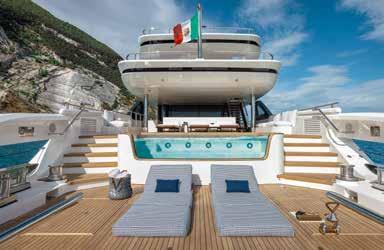

80 Creative Minds: Cantieri di Pisa
86 Megayacht: AB Yachts AB 110
98 Art on board: The Wild Dreams of James Ensor
102 Trend Setter: Amdl Circle - Michele De Lucchi
108 Megayacht: Sunseeker Ocean 156
120 Mise en Place: Splendid Opulence
124 Megayacht: Alia yachts 45m San
136 Technology: Silent Power, intense Emotions
140 Chase Boat: A new Yacht Concept



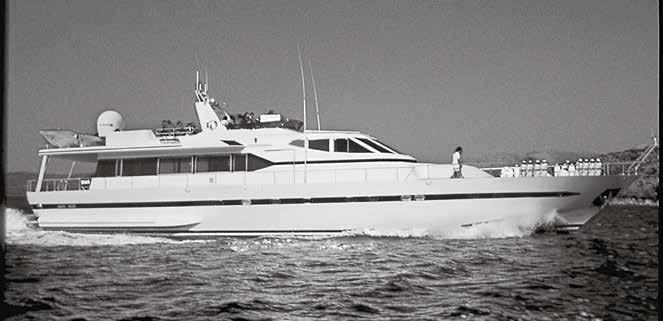
Goodbye to Paolo Vitelli, founder and Honorary Chairman of Azimut|Benetti Group. An icon of the modern yachting world. A passionate, visionary entrepreneur, he was capable of looking to the future with courage and generating innovation and growth in the yachting industry
by Désirée Sormani - ph. courtesy by Azimut|Benetti Group

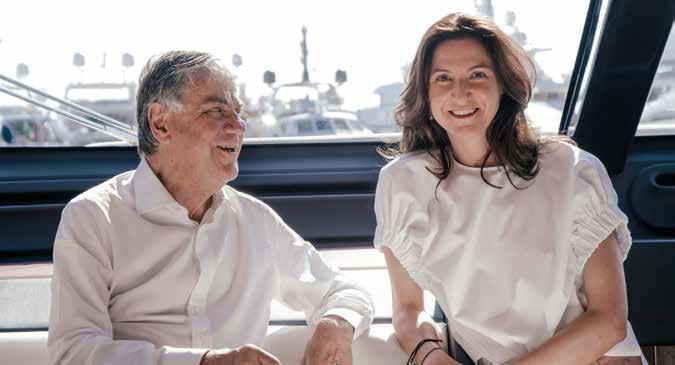


He had a passion for the sea, but at the same time he adored the soaring peaks of the Valle d’Aosta, where he spent his childhood holidays. Paolo Vitelli left us at the age of 77 in Ayas. The cause was a domestic accident, when a fall in his chalet proved fatal. Paolo Vitelli, founder and Honorary Chairman of Azimut|Benetti Group, which for 25 years has been world number one in the production of megayachts over 24 metres, was not just a far-sighted entrepreneur - he was the icon of modern yacht-building, a prolific pioneer of trends that have influenced a whole series of yachts from the point of view of design, technology and sustainability. His daughter Giovanna, who is now at the helm of the business, which ended the financial year on August 31st, 2024 with revenues of 1.3 billion euros and an order portfolio that extends to 2029, told me in a recent interview, “My father developed a heightened awareness of environmental issues many years ago. In 2006 he proposed the first Benetti diesel-electric, which cut fuel consumption by ten per cent, and worked hard
These pages, Paolo Vitelli, founder and Honorary Chairman Azimut|Benetti Group, world no.1 in the production of megayachts over 24 metres for a quarter of a century, and his daughter Giovanna, now at the helm of the Group. Right, the Azimut 62s revolutionises the sports yacht market. It is the first nautical coupé and the first yacht to replace the classic portholes with square hull windows. Opposite page, top, Failaka 105 (1982) is the largest fibreglass yacht ever built. Azimuth was the first yard to use this material to build yachts over 30 metres in length
to develop the in-house production of carbon fibre as a construction material for superstructures. In practice, we took the material in its pure form as it used in sports car and aircraft manufacture, adapting to our infusion process. The ultimate aim was light weight rather than speed, leading to reduced fuel consumption”. His entrepreneurial investment and enlightened vision blazed a trail now followed by many other businesses. After graduating in economics and commerce in 1970, in 1969 Paolo Vitelli founded Azimut, a company focused on the trade and construction of leisure boats, using savings from student jobs. Over its 55-year history, the company has grown rapidly and consistently, while remaining a privately-owned enterprise with high levels of innovation and technology. This growth has been achieved almost entirely through organic development and a few acquisitions, with a notable exception in 1985 - the rescue of the Benetti shipyard, a symbol of Italian excellence. This acquisition led to the company’s name change to Azimut|Benetti. Vitelli has also been involved



in significant industrial diversifications, such as the construction of modern marinas in Varazze, Viareggio, and Livorno (Italy), in Malta beneath the old city of Valletta, and in Moscow on Lake Himki (Russia). He created also a small chain of boutique hotels by restoring historical buildings in Chamonix (France), Champoluc, and Mascognaz (Valle d’Aosta, Italy), for which he received the regional honour of being welcomed into the prestigious ranks of the “Amis de la Vallée d’Aoste.” From 1974 to 2018 he also served as Norway’s Honorary Consul. From 1998 to 2006 he was the President of UCINA (now Confindustria Nautica), the association of the Italian nautical industry. Offering its condolences, Confindustria Nautica recently recalled him with great esteem. “During his long mandate as president of the sector’s trade association he led with vision and determination, obtaining valuable results for the whole industry. Paolo Vitelli leaves an extraordinary heritage – that of a passionate, far-sighted entrepreneur who was able to look to the future with courage and generate innovation and growth without ever losing sight of personal and environmental values”.
In 2004 he was awarded an honorary degree in Mechanical Engineering from the Polytechnic University of Turin and he also received the “Champions of Growth” award from Confindustria for the company’s achievements in growth, innovation, and internationalization during the 2001-2006 period.
From March 2013 to September 2015, he served as a Member of the Italian Parliament, elected under the Civic Choice with Monti for Italy list. He was a member of the Committee for the Security of the Republic (COPASIR) and the Transport and Finance Commissions. A few years ago he handed over control of the Group to his beloved daughter Giovanna, who is displaying great skill in leading six shipyards located in Avigliana (Piedmont), Savona (Liguria), Viareggio and Livorno (Tuscany), Fano (Marche) and Itajaí (Brazil). During the September yacht shows Giovanna Vitelli told us her father was making the most of what remained of the summer, sailing among the Greek islands on board his yacht. She said he was happy.
Fair winds and following seas to you, Cavalier Vitelli!


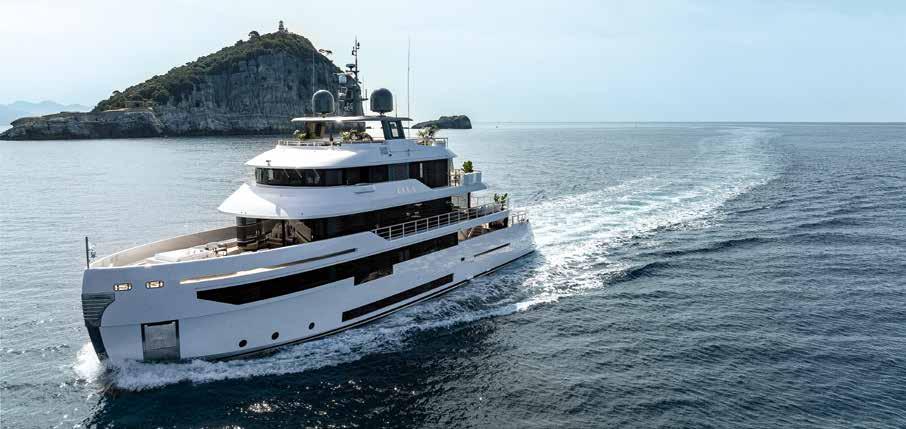
Paolo and Giovanna Vitelli during Benetti’s 150th anniversary celebrations. Above, B.Yond 37M, an innovative model with hybrid propulsion, and below, the giga yacht Luminosity. Opposite page, top, with Italian President Oscar Luigi Scalfaro: on 1st June he was awarded the title of Cavaliere del Lavoro. Below, a young Paolo with Giovanna as a little girl
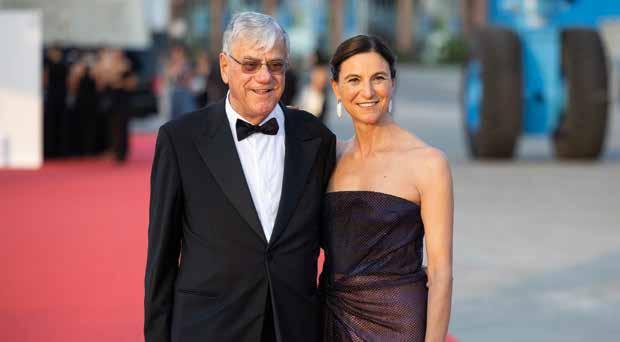


by Désirée Sormani
What is the state of the yacht market in the Netherlands at the moment and how do things look for Oceanco?
The Netherlands continues to set the standard for high-quality craftsmanship and innovation when it comes to building large yachts. Oceanco is proud to contribute to this reputation. We currently have five yachts under construction, ranging from 80m to 130m, each one reflecting the one-of-a-kind vision of its owner. Alongside these new builds we’re also working on a variety of refit projects, breathing new life into iconic Oceanco yachts such as Draak (former Tranquility) as well as vessels from the wider global fleet.
Custom building is a core part of Oceanco’s DNA, as well as innovation. How does the new collection “Simply Custom”, launched in 2023, differ from your previous models?
In a world where countless demands compete for our time and attention, the most valuable experiences often bring simplicity instead of adding complexity. This is why we have launched a new way to build your custom yacht that guarantees Oceanco’s outstanding pedigree while streamlining the process for the owner. Available from 80m (262ft) in length, or 2,500-2,700GT, the technical foundation of Simply Custom delivers the flexibility to include what most excites and inspires you, alongside the exceptional technical standards and collaborative approach for which Oceanco is renowned. The technical foundation is engineered to provide world-renowned designers with a canvas upon which to create a characteristically stunning Oceanco yacht.
Recently you launched an evolution of the Simply Custom philosophy. What new thinking does this involve?
At Oceanco, we only build custom yachts. But that doesn’t mean we take a standard approach. Over the years of working with owners, we have learned how their motivations and needs vary. By understanding how each client is looking to experience their yacht we can tailor this journey for maximum enjoyment throughout. As a result we have developed a nuanced range of offerings that reflect a range of custom
yacht solution, from the more streamlined route of Simply Custom to delivering complete owner visions through Full Custom and tackling what others deem impossible with Beyond Custom. Oceanco remains by their side with the Life Cycle Support service to provide maintenance and upgrades.
What makes Oceanco’s range different from those offered by other international shipyards?
It has been my privilege to work at Oceanco for three decades now, and my appreciation for our company’s rare essence and approach continues to grow year after year. If I were to sum up this unified essence in three words they would be innovation, co-operation and pride. Our purpose is to create the world’s most innovative and exciting yachts. But it’s extremely difficult to be innovative on your own. Only if you have the ability to operate in partnerships, can you become truly innovative. That is why our entire business model is based on co-operation through longstanding partnerships with our core network of co-makers. These collaborations ensure that each delivery marks a progression from the last, including making improvements in the critical context of sustainability. Last but not least, it is one of my strongest held beliefs that we have to build great relationships with our clients before we can build great yachts with them.
What does the future of Oceanco look like?
As CEO of Oceanco, I am often asked how I see the future of the company. I am extremely reassured by the next generation of Oceanco leaders who are coming through today. They show such passion, dedication and care that I know Oceanco will uphold our company’s core values and vision for the duration. They are also mindful of the environment and seek ways to enhance our world through the yachts that we create. There will surely be some extraordinary yachts built for visionary owners who want to go their own way, and Oceanco

by Veronica Lempi

CRISTINA Rubinetterie, which designs and manufactures taps and shower systems, imagines a future made of products that combine beauty, functionality and environmental awareness. Founded in 1949, over the past 75 years it has capitalised on the values of production skills, tradition and credibility. These guiding principles now inspire a vision that is increasingly focussed on a sustainable future, as reflected in a new corporate claim: “From yellow…to green”. One of the most recent developments in this context was the company’s announcement in 2024 of a new galvanic plant at the Gargallo facility. This marks a step forward in both product quality and environmental awareness.
Whatdoestheword“quality”mean,andwhichlineareyoumostproudof?
Qualityisthedrivingprinciplebehindeverythingwedo.Weselectourmaterialswithgreat caretoensureourmixertapsprovideenduringperformanceandsafety.Wethinkofdesignasa fusionofbeauty,functionalityandergonomicswithsolutionsthatsatisfytechnicalandaesthetic requirements.Weusecutting-edgeproductionprocessesbasedonprecisionandinnovation.We arealwaysworkingtoreducewaste,optimiseconsumptionanddevelopincreasinglysustainable products.Wecarryoutrigoroustestsoneverythingwemake,withintenseattentiontodetail. Finally,it’scrucialforustohaveadirectrelationshipwithourclientssowecanprovidean outstandingexperience,withpersonalisedassistance,thatgoesbeyondthepurchasingprocess.Our offerincludesahugerangeofmodelsthatwe’reveryproudof,especiallythePiegaseriesdesigned byBellucciMazzoniProgetti.It’sentirelyinstainlesssteelsoit’sidealforthenauticalsector.
Howdoyoumanageyourresources,especiallywater?
Responsibleresourcemanagementisacoreelementinourcorporatephilosophy.Astap manufacturersweareawareofourresponsibilitytocontributetosustainablewateruse.That meansdesigninglow-consumptionproductsthatwhileprovidingmaximumwell-beingarealso efficientfromthepointofviewofwaterandenergyuse.Weadoptprocessesthatminimisewater consumptionandcutwastebyimplementingrecyclingandwaterre-usesystemsinthesupply chain.ThegalvanicplantattheGargallofacilityisourmostrecentinvestment.
WhatistheCRISTINADesignLab?
It’sourin-houseR&Ddepartment,thebeatingheartofourinnovationanddesign.Everydaywe worktodevelopfunctional,technologicallyadvancedsolutionsthatserveasabenchmarkforthe designsector.Wearealwayslookingtothefuturewhileretainingacontinuitywiththepast.The CRISTINADesignLabalsocollaborateswithdesignersinvolvedinresearchanddesign.
Whatareyourmostinterestingideasforthefuture?
Welooktothefuturewiththeaimofcombininginnovation,sustainabilityanddesign.We’re investinginmaterialsandtechnologiesthatenableustocreateproductsthataresafer,more hard-wearingandenvironmentallysound.Webelieveinusingmaterialslikestainlesssteelthat offeroutstandingperformanceanddurabilitybutarealsorecyclable,helpingtoreducethe environmentalimpact.We’readoptingbrasswithalowleadcontent,achoicethatreflectsour commitmenttosafetyandconformitytothemostadvancedstandards.Intermsoffinishes,PVD treatments(PhysicalVaporDeposition)arethefuture–theyprovideexceptionalresistanceto scratchingandchemicalagents,aswellasalmostendlessaestheticpotentialforenhancingthe designofourproducts.
Istheyacht-buildingindustryafieldyouareregardingwithinterest?
Yes,ourknow-howandourfocusondesignandmaterialsqualitymeanwe’rereadytomeet therequirementsofthesector.We’realwaysinterestedinexploringnewopportunitiesand partnerships,usingourskillstodevelopnewsolutionsthatareidealforthenauticalsector.


AND NOW…WHAT’S HAPPENING AFTER THE “COVID BUBBLE”?
by Andrea Pezzini, CEO & Co-Founder of Floating Life
We’ve no choice but to admit it – for operators in the sector like us the immediate post-Covid period generated a feeling that the good times were rolling once again for the yacht building industry. Owners had rediscovered a desire to board a yacht with their family and enjoy the sensation of enjoying life, distancing themselves from the pressures of work. Everything seemed to have settled down and people had recovered some of their joie de vivre. But it was all an illusion – in the space of only three years we more or less went back to where we were before and the market is once again shrinking, returning to its “tired” phase in the cyclical progress that is typical of our sector.
The rather clear signals are there for those who are willing to read them. When materials are readily available and the yards began to admit to free production slots it means the market is starting to decelerate.
Let’s agree it’s not a drama for those who know how our market works – we live in a state of rise and fall in an almost constant cycle, linked to factors that not always (or almost never) correspond to financial crises, as they are more closely linked to saturation periods in areas of the market that have opened up in the wake of growing international prosperity.
As this article isn’t about providing an in-depth analysis, I’ll restrict myself to calling on all market operators to start investing their commercial resources in going out and exploring new areas of the world where this type of business hasn’t yet established itself but where we can see the local economy growing, inevitably accompanied by a desire for well-being and luxury.
So let’s pack our bags and set out in search of new markets –the time is right for those of us with an entrepreneurial spirit and a hunger for growth!
Thefuturewon’tbeeasy,butasalways,thesewords willjustbelostinthewind!

A selection of new projects and concepts from the leading international shipyards and design studios that will grace the waves in the near future
by Désirée Sormani
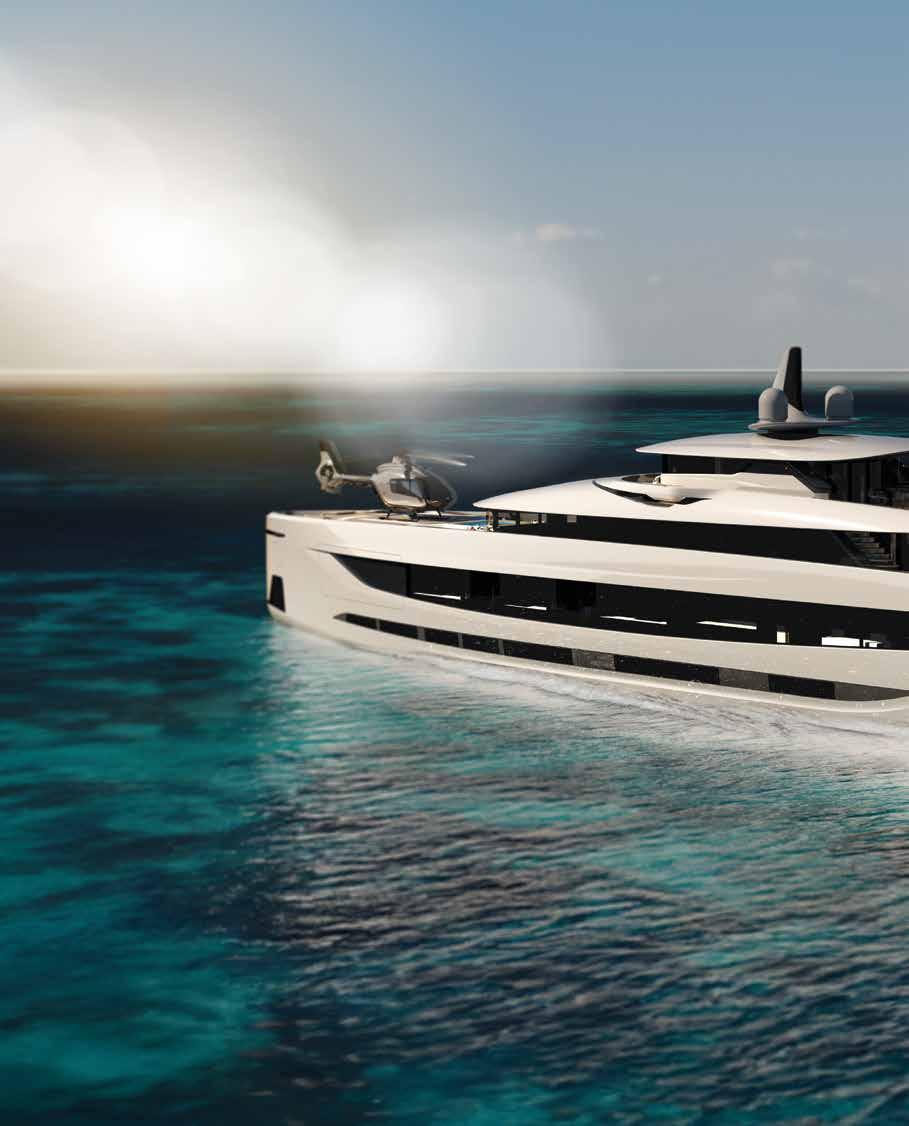
The 68m LIVIA is set to commence build at Turkish Shipyard RMK Yachts.
Featuring naval architecture, exterior design and an interior by Red Yacht Design, LIVIA stands to serve as a new icon of luxury. With sleek, sophisticated lines and world-class amenities, LIVIA promises to pair elegance with innovation. LIVIA has a visually striking and dynamic profile, meticulously crafted to provide aesthetic appeal and spacious, onboard living. Constructed in steel with an aluminium superstructure, LIVIA will deliver durability in an efficient, lightweight form. With a beam of 10.9 metres, LIVIA will offer five guest cabins,
each with its own private terrace, and an owner’s suite that spans two decks and boasts both a private lounge and swimming pool. Other onboard amenities will include a touch-and-go helipad, beach club, sun deck, sauna, and a gym.
Fatih Surekli, Managing Director of Red Yacht Design comments, “We are thrilled to bring LIVIA to life with RMK Yachts. Our focus was to create a design that not only captures attention but also enhances the onboard experience for owners and guests. Every detail was crafted with elegance and function in mind.”
https://redyachtdesign.com



Baglietto, specialists in the construction of new planing aluminium yachts and steel & aluminium semi-displacement megayachts ranging between 35 and 65 metres in length, has recently announced the sale of a new 56m custom project in steel and aluminium, designed by Enrico Gobbi – Team for Design. “The owner of this new project contacted us with very clear ideas about the design and technical performance he was looking for, and he found in our shipyard the best partner to make his dreams come true”, says Fabio Ermetto, Baglietto Chief Commercial Officer. “This new fully custom motor yacht is further
proof of Baglietto’s ability to satisfy its clients’ demand for uniqueness and demonstrates the shipyard’s great flexibility and ability to meet all clients’ needs”. The interior will be by Enrico Gobbi in partnership with designer Carlo Lionetti. The layout includes a master suite on the upper deck with the owner’s private outdoor area facing forward. A gym with spa area on the lower deck is directly connected to an aft large stern platform including a pool flush with the deck. Two Caterpillar 3512E 2,549hp engines will power the yacht, giving a top speed of 16.5 knots and a comfortable range of 4,500 nautical miles. www.baglietto.com



Columbus Yachts has announced the sale of the first 47-metre Crossover to a European client. Designed to be built in steel with aluminium superstructures, its maximum beam is 8.60 m and it will have a 3 m maximum draught. The exterior lines are by the Hydro Tec studio, which handled naval engineering together with the shipyard, whilst the interiors are by Hot Lab. It boasts a perfectly optimized, proven naval platform that already forms the basis of another 42-meter model under construction. The Columbus Crossover 47 is a perfect example of flexibility and functionality, designed to maximize on-board
comfort and enhance every space. The stern, equipped to accommodate a tender weighing up to 3000 kg, can be transformed into an oasis for relaxation, with a Jacuzzi, sunbathing area and direct access to the sea, with folding gunwales that expand the usable surface area. The exterior is characterized by modern, muscular shapes, with the concentration of volumes in the bow area, a typical feature of explorers. The layout is designed to accommodate up to 12 people, with four cabins positioned below deck and a full-beam master cabin on the main deck. The yacht will be delivered in 2027. www.columbusyachts.it



recently presented ULTIMA 111, its latest ultramodern catamaran with a length of 36.25m that emphasizes both elegance and sustainability. It is a luxury vessel which showcases a unique design collaboration with the Phathom Studio. Key design elements include an open-concept layout with guest accommodations positioned above the hulls for panoramic views, high ceilings and generous glass surfaces that enhance openness and connectivity, and biophilic design principles that incorporate organic curves and soft minimalism to foster a calming environment.
The interiors of the Ultima 111 are characterized by a modern aesthetic that balances boldness with serenity. A sophisticated palette of earthy tones and natural materials creates a warm, inviting atmosphere throughout the yacht. The owner’s stateroom features a private terrace with direct access to the foredeck, while the main salon boasts fold-out balconies that transform the dining area into an open-air delight. The layout accommodates up to 10 guests across five spacious staterooms. sunreef-catamarans.com


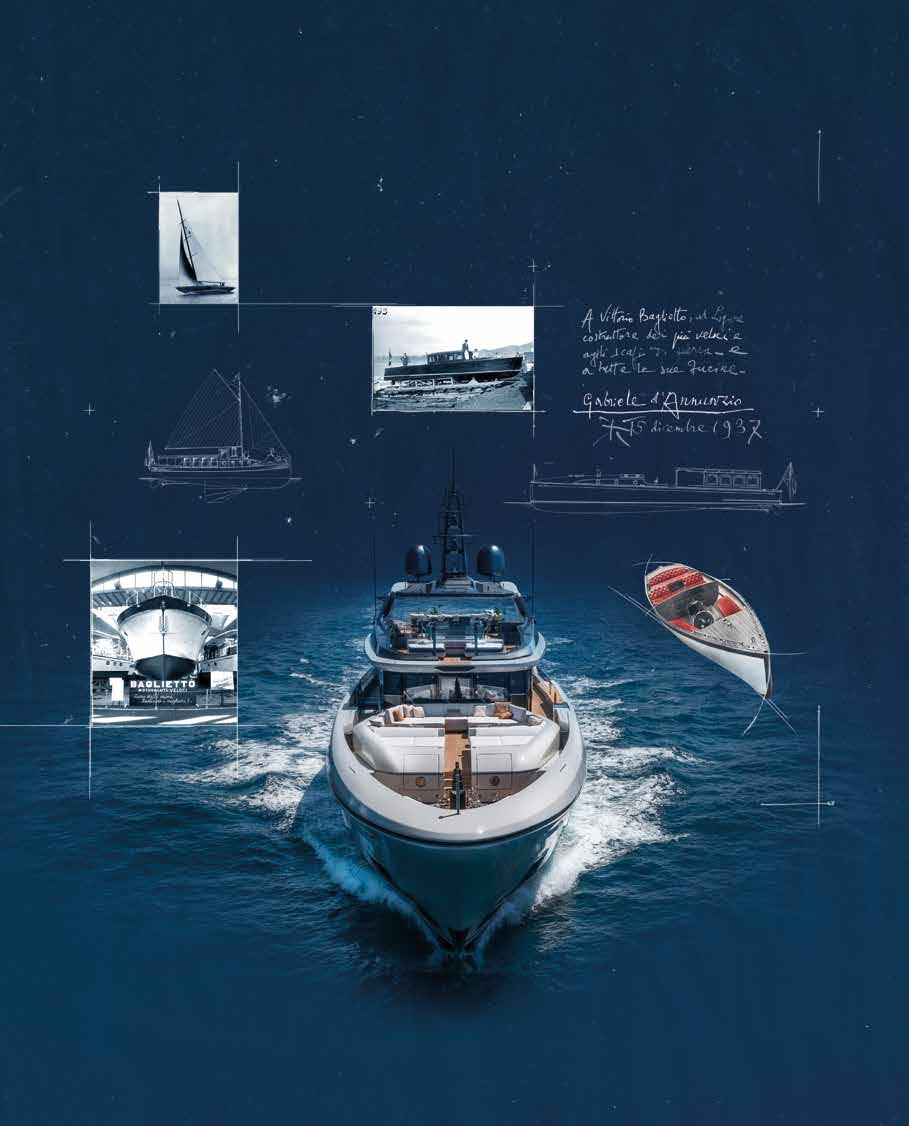
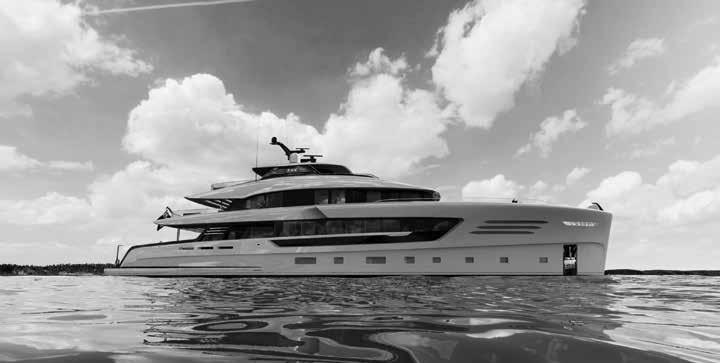

Project Triple X is currently under construction at Alia Yachts in Turkey. It spans the full range of Vripack’s holistic design disciplines and taps into the studio’s long-held reputation for creating some of the most accomplished explorer vessels on water. The American clients are experienced yacht owners who have chosen to embark on their first full custom yacht build. Project Triple X is also their first explorer, represented by the ‘X’ in the name. “The client’s wish is to explore the world with no limitations. They wanted a boat that would deliver on that dream and not hold them back,” says Marnix Hoekstra, co-creative director of Vripack. “They asked for a sexy, sporty explorer, capable of going through ice, adaptable in hot climates and super comfortable at sea.” The designers started with a 40m platform before lengthening the yacht to 43m to accommodate all of the owner’s wishes such as a walk-in closet and large bathroom. Other design fundamentals include an owner’s apartment conceived for a live-aboard owner, with a separate office, as well as a spectacular private deck area. Four guest suites are found on the lower deck. vripack.com



Superyachts is an innovative new yachting brand launched at the most recent Fort Lauderdale International Boat Show. It unveiled an ambitious range of 24 to 56-metre (78-164 ft) aluminium yachts that combine high levels of luxury with respect for the planet. The first 42-metre (138ft) model is already under construction. GX Superyachts is the brainchild of the team behind Greenline Yachts, which has been producing efficient hybrid yachts up to 58 feet for more than 15 years. Taking that experience of cutting-edge hybrid propulsion, smart hull design and solar charging, they have taken the next step by setting their
sights on the superyacht sector. The result is a line-up of yachts with a seductive design and extraordinary comfort. And yet the new brand fully embraces Greenline’s core principle of responsible yachting. They will set a new benchmark in environmental performance, centred on Greenline’s unique serial hybrid drive and powerful solar arrays, which form part of the structure of the yacht. Designer Marco Casali is responsible both for the beautifully sleek exterior lines of the new range and the interior, conceived in coherence with the exteriors. The GX42 is due for delivery in the summer of 2026. gx-superyachts.com
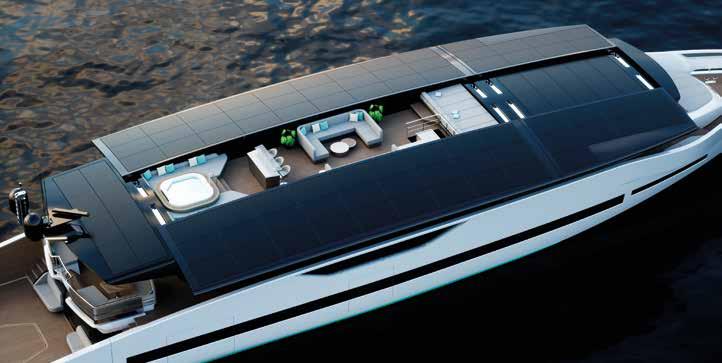

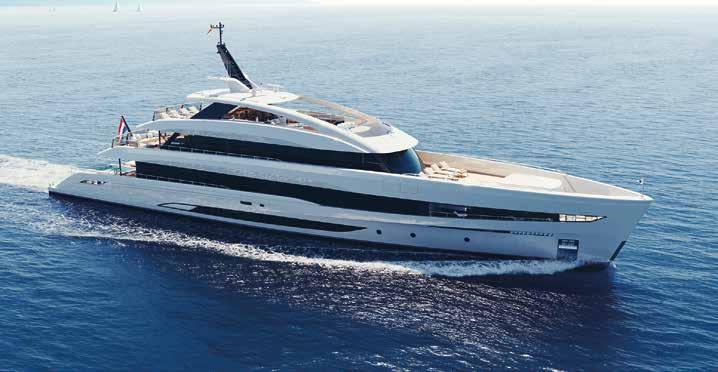
Yachts has announced the keel laying of Project Grace, a 50m Steel FDHF, the first in the new 50-metre series. To create this new 50-metre Steel Series Heesen chose a holistic approach and enlisted British studio Harrison Eidsgaard for the exterior and interior design. With a displacement of 99 GT, this yacht features a fast displacement steel hull for extraordinary seaworthiness and optimal comfort in all sea conditions. The design allows for the optional installation of Heesen’s hybrid solutions for intelligent power management and silent cruise capability, seamlessly blending luxury and sustainability. Comments

Peder Eidsgaard. “In keeping with the company’s DNA, the design of Heesen’s 50-metre translates the fast and sporty look of the aluminium yachts into a dynamic, agile form. The profile is refined and timeless. Full-height windows and the absence of fashion plates maximize natural light, enhancing the connection between the interiors and the outdoors. The layout is designed for both guest comfort and crew efficiency, featuring separate crew routing for discreet service and ample hidden storage for tenders and toys on the main deck forward. Project Grace is available for sale, with delivery in 2027. www.heesenyachts.com

by Désirée Sormani
Azimut|Benetti Group and Ogyre sign a partnership aimed at collecting and recovering plastic from the seas in three continents. And develop a waste collection hub in Tuscany
According to the WWF report “Out of the Plastic Trap: Saving the Mediterranean from Plastic Pollution” (2018), with 1.25 million microplastics per square kilometre the Mediterranean hosts a density of microplastics four times higher than that of the famous Pacific plastic island. With reference to this argument and in line with its commitment to sustainability, the Azimut|Benetti Group, has recently signed an agreement to support Ogyre platform in their campaigns to collect plastic from the sea. The target is 18,000 pounds of plastic in 2025 through the work of local fishing communities; at the same time, the two partners will jointly launch a feasibility study for the opening of a new hub in Tuscany where Ogyre will be able to operate in the collection of marine waste, involving institutions and the community.
For over twenty years, Azimut|Benetti Group has led the yacht industry in the development and implementation of solutions to reduce the CO2 emissions of yachts, achieving the best

Ogyre collaborates with local fishing communities, providing them with equipment, logistical support, training and financial compensation to carry out the Fishing for Litter activity
results in the field. Now, a growing awareness of plastic waste in the seas has encouraged the company to sign this partnership in order to make a practical contribution to the drive to clean and protect ocean ecosystems. The waste collection will be concentrated in three countries: Italy, Brazil and Indonesia, symbols of the profound relationship between man and the natural ecosystem and which, for various reasons, are seriously impacted by pollution. In particular, Italy overlooks the Mediterranean, a
semi-closed sea that is thus more vulnerable to plastic accumulation. Brazil and Indonesia, on the other hand, face a critical situation linked to the presence of highly contaminated rivers, which transport large quantities of waste to the sea, seriously compromising the ecosystem. Through its business Ogyre collaborates with local fishing communities, providing them with equipment, logistical support, training and financial compensation to enable them to carry out Fishing for Litter activity.

AnewMareterra eco-district was inaugurated by H.S.H. Prince Albert II of Monaco. More than 300 companies and 4,000 people were mobilised for the sustainable creation of a six-hectare addition to the Principality of Monaco.
It is the result of Valode & Pistre Architects and Renzo Piano Building Workshop, with landscape design by Michel Desvigne. Entirely pedestrianised, almost half of the extension is made up of airy public spaces that are open to all with a one-hectare park,
MarinaIbiza has promoted the Marine Forum. This annual event, a key encounter for experts and lovers of the sea, addressed crucial issues such as the conservation of Posidonia, environmental education, and ocean conservation.

“In this sixth edition, we talked about the effective protection of the ocean, and we asked all institutions, companies, public authorities and islanders to join in with this initiative. What’s more, we showcased some projects to regenerate our waters and our coastline”, said

a promenade punctuated with places for rest and meditation, a 16-berth marina, and shops, creating a new location for Monegasques and visitors alike. As a pioneering project that creates a blueprint for eco-design and construction on water, Bouygues Travaux has delivered a new global standard in civil engineering. The 18 submerged caissons which delimit the district were designed to encourage colonisation by marine fauna and flora. Under the structure, the installation of corridors and habitats foster and cultivate marine life, with special grooving on the caissons that facilitates the attachment of algae, and the establishment of artificial seagrass beds protecting local species. The Monegasque Government used Mareterra’s feedback to establish an eco-design guide applicable to its future maritime developments around the world, creating a world first.
Antonio Martínez Beneyto, Coordinator of the Marine Forum. To mark the twenty-fifth anniversary of UNESCO’s listing of Posidonia as a World Heritage Site, the forum paid particular attention to this marine plant, vital to the health of the Mediterranean. Renowned experts shared their knowledge and experience, providing an insight into the challenges and opportunities concerning the sea. “The companies and entities in the Forum’s promotion team have mapped out a course of action that involves bringing expert voices to this event to analyse the situation of our sea and propose ideas that would benefit it. Our audience is global and inclusive because we understand that the entire Balearic society should know about what’s happening to our sea, which is a source of life and progress for these islands”, said Martínez Beneyto.
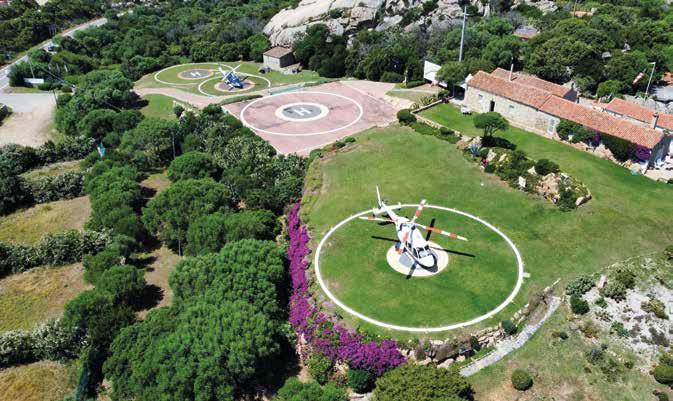




Grand Soleil Yachts, a name synonymous with quality and innovation in sailing for over 50 years, announce the Grand Soleil Blue at Boot Düsseldorf. This new project embodies the commitment of Grand Soleil Yachts
and Cantiere del Pardo to sustainability and respect for the marine environment, marking an important development in eco-friendly yacht building.
The GS Blue is the product of a dynamic collaboration between the yard and nautical experts Matteo Polli (Naval Architecture) and Nauta Design (Exterior Design, Interior Design, and G.A.), alongside leaders in sustainable materials like NL Comp.
The 10-metre Grand Soleil Blue accommodates up to four people overnight, providing a zero-impact sailing experience. At the end of its life cycle the boat is
entirely recyclable. In fact, the choice of construction material - a thermoplastic resin - combined with a smart design approach allows easy separation of boat accessories and components. The GS Blue will be equipped with an 8 kW, 48V lithium battery bank which can be recharged in 7.2 hours, with a 6 kW electric motor and solar panels. The latter enable renewable energy autonomy by recharging the battery bank powering the electric motor and supporting onboard services. In line with the project’s emphasis on sustainability, the sails are made from thermoplastic materials, leading to further reductions in environmental impact.

The Sialia 45 electric cruiser is winner of the 2024 Gustave Trouvé Awards for excellence in electric boats and boating, in the ‘Electric Boats Over 8m / 26ft In Production’ category. The Gustave Trouvé Awards for Excellence in Electric
Boats and Boating were created to recognize the inventors, designers, manufacturers, entrepreneurs and visionaries who are making advances every day to develop clean, quiet, zero emission technologies and designs to reduce reliance on fossil
fuel for marine propulsion. The prize is in honour of Gustave Trouvé, a prolific French inventor with over 75 patents.
The Sialia 45 emerged as the top choice in its category, receiving the highest number of votes from the judges. It is a full-electric cruiser with 43 knots max speed and the largest range in its class. The entire design and production methodology has been developed with lifecycle in mind. At a cruising speed of 25 knots, the standard 500kWh battery pack offers a range of 55 nautical miles, or 77 miles with the optional 200kWh endurance battery pack, which becomes 164 nautical miles with the use of the Range Extender (Rex). This year, more than 150 boats were entered into the Gustave Trouvé Awards, with over 6,000 people from around the world casting their votes. The International Panel, comprising 32 electric boat experts, contributed votes weighted at a ratio of 3:1 in the final tally.
The new executive office and hospitality spaces in the Superyacht Yard of the Ferretti Yard’s multi-brand pole in Ancona cover a multi-floor area of around 4,200 square metres. The new premises embody a corporate identity that combines aesthetics, functionality and sustainability. This is where all the superand megayachts from 30 to 90 metres in length are built by the group’s brands (CRN, Custom Line, Riva Superyacht Division and Pershing). The building is designed to make the yard immediately recognisable. Its imposing form welcomes clients, who immediately feel immersed in the excellence of the group’s brands.
The cutting-edge architecture of the building, part of the yard’s redevelopment project, expresses the group’s links with the city – an in-depth study of local colours and the character of the region was carried out as part of its development. The interior design emphasises total personalisation of the spaces – metal, glass, leather, wood and select marbles define surface and furnishing details. Seven hundred square metres of Travertino marble from the Tivoli quarries were used for the floors and stairs, while fifty square metres of textured Crema d’Orcia was used for the wall panelling. Intense care was dedicated to comfort and sustainability in the

The Ferretti Group Superyacht Yard uses renewable energy generated by a series of solar panels and the yard’s tri-generation system. A solar plant has also been installed for producing electricity

workplace – this involved the installation of latest-generation systems for managing climate control, heating and ventilation, as well as cutting-edge workstations and video-conferencing rooms. Light and air create greater sensory quality and natural lighting, also providing wide vistas of the surrounding landscape, enhancing the psychological well-being of those using the building. The lighting throughout the structure is managed by an astronomical timing system - all the lights switch on and off together, thanks to technology that tracks dawn and dusk times for the geographical coordinates, while part of the nocturnal lighting has been specially developed. Some time ago CRN launched an initiative aimed at minimising the environmental impact of its production operations and its yachts. Sustainability starts with the yachts’ distinctive quality and excellence – the group’s research and development concentrates on using highperformance, sustainable materials and reducing energy consumption.
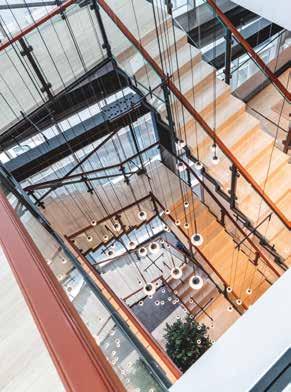

Elevators with sinuous shapes and attractive design are the perfect solution to luxurious, exclusive settings. The use of valuable materials combined with modern high technologies can meet the most particular needs in terms of space and design.
Personalization and customisation is our must.
A particular attention is paid to norms and regulations in force in the elevator industry as well as to materials and their treatment in order to make them suitable for installation and functioning into a marine environment.



Bertazzoni Servizi S.r.l.
Powered by
Via Frassina, 65 Loc. Avenza - 54033 Carrara- ltaly T. +39 0585 791727- F. +39 0585 791728 www.bertazzoniascensori.com info@bertazzoniascensori.com
I.C.M. S.r.l. - Lift Marine Components Via Kempten, 12 - 38121 Trento- ltaly T. +39 0461 960648- F. +39 0461 991165 www.icmlift.com info@icmlift.com

With the new year comes a clear desire for the reassurance and naturalness that is exerting such a growing influence on furnishings and interior design. Perfect on board, too!
by Veronica Lempi

Above, Some of Us by Gaetano Pesce, a piece from the Edizioni del Pesce collection, reinterpreted by Meritalia. In this collection, designer objects go beyond mere functionality to become daring declarations
The year 2025 brings with it an increasing desire for comforting surroundings, a tendency that’s revealed by ‘Mocha Mousse’, the Colour of the Year chosen by industry arbiters the Pantone Institute. This warm, subtle brown recalls soft plaids and luscious chocolate whirls, expressing an affinity with nature, a connection with the most genuine aspect of the world, combined with an irresistible desire for safety and comfort. The result is space for furnishings that appeal to the eye and the spirit. Geometric patterns also make a comeback in 2025, decorating fabrics and surfaces and becoming a furnishing complement in their own rite, expressing a fascinating rigour that can provide some striking special effects.
Below, Uragano by Natuzzi celebrates the natural richness of the Puglia region. The oval glass surface rests on a majestic olive wood base that unfolds in the space like an ancient tree


Above, the soft lines of the Imam dressing table by Roberto Cavalli Home Interiors, with integrated mirror and LED lighting. The piece is covered in sand colour Touch leather. The interiors are in beige RC Wild Jaguar velvet
Opposite page, Meta by Stilnovo is a table lamp designed in the 1970s featuring clean, simple lines. A timeless icon that embodies all the elegance of Italian design
Right, the first exclusive Diviana flagship store in Milan, at Via Monte di Pietà13/1. The Indian brand founded by Kapil Chopra makes its debut in Europe with the aim of transcending the confines of luxury furnishing on a global scale

Above, the Amelie padded chair designed by the Spanish Yonoh studio for Nube Italia has an organic shape with rounded forms. The slightly reclined back provides reassuring and embracing support

Below, the Plus sofa designed by Francesco Rota in 2017 for Lapalma is enhanced by three new modular configurations, S, V or U shaped to create soft, versatile layout solutions

Below, the retro appeal of the Rotunda TV unit by Etro Home Interiors, with vintage curved shapes given a modern reinterpretation. Simple and functional, it is made of wood with an Arnica top

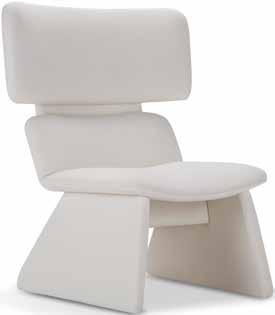
Above, the Nubia chair designed by Debonademeo Studio for Adrenalina challenges convention with a formal shape that seems to come from the future. The elements are connected without mechanical forcing
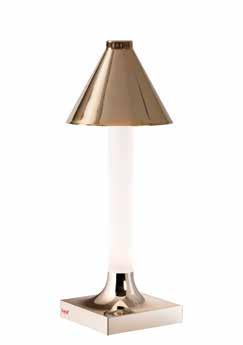
Above, designed by Philippe Starck, Goodnight Cap by Kartell is a “contemporary candle” with a technological twist. It is rechargeable and offers three levels of light intensity to create the desired atmosphere. The cap matches the base colours.
Right, the contemporary Doppler drawer unit by Gianfranco Ferré Home has a light structure with cylindrical cross-pieces and black lacquered finish. The three functional drawers are lined with microfibre
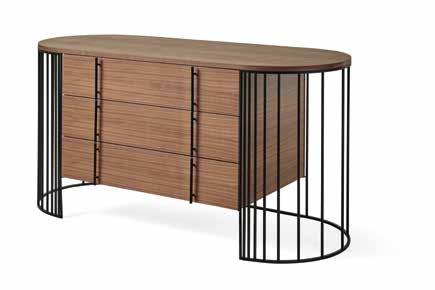
Below, the welcoming Abbracci modular sofa designed by Lorenza Bozzoli for Ghidini1961 evokes memories of the muchloved conversation pits from the 1960s and 70s. It is wrapped in soft nubuck leather with a brass tube at the base

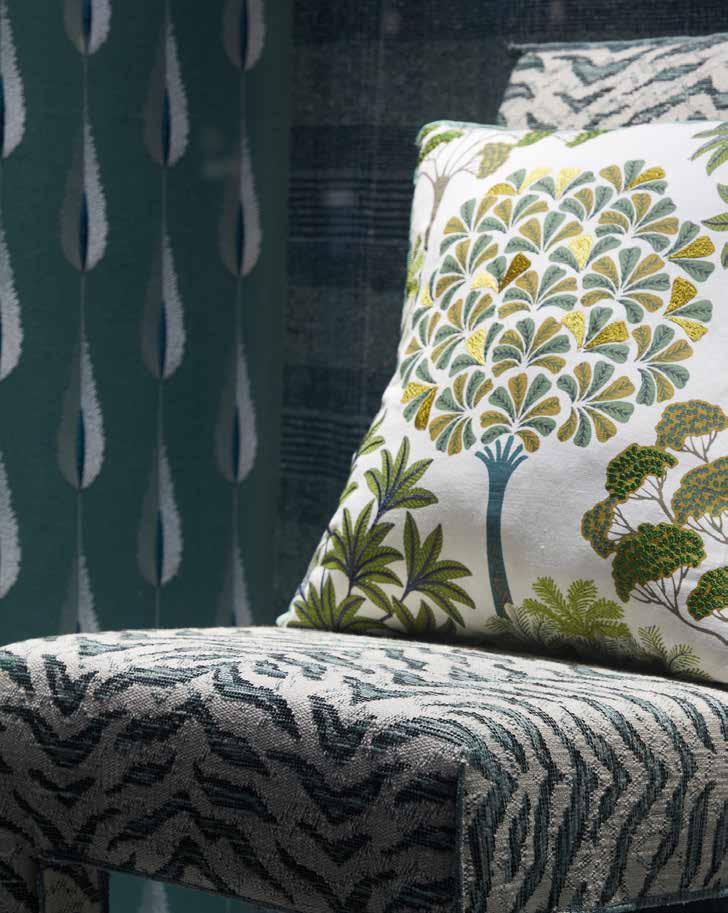
One of the display windows at Colefax&Fowler in Via Palermo, Milan, featuring pieces by Gervasoni “dressed” with fabrics by C&F brands, including Jane Churchill, Larsen and Manuel Canovas. The elegance of the Italian brand meets the excellence of British fabrics. Every window display, by the Beatrice Rossetti Studio, offers a play of textures, flowers, geometries and velvets. Photo, the Ghost chair by Paola Navone, upholstered in Jane Churchill fabrics

To side, the Artistic Surfaces decorative panels by Londonart furnish like works of art. Created by art designer Alex Turco, they are special because they can be placed in any setting, including wet areas and exterior walls. Photo, Black Poison - Underwater collection

The Syren Frag chair designed by Oscar and Gabriele Buratti is soft, extremely light and redefines the characteristics of hyper-smart contemporary rigour. Seat, arms and back comprise voluminous outsize cushions
The Dune vases by Barovier&Toso celebrate nature in a symphony of shapes and textures that tell the story of wind and sand through the language of glass. The product of skill and patience, each vase has an unrepeatable handworked chanelled surface


Crisp geometries and limitless charisma for the daring Crudelia chair by Paolo Castelli. Also available in a lighter version, it is a refined synthesis of artisanal tradition and cuttingedge design

steel and water inspire a unique design to shape an object of exceptional beauty


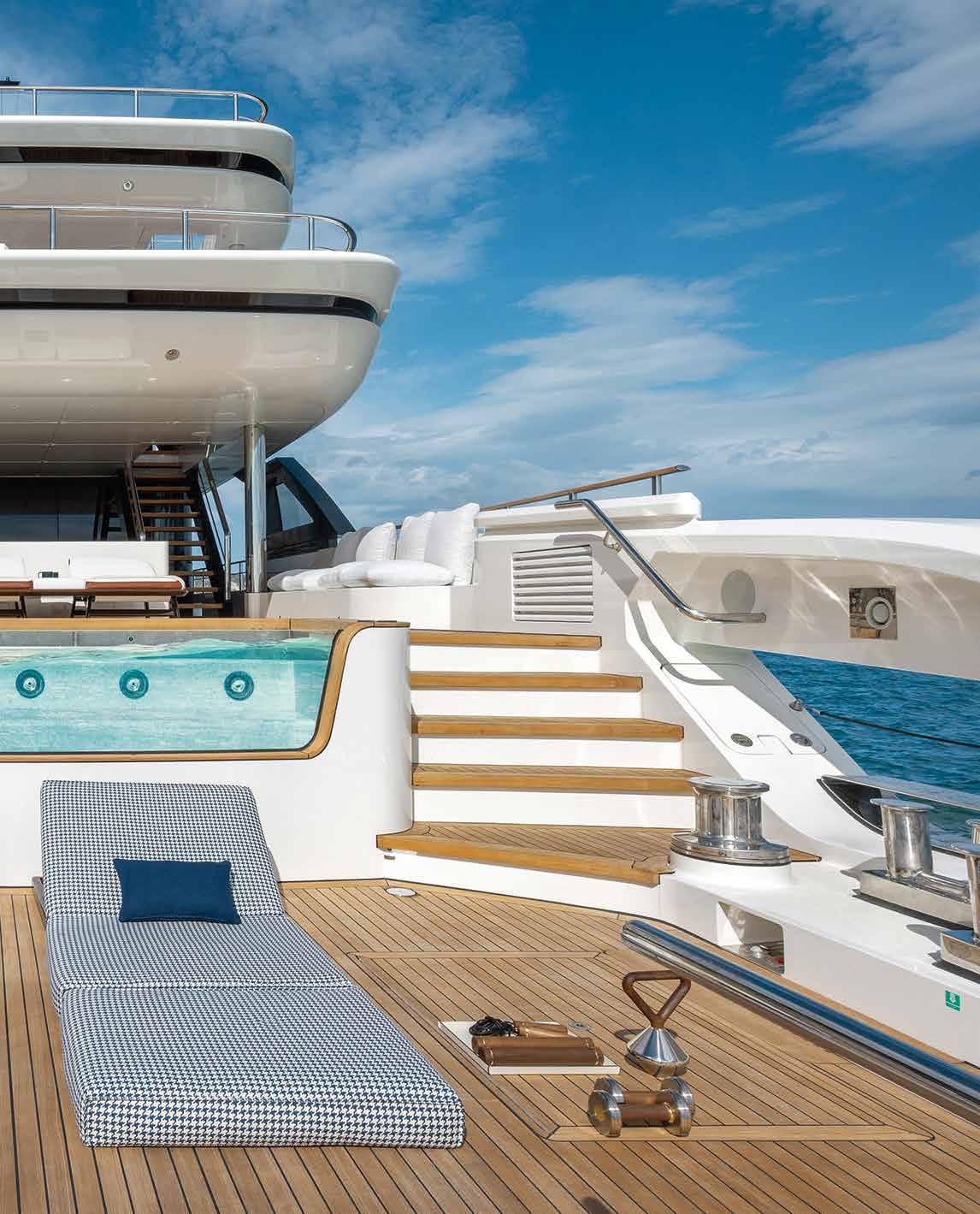
The owner and his comfort and privacy dictate the rules on board this 50-metre yacht designed by Salvetti and ACPV Architects Antonio Citterio Patricia Viel. The brand’s flagship is the Custom Line yard’s first allaluminium build
by Paola

pen to the sea yet with extraordinary respect for privacy. The Custom Line 50 is an ambitious yacht, created by a top-flight, highly experienced team - the Strategic Product Department and the Ferretti Group Superyacht Yard Engineering Department worked together with Filippo Salvetti for the exteriors and with the ACPV Architects Antonio Citterio Patricia Viel studio for the design architecture and interiors (the Custom Line Navetta 38 Telli is by the same lineup).
The project has strong aesthetic and technical values and generates a skilful equilibrium of yacht-building tradition, innovation and a search for total comfort, redefining the concept of functional luxury and bespoke design.
The brand’s flagship, the 50 is Custom Line’s first all-metal yacht – in aluminium, to be exact. With a length of 50 metres long and a 9.60-metre beam, it is laid out over four decks while remaining under 500 GT. It offers over 800 square metres of liveable space, 324 of which are outdoors.
The design’s key element is the owner’s suite in the bows – on the upper rather than main deck. This exclusive 75-square metre space is designed as large loft with a vibrant dialogue between interiors and exteriors. When the sliding doors aft are open, the suite, surrounded on three sides by floor-to-ceiling windows and reflective structural surfaces, integrates into a private terrace that is more of an interior space. Furnished with low tables and sun loungers, it is entirely screened from the gaze of guests and crew. In creating the Custom Line 50, one of the challenges overcome by the designers was to strike a balance between the sociability of the guest areas and the owner’s privacy. Both saloons (on the main and upper decks) blend seamlessly with the exterior spaces, creating relational spaces that interact in total harmony. On the main deck the sequence of saloon, cockpit and beach club create a single versatile lounge that takes guests from the most sheltered interior dining area out to the sea. An infinity pool links the cockpit and beach club, which thanks to a transformer ‘drawer’ opens out the stern to the sea when the yacht is at anchor.
The guests sleeping area is on the lowest deck, with two VIP cabins and two large guest cabins of between 17 and 20 square metres and a height of over two metres, while the uppermost deck, the sundeck, a generous and versatile 106 square metre relaxation area, is laid out with games table that can be configured according to requirements, a lounge, American bar with BBQ, sun area and hydromassage pool. This deck is sheltered by an extra-large hard top designed to integrate discreetly into the superstructure.
The interior colour palette displays neutral tones – the designers have favoured natural materials in warm, relaxing hues, like leather, walnut and limestone with no added colour. The materials have also been chosen for their sensory appeal. The three-dimensional treatment of the surfaces is one of this yacht’s hallmark features, expressed especially by the ridged finish on the walnut and limestone, which creates a continuum of surfaces between the living area and day head, cabins and bathrooms. Materials performance has also been considered – for the wallcovering in the stairwell, for example, the elegant three-dimensional designs are created using hot pressure on a decorative textile layer on a soft, sound-absorbent technical backing.
The sophisticated lift linking the upper, main and lower decks is camouflaged to blend into its setting – the door, like most of the walls, is in ridged oak.
The guest/crew flows have dedicated routings, and the sun deck has two methods of access – a staircase for guests aft and a hidden staircase built into the bar unit forward for the crew. www.customline-yacht.com
A classic, timeless design with clean, elegant lines largely read horizontally. The flagship of the displacement line and the first Custom Line yacht with aluminium superstructure and hull, it is 49.90 metres long and has a 9.60-metre beam. Opening, the extraordinary beach club and infinity pool separating it from the cockpit


Warm tones and embracing shapes for the interiors and exteriors. The freestanding furniture items were custom made for this yacht. The main saloon (above) features ridged oak panels on the walls, white Calacatta marble tops for the dining and side tables and leather pouffes. Below, the external upper deck dining area. To side, a detail of the cockpit on the main deck



Filippo Salvetti
The design of the Custom Line 50 is based on precise input from the yard specifying that the yacht should have extremely generous exterior spaces and large windows in the superstructure and hull. However, the strongest influence on the design was the requirement that the owner’s suite be on the upper deck. This solution can now be seen on some larger yachts 65 metres or more in length. It was a significant challenge. Moving the owner’s suite to the upper deck meant shifting the helm station to the main, or rather mezzanine, deck. To give them visibility we lowered the hull compared to how it would be on a traditional design. That was our starting point for developing the best solution and giving the yacht an essential, athletic style.
In its general lines the exterior design invites a horizontal reading of the volumes, a characteristic of the range and a feature that helps maintain an uncluttered style. The helm station’s location on the mezzanine inevitably means inserting some breaks, so we used shutters to help recreate the horizontal reading – if you half close your eyes the upper section of the bridge seems to integrate with the last section of the upper deck. Other key elements of the project are the soft, flowing surfaces, interrupted by some decisive signs. For example, we had to cut them off at the level of the owner’s suite to create a frame and highlight this location. From the point of view of design, the aluminium build


The exteriors comprise 324 square metres of liveable space, creating large terraces looking out over the sea. There are two pools on board, one on the main deck and the other on the sun deck. The highest deck (opposite page) has a series of freestanding elements that lend versatility to the space. It is sheltered by an extra-large hard top
restricted us in some ways. With fibre glass you’re free to create the shapes you want, but here we identified and used a series of shapes, of rays. It was very interesting to become involved with all this, and observing the skills displayed by the Custom Line workforce in creating and shaping the surfaces.
I love the sundeck. The huge t-top presented a challenge for the yard. It shelters around three quarters of the area, making this large space extremely liveable. At the centre the rather high sides and t-top create a protected space that opens to the sea forward and aft.
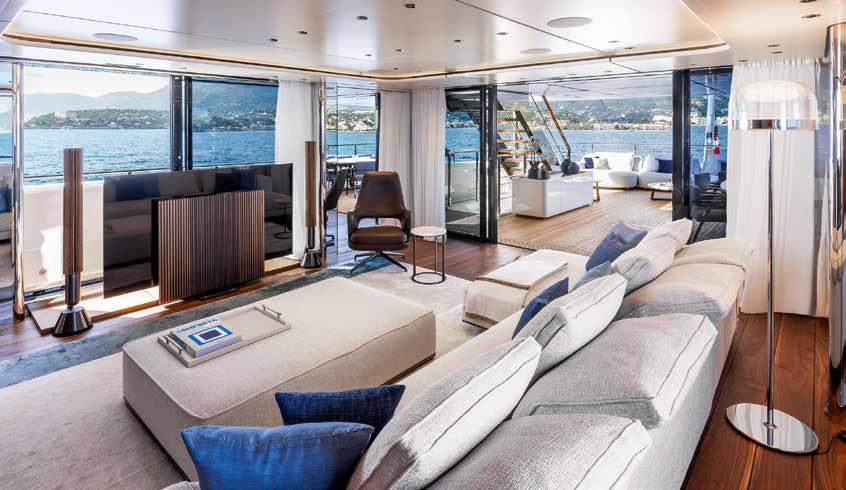


The lower deck (photo, bottom left and opposite page) hosts four guest cabins. Oak and leather finishes contrast with the light, bright wallpaper. The leather bed heads with visible stitching and pockets are particularly attractive. Note the stair rail with interwoven, tennis racquet-style leather covering. Above, the upper deck sky lounge with large openings onto the exterior.
In the context of Yacht Design we pay a lot of attention to the yacht’s surroundings, the sea and natural light. Inspired by an intense passion for the sea, through a pragmatic, measured approach, we work to enhance the sailing experience. We’re not trying to design floating luxury apartments – we think of yachts as a habitation solution where the context is the sea. Our yachts are examples of naval architecture designed for a life that harmonises with the sea. The intrinsic elements of the yacht, its objective physical characteristics and the perceptual and subjective aspects play a key role in the naval design. The classic, “nautical” curved lines of the furniture, customised furnishings, the window shapes and the frames of the interior doors, the soft edges of the spaces together with the skilful use of solid teak and exceptional cabinetry details embody nautical traditions that are interpreted in a contemporary style.
The distinctive recurring characteristic of this interior design project is the full-height windows. Combined with the mirrored surfaces, used to mask the structures and the yacht’s opaque sections, they create visibly permeable spaces that dialogue with the surroundings. The main deck living area, a light-filled glass box whose angles aft are soft and rounded, is entirely transparent, with a graceful absence of solidity. The solution involving lightening the shell around the interior spaces inevitably meant concentrating on the material in the more internal spaces, where there is less natural light. This focus on materials translates into the creation of refined details, warm, tactile surfaces like Crema d’Orcia stone and skilful configuration of the distributive spaces. The details are specially designed for every project, as are the surface treatments like the fluted walnut for the panelling, the tiled texture of the bathroom stonework and the handles.
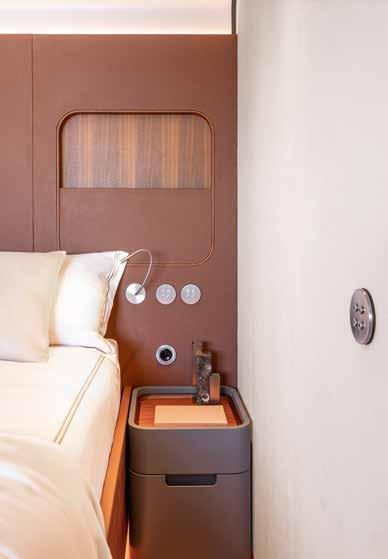


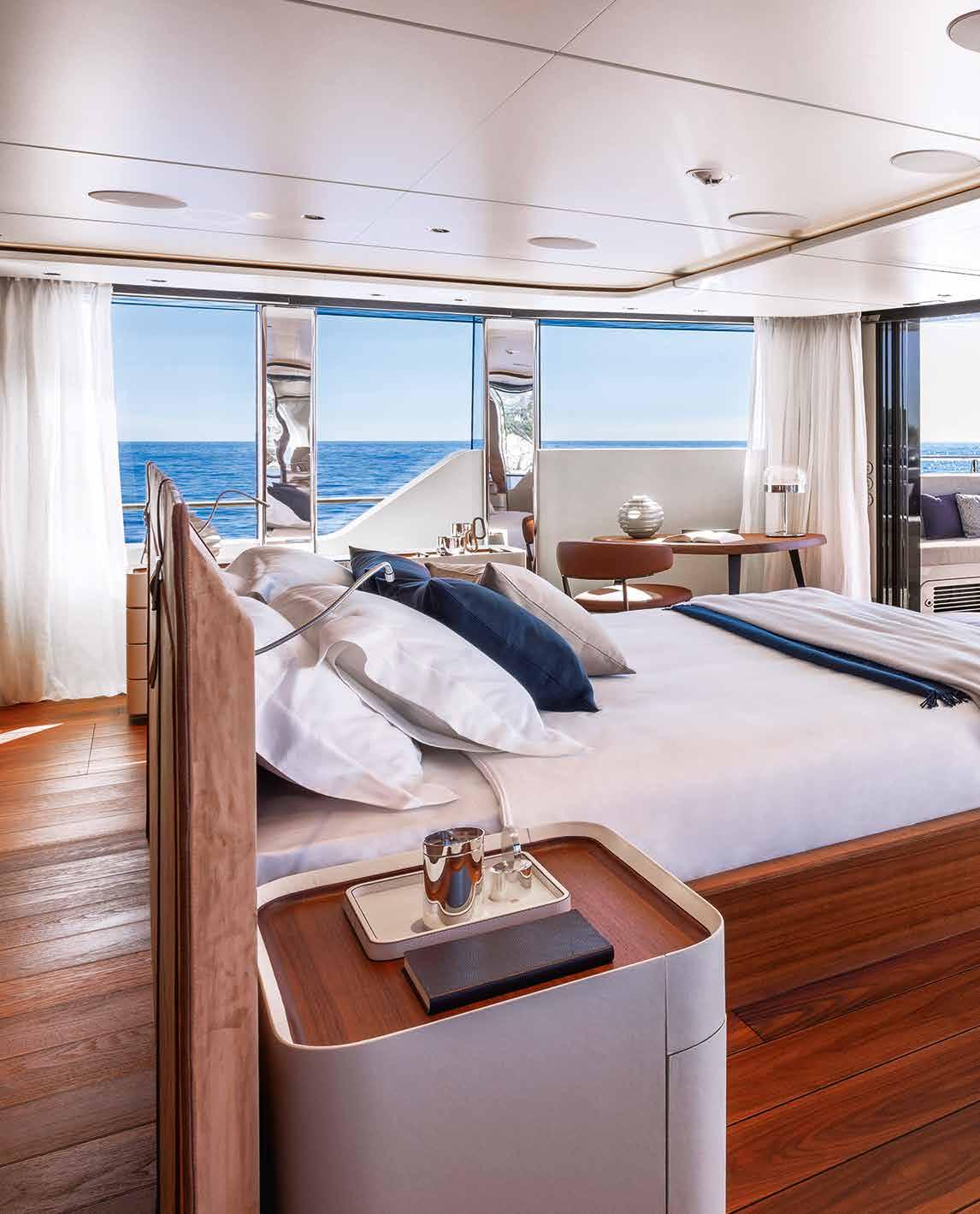

The owner’s suite, a comfortable, private space, is one of the yacht’s dominant features. Located on the upper deck, it is designed as a generous 75 square metre open space. The bed with a freestanding leather bed head is in the centre, facing the private terrace
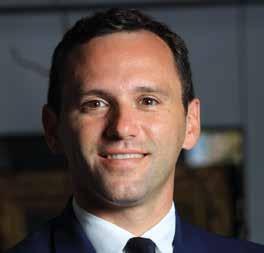
Equipped with two 1081 kW CAT engines, the Custom Line 50 can reach 46 knots. At its economical cruising speed of 10 knots it has a range of 4,500 miles. The yacht features an SCR (Selective Catalytic Reduction) system, which provides a 70% reduction in NOX and is IMO Tier III certified
The Custom Line 50 is a unique craft, an exclusive product with features normally only found on larger yachts, like the full-beam owner’s cabin on the upper deck with panoramic view and private balcony.
Its concept is based on the creation of a versatile, innovative yacht with a focus on spaces and functionality, designed to fulfil the requirements of a knowledgeable, sophisticated clientele – often families that spend long periods on board. This yacht combines comfort, personalisable design and technical solutions that provide a unique experience, like the shallow draught enabling the yacht to sail in waters like those around the Bahamas and space distribution that takes full advantage of all available volumes. It’s the first aluminium build from Custom Line, a choice driven by a desire to provide greater design and functional flexibility. Using aluminium means the yacht is lighter than it would be if built in fibreglass, leading to a shallower draught and enabling us to integrate advanced solutions like the full-beam owner’s cabin. Even though aluminium is costlier to work, the yard was able to draw on the experience of the Super Yacht Yard in Ancona, which specialises in this type of build, overcoming the technical and production challenges.
As well as introducing a deck that is entirely dedicated to the owner, a feature normally reserved for yachts over 60 metres in length, another distinctive element of the Custom Line 50 is the interconnection of the spaces. This is clear in the guest areas, especially the main and upper deck saloons, and it is emphasised by the extensive use of mirrored surfaces combined with the large curved windows designed especially for this yacht. The flowing continuity between the open-air spaces on the Custom Line 50 is best seen in the innovative two-level beach club. And the beach club is one of my favourite areas, nothing less than a seaside beach. The spectacular infinity pool’s large glass panel creates a visual continuity between the sea and the pool itself.
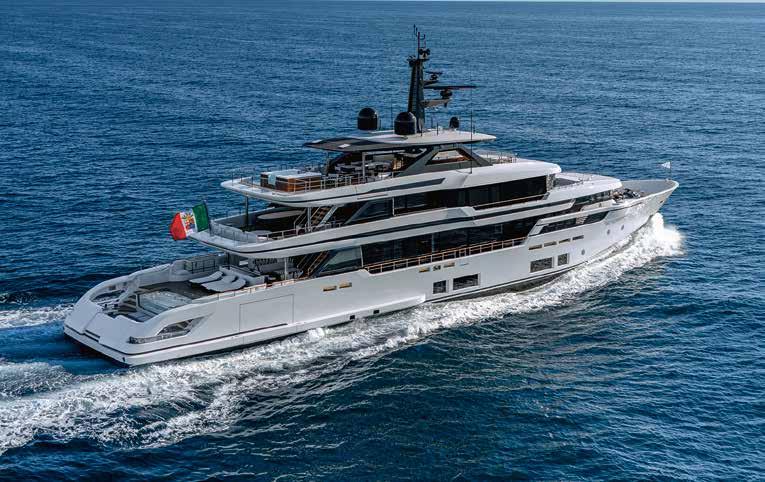
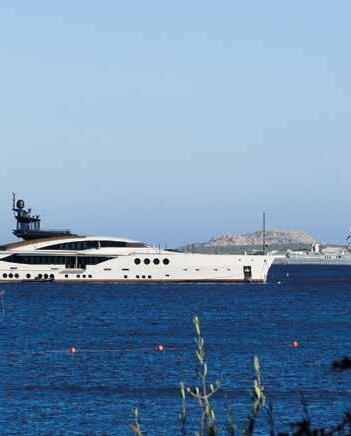


YACHT SELECTION UP TO 140 MT CHARTER SALES
NEW CONSTRUCTION
YACHT MANAGEMENT
CREW RECRUITMENT
WATER TOYS
CAR RENTAL: HYPERSPORT CARS ULTRA LUXURY
CHARGING INFRASTRUCTURE FOR ELECTRIC VEHICLES
LXRY1 SRLS, Piazzetta della Marina
07021 Porto Cervo (SS) Italy - 41°08’09’’N 9°31’39’’E mail: info@lxry1.com
Visit: lxry1.com LXRY1 lxryone
AIR TRANSFER
PRIVATE JETS
HELICOPTERS
AIR AMBULANCE
SALES ‹ ACQUISITION
NAT’L ‹ INT’L AIR TRANSFERS
24/7 BOOKING
SHORT-MID-LONG HAUL FLIGHTS
YACHT BROKER alessio.dangelo@lxry1.com

The Citation CJ4 Gen 3 in flight.
The latest version of this popular business jet is a response to demand from clients and operators, and includes features that, thanks to the extensive integration of onboard systems, facilitates Single Pilot and Owner Pilot flying
The Garmin Emergency Autoland function changes aviation forever, and business flyers will no longer have to worry if there’s only one pilot in the cockpit



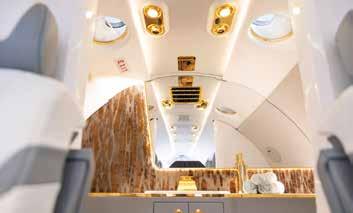
For some years now the Citation Jet Division of Cessna (part of the Textron group) has been updating America’s most famous and best-selling executive twin-engine jets. In this case, the CJ3 model, generation 3, presented in late October at the NBAA-BACE show in Las Vegas. Last year the M2 Gen 2 received the same update (The One Yacht&Design featured it) and now work is under way to bring the Cessna Citation CJ3, CJ4 and the M2 up to Gen3 standards. Press attention is focussed on the presence of the Garmin Emergency Autoland system, to be installed on all three of the new aircraft. As they are single pilot models, in the event of sudden pilot incapacity automatic landing can be initiated by pressing a single red button, an action that can be carried out by anyone in the aircraft. It’s not the first aircraft to feature this piece of electronic wizardry, but the Citations are the first business jets to offer it, making an irreversible contribution to the future of business aviation. However, I’m looking at the CJ3-Gen3 because during my career I’ve flown many hours on a CJ1 (Type C525) and the Bravo model (C560), very similar to the CJ3-Gen3, and I’ve always found it to be a simple, reliable aircraft, a real workhorse over the shorter routes typical of continental airspace. The bigger brother Citation CJ4 Gen3, which will be equipped with new Garmin G3000

These images: the Garmin 3000 avionics suite in the cockpit features an extensive use of touchscreens and Garmin Emergency Autoland technology (the red button in the warnings section of the upper MIP). The interiors with revamped materials and increased connectivity, without compromising the typical Citation range style. Finally, the new generation’s launch livery, for the first time in two colours
Prime avionics, is scheduled to enter service in 2026, while the M2 Gen3 and CJ3 Gen3 will follow in 2027. Anyone wishing to purchase one, though, will have to order it immediately, as the automated landing revolution will cause a significant rejig in corporate fleets. At Las Vegas Ron Draper, company president and CEO, said, “We’ve unveiled the future of flight and the next generation of light jets, continuing the iconic tradition of the Citation brand. With the inclusion of the revolutionary Garmin Emergency Autoland technology and the new Garmin G3000 Prime avionics, these aircraft will make it possible to enhance the flying experience and offer passengers and crew unequalled serenity”. Fortunately, the only time I experienced problems with the pilot was on a much less high-performance aircraft than the Citation, but the idea of falling ill at the controls has always been one of the worst imaginable scenarios.
The fuselage remains unaltered, apart from some changes in materials and interior styling, so the space is the same as on the Citation CJ range, with one model that differs significantly from the others in the length of the cabin and number of seats, from six to eleven. There is a minibar and bathroom, but of course we’re talking about small business jets and not the medium-large type preferred for longer flights. However, all three

new versions include fully-integrated Autothrottle for effortless management throughout the flight. The Runway Occupancy Awareness function provides better visibility of obstacles and potential runway incursions, while the Advanced 3D SafeTaxi displays runways and connections, offices and hangars, so the aircraft can move around safely whatever the level of visibility. The new CJ4 Gen3 should be included in the classification of the type C525, which means the pilots do not need to retrain. The screens are larger and the interactive slide-outs on the engine indication instruments facilitate access to settings. In general, the secondary displays are 40% larger than those of the previous versions and there are fewer buttons on the panels, making control easier. Passengers, owners and operators can enjoy a number of innovations like lithium-ion batteries, providing more power and increased reliability for more efficient operation in cold weather, new winglets with better lighting for an increased ramp presence and perfect integration of usage data in real time with the LinxUs system, which provides planning and maintenance support, reducing aircraft down times. Cabin acoustics are also improved, creating an exceptional experience for all on board, especially in the rear section, near the engines, and flight deck lighting has been enhanced in the areas where pilots need it most – in the side pockets, for example. Running costs for the Citation CJ4 Gen3 are expected to be almost 10%
lower than equivalent costs for its rivals, and the aircraft provides categoryleading range at all useful loads. It is predicted to have a range of 2,165 nautical miles and a maximum payload of 2,200 pounds. With seating for a maximum of 11 and a baggage capacity of 1,040 pounds. The CJ3 Gen3 will also offer the Enhanced Vision System (EVS) as an option, providing improved navigation, plus 4.5 inches of additional legroom for the pilots. The cabin is a personalisable space with revolving seats, RGB lighting and full connectivity, as well as a bathroom with natural light. Maximum range is 2,040 nautical miles with maximum payload of 2,135 pounds. With seating for a maximum of ten occupants and a load capacity of 1,000 pounds, the aircraft offers outstanding range of around 2,000 miles at a cruising speed of 770 km/h. It can operate from runways less than a kilometre in length, which in Italy means it can land at small airports like come Milano Bresso (LIMB) or Roma Urbe (LIRU), with landing strips 1,080 metres in length. In practice, the exciting new feature is the Garmin Autoland, an option that we hope will never be used but where single pilot flying is possible this system will offer peace of mind if passengers are told where the button is and how to operate it. The cost? It depends on specifications, but prospective buyers are looking at between six and eight million dollars. cessna.txtav.com
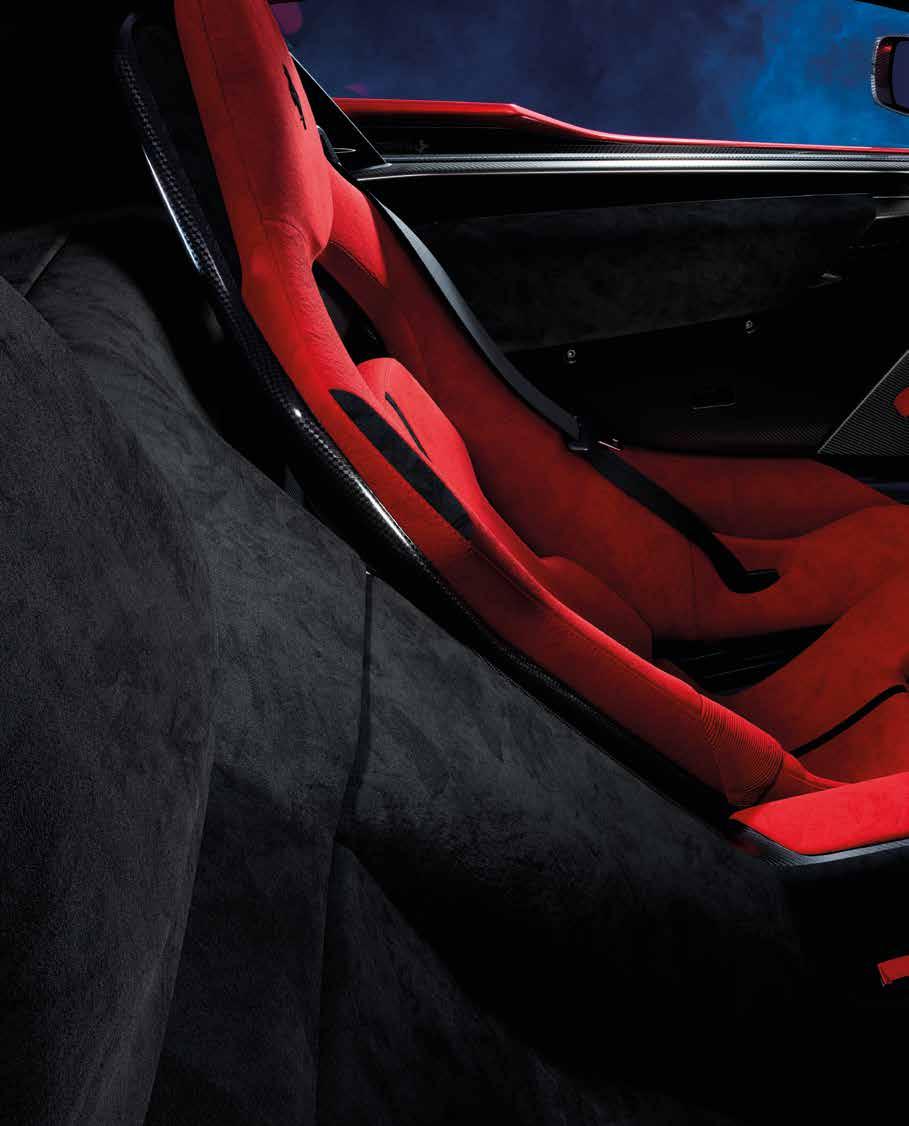

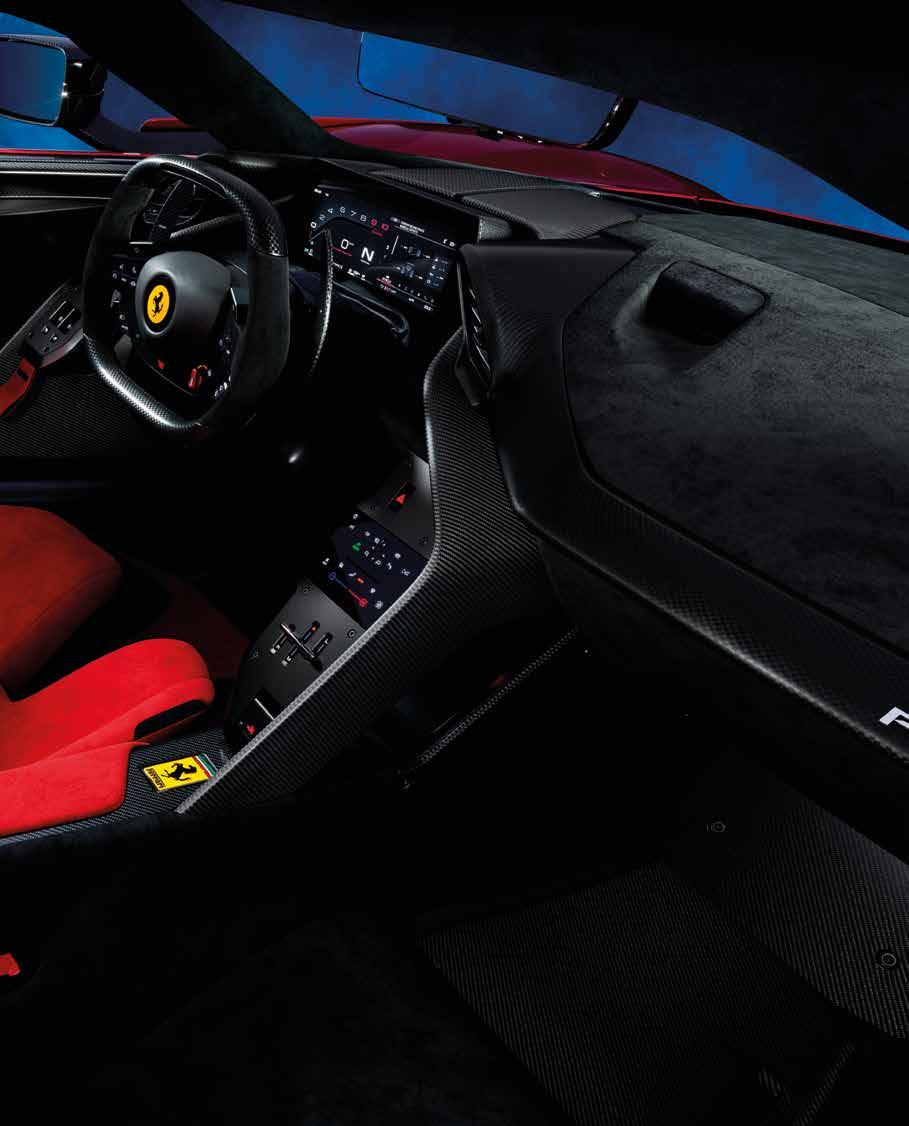
A dialogue between design, engineering, aerodynamics and ergonomics has inspired a narrative embodied by the F80, a limited-edition supercar that is the quintessence of Ferrari style and performance, a model that has immediately claimed its rightful place in the brand’s hall of fame
Enzo Ferrari was sure of one thing – in order to achieve commercial success a road car, even if its distinguished badge and limited manufacturing run already make it an exclusive purchase, must be produced in numbers that take into account market demand – less one. This visionary marketing strategy is designed to enhance the car’s desirability and stimulate competition among prospective buyers. Over the years this has enabled many models produced by the prancing horse brand to achieve outstanding success, becoming objects of desire that were sold out even before production began, valued among other things as rock-solid investments.
For the Maranello factory it’s a tradition of success involving such types as the GTO, F40, F50 and LaFerrari, cars that feature in every selfrespecting auto auction. We saw this recently with the F80, the latest classic from the Italian factory. Made in a run of 799 examples, they were all snapped up as soon as the model was announced, despite a list price of 3.5 million euro. The reason behind this is the status achieved by this type of object, comparable in every way to contemporary works of art and often
Below, the butterfly doors lift to an angle of almost 90°. Opposite page, from top, the Short tail has a movable rear wing, a crucial element in the F80’s adaptive aerodynamics system. An aerial view emphasises the design of the upper section, with the floating bubble effect of the cockpit
destined to become part of private collections, being transformed in this way from dynamic to static objects of admiration. As a result, talking about performance may not be appropriate for cars of this calibre. Reeling off impressive figures like the total of 1,200 hp put out by its four engines (a 3-litre V6 and three electric units, two at the front and one at the back), acceleration of 0-100 in 2.15 seconds, top speed of 350 km/h, self-limited, adds nothing significant to a supercar like the Ferrari F80, because it’s taken for granted that a Ferrari reaches peaks of performance, especially if







Above, the front with its futuristic design. Left, from top, a detail of the headlights, concealed inside a sort of black screen. The six slots acting as air vents, one per cylinder
it enters the restricted elite of the brand’s “fuori categoria” models. If the F80 belongs to another category it is rather because it forms the basis for the projects that recently led to the creation of the most modern F1 single-seaters as well as the sports prototype that has dominated the prestigious 24 Hours of Le Mans – and because it displays an aesthetic defined by Ferrari Styling Centre, led by Flavio Manzoni, discreetly embodying the genetic heritage of the most legendary Ferrari cars. Such lines are the result of a holistic approach that’s a blend of design, engineering, aerodynamics and ergonomics. ferrari.com
There are many reasons to choose Eccelsa Aviation for your trips to Sardinia
· State-of-the-art dedicated Business Executive Terminal
· Gateway to Costa Smeralda and Sardinia since 1963 *
· 3 km from the Marina of Olbia and 25 km from Porto Cervo
· Complete under the wing services for aircraft up to A340 and B747
· Tailored passenger services
· Full plannig for crew stay(s) at preferential rates
· Hangarage recovery
· Maintenance service in cooperation with Meridiana Maintenance
· Slot- and PPR-free landing and take-off **
· Great value-for-money services and easy payment methods
· Award-winning professional and experienced multi-language staff
However, you can forget about all of them. In fact, what you’ll really appreciate is how you will feel And that’s all the difference between simply landing and truly arriving.
So whatever your reason for visiting Sardinia, keep in mind you are always welcome to



by Désirée Sormani - ph. courtesy by Cassetta Yacht Designers

in 1983, is one of the most eclectic contemporary designers. His signature appears on numerous designs by such brands as
and
with over 80 designs already under his belt

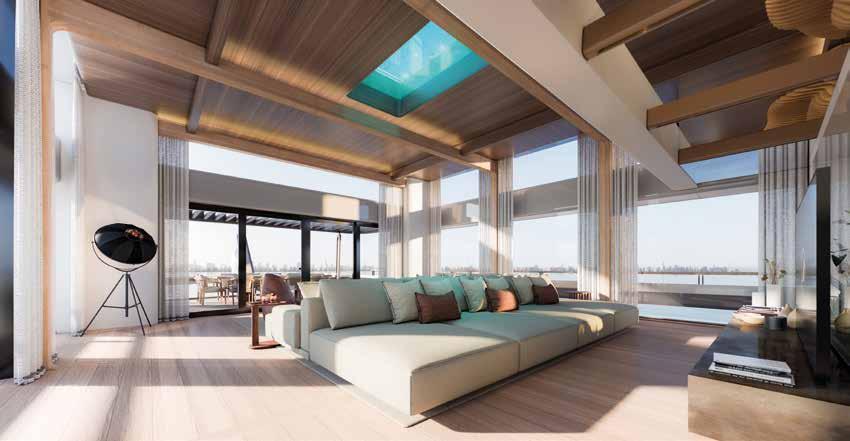
II have a degree in industrial design, but in reality I’m not a pure creative by nature – my first academic adventure began when I enrolled on a theoretical physics course”. We are a little confused at the beginning of our chat with Giorgio Maria Cassetta, one of the most eclectic designers of the moment, but things eventually became clearer. “My move to industrial design wasn’t the result of a disaffection for the subject, it was considered decision regarding my career path”. The Roman designer’s attitude to mathematical models and the abstract nature of physical systems may be regarded as the key to his future vision – not forgetting that calculation and research have close links to the field Cassetta now operates in. “My passion for designing yachts was something I carried inside me. I began designing them at nursery school and I’ve never stopped, so really I’ve just transformed a hobby into a career. After graduating, in 2013 Cassetta got down to business, joining the Zuccon International Project studio and then working with Andrea Vallicelli. He went on to open his own studio, designing a series of magnificent megayachts for Benetti. Two years later he began to build the team in Rome. “Our studio is growing. Everyone has their own seniority and experience, contributing to a shared pool of expertise that enables us to approach projects with a certain freedom and creative ability, offering an all-round service. Six months from now there will be three more of us, and in 2025 we’ll be celebrating our first ten years!”
Passion and work combine to achieve a single goal. “I’ve always designed yachts because I love the sea and everything involved with it, and I go sailing whenever I can. As designers of floating objects, we must make them safe and
These pages: B.Loft is the new project by Giorgio Maria Cassetta for Benetti. It brings a contemporary residential feel to a megayacht. B.Loft combines the volumes of a villa with the luminosity of a loft. The interiors are characterised by ceilings that are about four metres high. This new project also introduces a new feature, the “Cabana” on the lower deck (right, bottom), which redefines the beach club concept. This panoramic area provides a 270-degree view. Fold-down wings expand the space still further
aesthetically appealing. An ugly yacht is a crime against the environment – it’s like an eco-monster wallowing in the sea off the Sicilian coast”. But a good designer also adopts a global approach and knows how to question their beliefs. “When I opened my studio I sought to maintain our identity as yacht designers with a limited range of services to ensure quality. Then new opportunities came along and in 2017 the studio took its first tentative steps in yacht interior design (I also had experience in designing home interiors). Now we’ve carried out about thirty interior design projects for yachts between 30 and 80 metres in length”. And Cassetta has designed a hundred or so yachts over a period of only eleven years. The aspect that links them all is a close attention to proportions. “And clean lines. We’re very careful not to over-decorate, we avoid the use of elements that aren’t useful to the design. We’ve made classic motor yachts and hyper-modern yachts that are almost like spaceships, but I think that successful execution of the design means
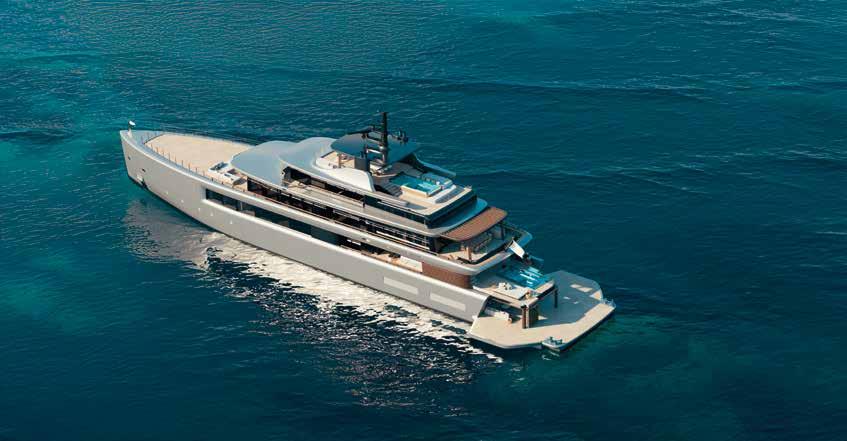


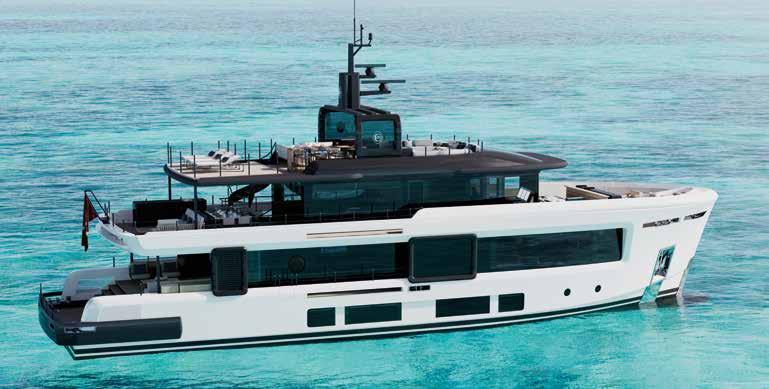
treating it with great dignity, and I think a good designer filters the information communicated to him by the owner. Real luxury comes from the work of the artisans, their know-how and manual skills, not from the materials. But I have one obession, independently of the style, language and colours chosen – to create interiors that where you can relax immediately”. Unique works, developed to reflect the style of yard and owner. “Otherwise it would be the designer celebrating him- or herself, which would be crazy. Successful yachts all have their own distinctive character”. Just like the BLoft for Benetti and Raw
for Cantiere delle Marche: two different yachts with a shared ratio. “With BLoft I wanted to reinvent the yacht. I know that sounds a little arrogant, but I thought, let’s make a spaceship, let’s evolve, try to leap forward twenty years. What is a yacht, basically? An instrument for using leisure time through the pleasure of the voyage and discovery. Objectively, the language of BLoft is different from the usual. Starting with the Cabana club, an evolution of the beach club and the heights in the loft area, and then the layout (deliberately still unveiled) where there’s everything you need, but it’s all integrated in an
These pages: RAW is an explorer yacht designed for Cantiere delle Marche.
The first model in the RAW series is a three-decker 105-footer (the firstone has been recently sold) with expansive outdoors and welcoming interiors.
RAW profile’s is imposing, characterized by a geometrical, contemporary aesthetic.
A high bow conceals tenders and water skis on the upper deck forward. RAW stands for R for Recreation, A for AllWeather, W for Watercraft

unusual way. Its underlying conception is based on how to ensure that guests stepping on board will immediately feel at ease”. The spirit of Raw by Cantiere delle Marche is not so different. “The yard wanted to create an entry level yacht and be competitive in the 30-meter segment of the market. But how can a model be new in a sector where CdM is the unquestionable leader? We’ll re-invent the wheel! We sought innovation on two fronts – from the point of view of layout, optimising centimetre by centimetre, and in the context of aesthetics we tried to create something
disruptive but beautiful. As I said before, a yacht has to be beautiful. We created a stylistic language that could become an identifying feature of this Explorer line. We achieved it through a mix of taut lines with full, sculpted curves and surfaces, a combination of “straight” and “curved” in the style of Kandinsky. The challenge was to find the perfect equilibrium of proportions. We also wanted to be playful, like the crow’s nest you access by climbing the vertical steps. Here you can observe the horizon or squabble with the seagulls. All in all, it was important for it to have a rather provocative element!”
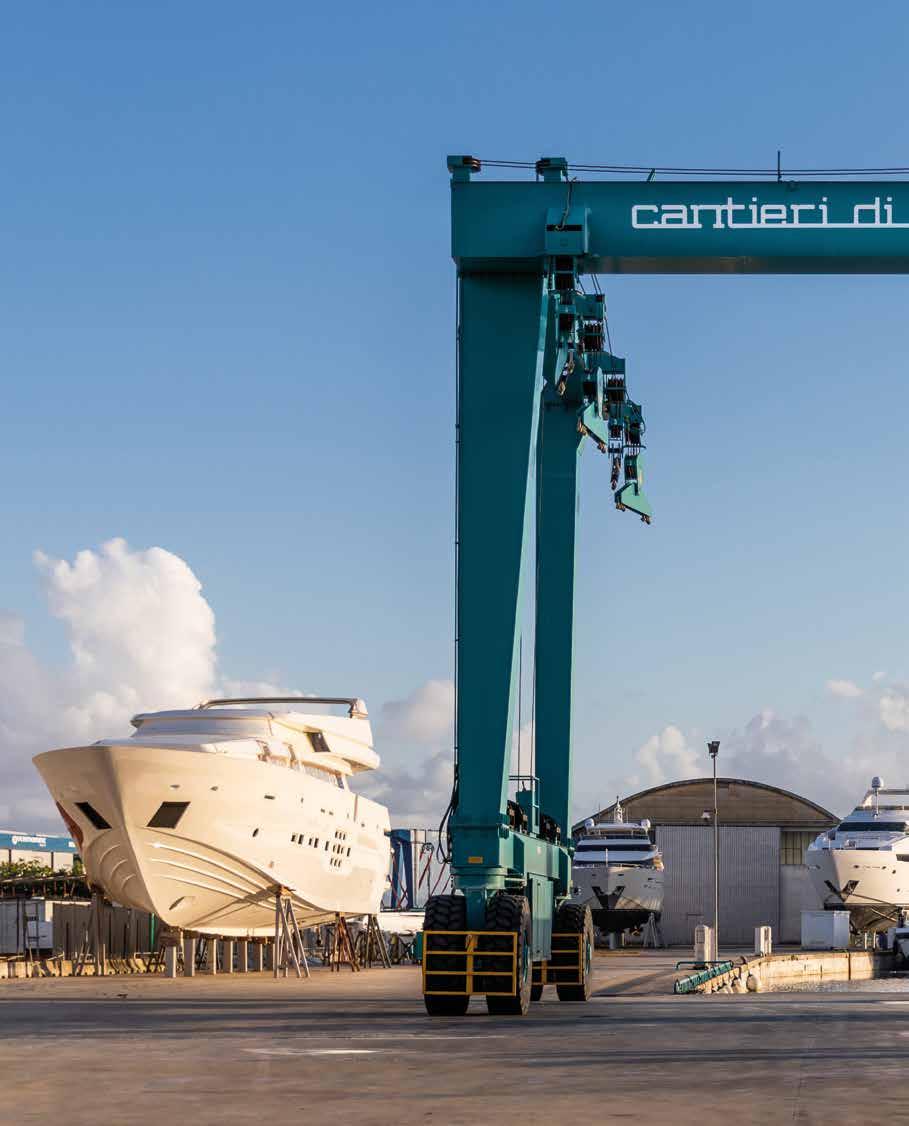
The Cantieri di Pisa travel lift. The brand was founded in 1945 in Limite sull’Arno, 30 kilometres from Florence, and in 1956 moved to its current location at Darsena Pisana, on the Canale dei Navicelli. It was acquired in 2021 by Enrico Gennasio, who initiated a new expansion project
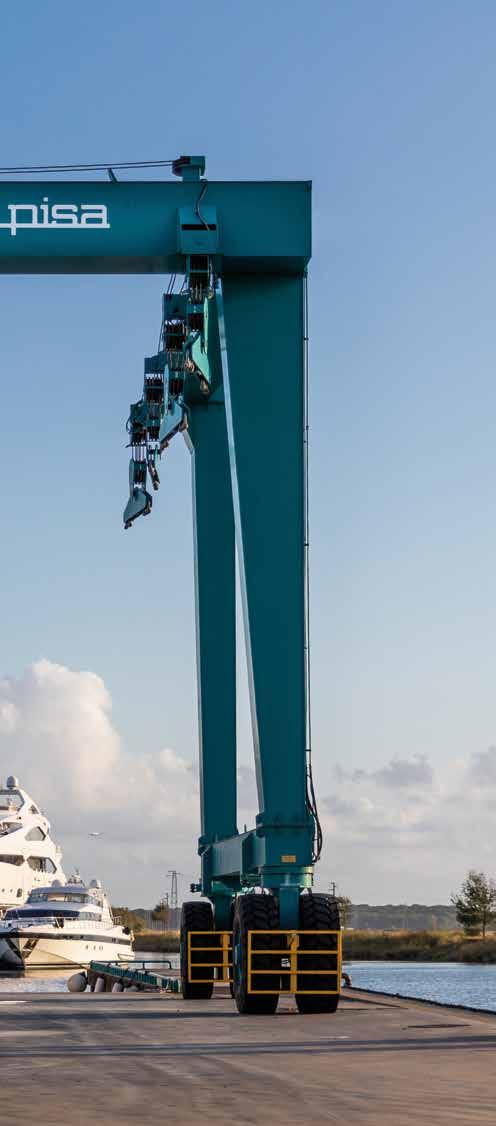
by Samuela Urbini
ph. courtesy by Cantieri di Pisa
After a change of ownership the Cantieri di Pisa marks a triumphant return with three new lines based on materials research and contemporary design, reinterpreting and updating iconic craft like the Akhir, assisted by chief designer Antonio Luxardo
After a fifteen-year production hiatus the Cantieri di Pisa brand returned to the Cannes Yachting Festival 2024, marking a new stage in the yard’s story. Founded in 1945, at first it specialised in the construction and refit of civil and military craft and then built majestic sail yachts, but the brand achieved distinction during the halcyon days of the 1960s when motor yachts reached a peak of style and desirability, especially with the arrival of the Akhir series, launched in 1970. Pierluigi Spadolini contributed to the yacht’s creation, designing a craft with innovative yet timeless lines that made Cantieri di Pisa famous throughout the world.


In more recent years the yard remained inactive, until in 2021 the entrepreneur Enrico Gennasio, president of Alfagomma, acquired the brand with the intention of relaunching it. “We decided to concentrate on the refit business first for the yard’s reboot, which enabled us to re-establish contacts with suppliers”, says Marco Massabò, the company’s CEO, who boasts extensive experience in the sector, “But we had one great strength – a solid financial base on which to build our future”. Since 2021, six million euro have been invested in expanding the production facilities and kickstarting the renewal process that also involved the participation of Antonio Luxardo as creative director, taking charge of all the projects, along with supervision of the Custom division. This led to the presentation of the first models in the three new lines from Cantieri di Pisa - Polaris 48, the explorer of the future, Saturno 56 and the eagerly-awaited Akhir 44, the return of an icon whose development inevitably involved a careful balance of innovation and
From left, Antonio Luxardo, chief designer for Cantieri di Pisa, and CEO Marco Massabò. Bottom, this page and opposite page, the basic lines of the new Akhir 44 in some hand-drawn sketches from the studio. The yard’s iconic yacht is given new life under the watchful eye of creative director Antonio Luxardo, who has retained the basic lines like the air intake with horizontal grille. Opposite page, top, renderings of the first models in the three new lines from Cantieri di Pisa: Saturno 56, Polaris 48 and Akhir 44
respect for the past. “It took eight months to redesign it, even though I’d been thinking about it since the age of 14”, says Luxardo. The style of Luigi Spadolini, an architect influenced by Le Corbusier’s rationalism, featured, among other elements, smoked glass ribbon windows. “He is the person who transformed what were originally small ships into yachts, especially when they were over 30 metres”, Luxardo adds. “Extremnely elegant lines with a certain athleticism. The main points we worked on involved innovation and, in part, the style, remaining solidly rooted in the yard’s history. The rules have changed, there’s whole a whole series of areas where the market has evolved since the crisis of 2008, and transferring all this onto the Akhir was no easy task. We had to expand the spaces, because these days all yachts over 30 metres feature a full-beam forward section, unlike the Akhir models of the past. We have, though, retained the stylistic codes of the Akhir concept, with the characteristic flow of the surfaces between the upper and


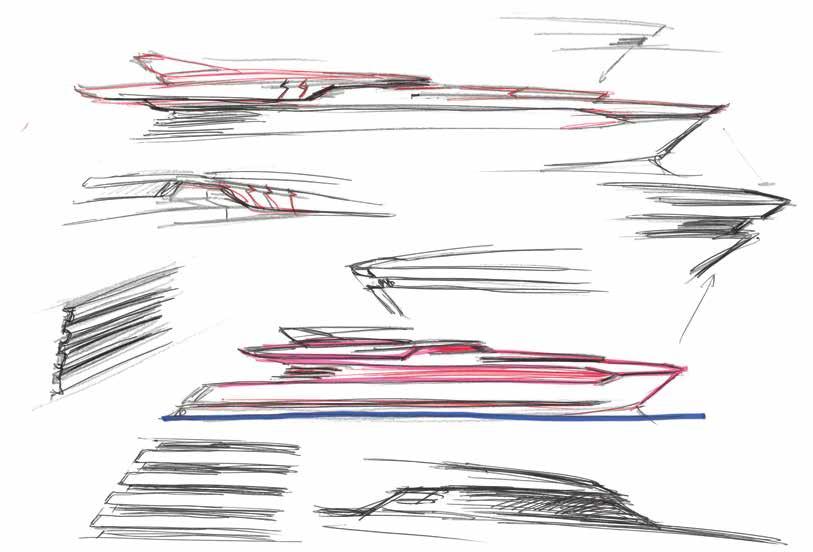


main decks, the air intakes and the horizontal black and white stripes displayed by all the Akhir models. And finally, the grace and elegance of the tapered bow, contrasting with the imposing stern”. Together with the yard’s style centre, Luxardo has already designed a 44S version that responds to different market requirements, with an opening stern and partially covered flybridge, unlike the 44, which, like the traditional Akhirs, has an entirely open flybridge. The three new Cantieri di Pisa lines are offered in different sizes, and the Akhir is no exception as development is under way for a 36-metre version of this fast yacht with vacuum-infusion carbon fibre composite hull and superstructure. For the interiors, Cantieri di Pisa has collaborated with some of the most famous design studios, like m2atelier, Parisotto+Formenton Architetti, Burdisso Capponi and Francesca Gianficconi, responding to the desires of demanding owners with a taste for elegance. In the meantime the yard, which has a full custom 38-metre craft under construction and maintains its interest in the refit sector, has also announced a joint venture with the Genoa-based Mariotti group, further strengthening corporate assets, a move that CEO Massabò regards as extremely important, reflecting the competence and professionalism of a company that prioritises the quality of its builds over production volume, so innovation – especially in materials – is a crucial factor.
Above, a rendering of the Akhir 44 and one of the first profile sketches made during the design stage – the yacht’s essential lines are retained, with some details developed later, retaining the historic model’s recognisability and elegance


Above, the Polaris 48, the first model in a range of steel and aluminium craft, the result of a collaboration between Antonio Luxardo and Parisotto + Formenton Architetti for the interior design (photo, right). The materials are typical of the Akhir type, like decapé teak, carbon fibre, bronze, glass and brass. Bottom, the yacht Saturno 56. Its interior design (photo on opposite page, bottom), is by m2atelier, an architectural and design studio founded by Marco Bonelli ande Marijana Radovic




A 34-metre yacht where sleek lines combine with comfort and well-being. This high-performance, adrenalin-charged craft provides its guests with a series of unexpected spaces. Minimalistic, sculptural furnishings create a unique personality
by Paola Bertelli


B110 is an expression of our technical know-how and our capacity for design innovation. The yacht includes new stylistic details, which blend with the brand’s DNA”, says Roy Capasso, Head of Sales AB Yachts, as he describes the new model, the first of a new generation.
The AB Yachts brand is closely linked to performance. Its yachts display an extraordinary athleticism. The owner of an AB Yachts craft seeks the excitement of speed and the adrenaline rush of a scorching lift onto the plane alongside ever more glamour, comfort and liveability.
The new AB110 is a 34-metre yacht with high technical and aesthetic content. It is the result of a collaboration between the AB Yachts team and Marco Casamonti of Archea Associati, who handled the interior and exterior design – and it is the exterior design that expresses speed while creating exceptional spaces.
One of the main details expressing the evolution of this model’s lines is the windshield – as Marco Casamonti explains, “It is angled forward to reduce glare from the glazed surfaces. This solution has also enabled us to extend the flybridge, making it larger and more functional”. Looking at the yacht on the water this does not compromise its sporty lines, as it is barely noticeable despite its 15-metre length. The same generous treatment has been given to the beach club that rounds off the cockpit, to which it is connected by two lateral stairways. The exterior spaces are completed by a forward lounge that seems to be carved into the hull. But it would be misleading to consider the exteriors and interiors as different themes. On the AB110 they are conceived as a single flowing entity with furnishings, finishes and architectural elements that engage in a dialogue and share a minimalistic loft style. The main ingredient and thematic link between indoor and outdoor spaces is the teak floor slats with light seams that run from the forward deck to the stern, passing through the cockpit, saloon, helm station and the stairs to the lower deck, continuing from here along the walls and ceilings of the corridor.
The teak is impeccably worked – examples of this can be seen on the details and curves on the steps between the cockpit and beach club and the spectacular stairs down to the sleeping area on the lower deck, where the stairs blend into the walls. There is also extensive use of carbon fibre on board, and it features in the two symmetrical aerial staircases leading from the cockpit to the roof top, with a geometry that evokes that used by graphic artist Escher in his artworks.
On entering the saloon attention is captured by the sculptural galley/bar with its transverse location at the entrance. This custom-made unit has a slatted, lacquered front and MDI top by Inalco. Its sinuous shape, like the channels in the ceiling, evokes the movement of the waves on which it seems to float. Soft lines for the dining area, with round table by Baxter – like all the free-standing furniture in the saloon – and great versatility for the conversation area provided by modular sofas that resemble large pouffes. A reflective screen conceals storage spaces and a mirror tv, and behind this lies the yacht’s technical heart, a helm station with a pure design that provides the clearest embodiment of the concept behind the AB110. It is also equipped with a lighting system that changes tone and mood as the yacht’s speed increases. Twin staircases forward of the console exploit the natural light flooding through the windscreen to create a flowing link between the main deck and the guest cabins on the lower deck. The owner’s cabin is amidships, plus two doubles and a VIP. The cabins boast thick carpets and suede-panelled walls, generating a feeling of extreme comfort and softness as well as muffling sound. AB110 is a super-sporty yacht that can travel at a top speed of 43 knots while offering outstanding comfort and elegance. The powerful MJP hydrojet propulsion (a strategic tried and tested technical choice for the yard) is linked to 2,000 hp MAN engines, and the yacht also features two Seakeeper stabilisers. The shallow 1.30 metre draught means the AB110 can voyage almost anywhere with total freedom and well-being. www.abyachts.com
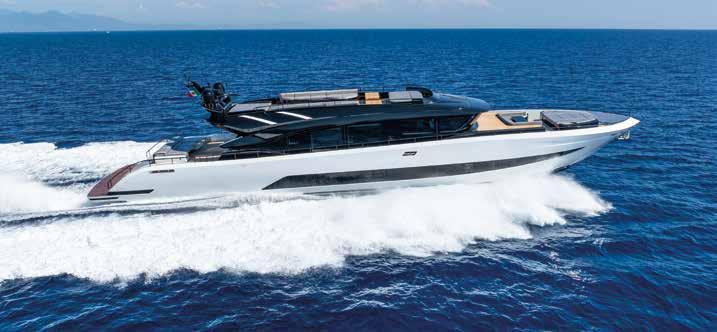
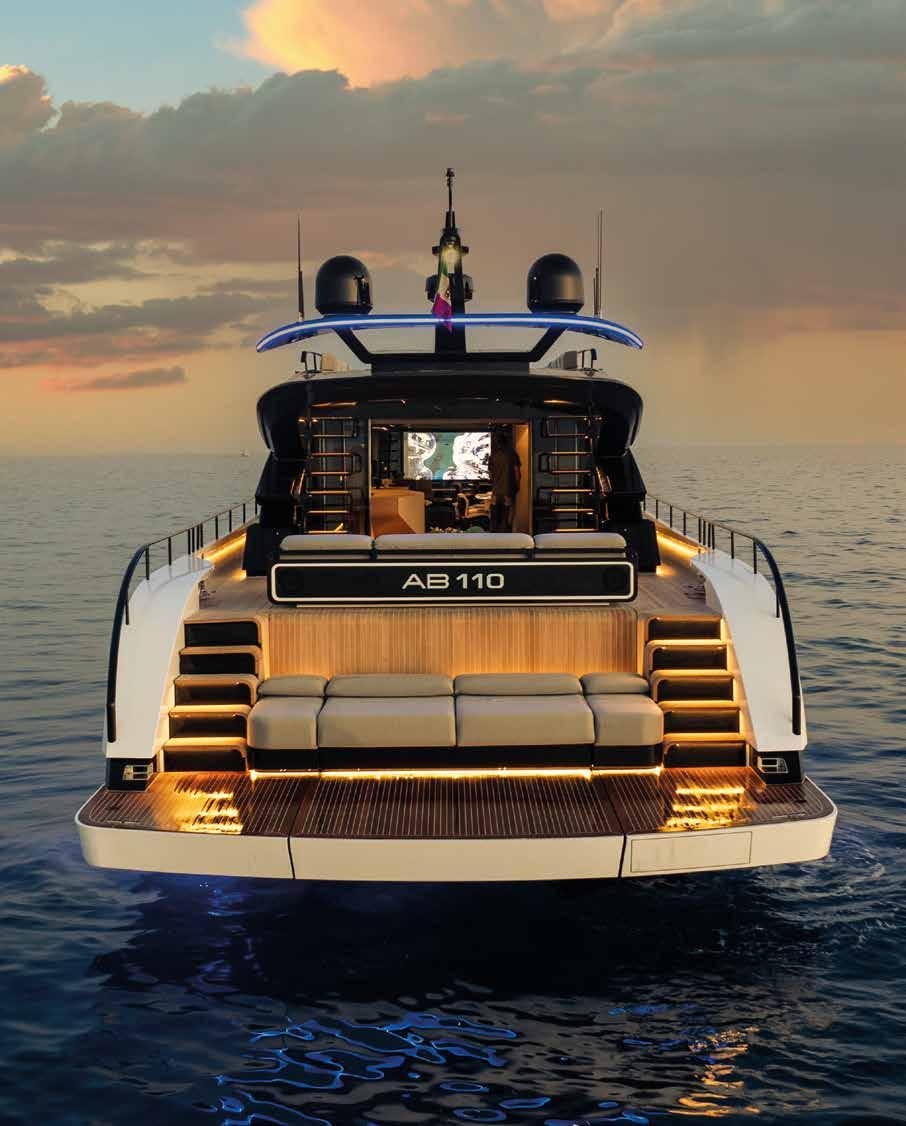
The beach area, cockpit and saloon are ideally connected to enable free-flowing movement. The AB 110 is equipped with powerful hydrojet propulsion that can push it to a speed of 43 knots.
Opening, the sculptural stairs up to the sun deck are the distinctive element of the cockpit

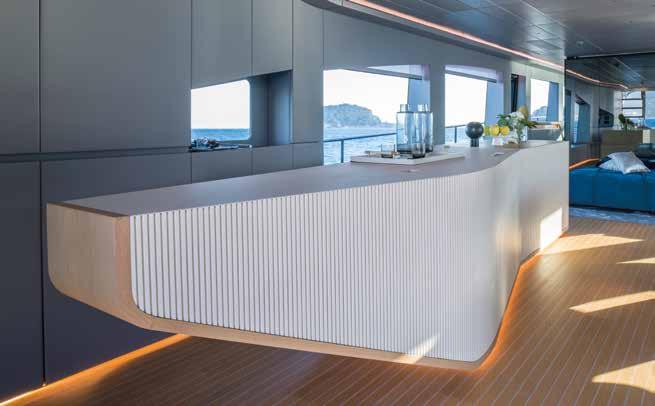
A sophisticated loft style is the on-board theme.
The flooring in the saloon is in the same light teak as in the exteriors. All the freestanding elements are by Baxter, the kitchen unit (left) which seems to float, is a custom-made piece.
A mirrored screen (to side, top) separates the saloon from the helm console. The sundeck sofa and lounger upholstery (to side, bottom) are by Poltrona Frau, customised for AB Yachts



ABelow: the lines are clean, soft and dynamic. The yacht’s markedly athletic personality is balanced by extremely generous exterior spaces. When on the water the original shapes of the coach roof with its reverse windscreen stand out. The flybridge can hardly be seen at all but its dimensions can be appreciated in the aerial photo to side
During the development of the project we paid particular attention to the continuity between interiors and exteriors –the total design concept is expressed through the perfection of details, like the uninterrupted teak planking seen throughout the yacht. The exterior furnishings – the kitchen unit, for example – are designed to be sculptural and airy. The two symmetrical exterior staircases, which are true works of art, transcend classic design cues, forming a sinuous element linking the cockpit with the sun deck. They combine a strong aesthetic impact with extreme minimalist functionality. Their creation was made possible by the use of advanced technology and materials, with CNC machining centres and carbon fibre.
B110 is a decidedly athletic craft – its design marks an evolution for AB yachts. Together with the Archea studio we worked to create clean, fluid lines. Picture an object in a wind tunnel that modifies its shapes to avoid blocking the flows, removing all rough edges and softening the lines: the sharp, tapered tension of an arrow combines with soft, yielding surfaces while maintaining a stiff, solid shell.
We also paid close attention to developing the exterior lighting, which highlights and enhances the characteristic coach roof lines, making the yacht recognisable and iconic at night, too. With the AB110, a yacht that offers outstanding – and silent - performance with an absence of vibration, and takes the concepts of liveability, comfort and extreme well-being to even higher levels, it’s been possible to achieve the harmony that complements the enjoyment of performance with the pleasure of freedom of movement and well-being.


Ican sum up the main themes of the AB110’s design in three words – decoration, minimalism and comfort. The aesthetic intention shaping the decor is most succinctly expressed by the patterns on the leather panels embellishing the interior walls, with smooth leather on the main deck and suede in the lower deck sleeping area, the use of refined, sustainable materials (the leather is a waste product of the food industry) with woods given a relief-effect brushed finish that highlights their materiality and elegance. This choice is both aesthetic and functional, as it helps attenuate and filter noise and vibration, although these are already significantly reduced by the technical choices and propulsion systems that are typical of AB brand yachts.
The use of a colour palette ranging from grey to teak, black and blue helps embrace guests in a sensation of warm, sophisticated welcome –the saloon, for example, is transformed into a theatrical loft dominated by the sculptural kitchen unit and the monolithic element separating the saloon from the technical area, providing the privacy owner and guests desire. The clean, minimalist materiality reaches a peak in the helm station, the yacht’s distinctive feature, which boasts total integration of the instrumentation. The AB110 can sail at 43 knots, stable and with perfect trim. Its living spaces are adapted to the social interaction typical of loft living, complemented by harmonious lines, sophisticated lighting and refined details.





The guest accommodation is on the lower deck. As well as creating a sensation of softness the padded, leather-clad walls help enhance soundproofing. The owner’s suite (on this page) lies amidships, with two double cabins forward (to side, bottom) followed by a VIP cabin. To side, top, one of the two identical teak staircases lining the lower and main decks
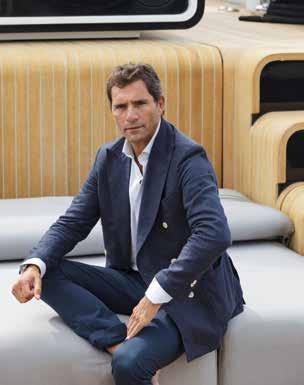
The clean, minimal lines of the helm station developed by Fincantieri with Seasyacht, featuring impeccably-finished teak. The surfaces are in Poltrona Frau leather

TheAB110 is the first of a new generation of yachts – its main features are athletic lines, excellent livability, breath-taking performance and a design that combines tradition and the cutting edge.
In the context of design, our technical office made a detail study of the airflows over the coach roof, ensuring that it has no negative impact on performance and emphasising the overall aerodynamics of the yacht. Integrating advanced materials like carbon fibre was one of the most challenging aspects of our work on the AB110, as well working to create ample spaces without compromising on performance. The uninterrupted continuum between interiors and exteriors created when the aft, full-beam door between the saloon and cockpit is open is a particularly successful feature. The sun deck, totally customisable by the client, is no less striking. Market response has been extremely positive. The first model, built on spec, generated significant interest in the European market, but especially in the USA and Middle East. As I said before, it’s the first in a new line that’s already set to grow – at the Fort Lauderdale show we presented the new AB95 and AB95 S. As for sustainability, we adopted an all-round approach through a series of interacting elements. We use light and lightened materials as well as solutions and technology designed to reduce energy use. In-depth research into the hull shapes makes the yachts more efficient and provides outstanding fuel consumption figures. Weight management helps, too – for example, we use glass that’s not only lightened but also features UVA filters that limit the need to climatise the interiors, which means using less energy.
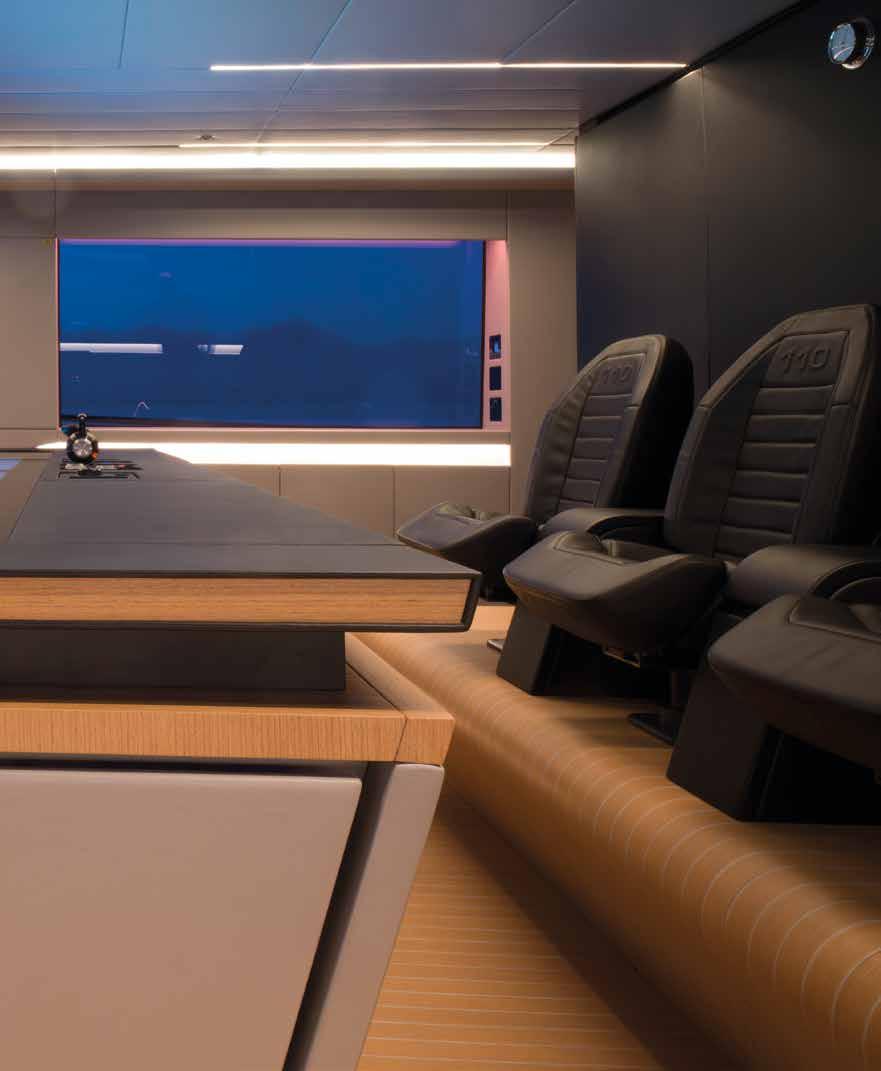
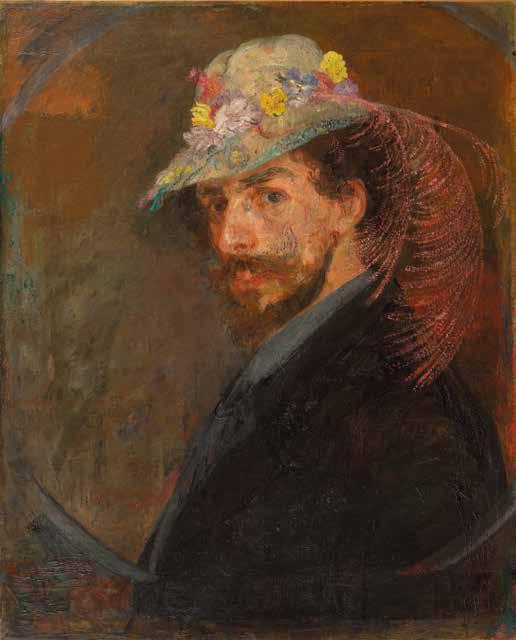
Antwerp celebrates the artist known for his masks with a series of eclectic exhibitions investigating the various aspects and influence of his paintings
by Micaela Zucconi
To side, James Ensor, Self-portrait with Flower Hat, oil on canvas, dated 1883-1888, inspired by the self-portrait with straw hat by Madame VigéeLebrun, 1782 (now held in the National Gallery, London)
Mu.ZEE of Ostend collection, photo: Adri Verburg

side, James
The
Royal Museum of Fine Arts Antwerp, Communauté Flamande Collection.
(Koninklijk Museum voor Schone Kunsten, KMSKA)
Left, James Ensor, The Drunkards, 1883, from the artist’s Impressionist period. Belfius Art Collection

“Often driven by contrary winds I have sailed in fantastic regions”, said James Ensor (18601949). With an English father and Belgian mother, he spent his life in Ostend, his native city, and Brussels, with a few interludes in Paris. The “fantastic regions” are above all those that animate the numerous ironic, grotesque and sometimes macabre works for which he is most famous. These were preceded by a period of tireless experimentation followed by a radical changes, permeated by the ideas of the avant-garde of the time, when Paris was the beacon of the new. This stylistic evolution made him a pioneer of modernism. Belgium made the 75th anniversary of his death with a series of initiatives, starting with the opening of the museum in his Ostend home in 2023 and the inauguration of four shows in Antwerp. “In Your Wildest Dreams. Ensor Beyond Impression” at the Royal Museum of Fine Arts Antwerp (KMSKA), home of the world’s largest collection of the Belgian artist’s works (39 paintings, over 600 drawings, engravings and archive materials). The support of international loans from London, New York and Paris has enabled a precise reconstruction of Ensor’s artistic evolution, developing along a theme with theatrical evocations. “James Ensor was a rebel, his approach to Impressionism was always animated by an intention to go beyond, to break the rules. In fact he transformed it into something radical. He anticipated Expressionism and Surrealism. With our Ensor Research Project we


James Ensor, L’Intrigue, 1890, oil on canvas. Royal Museum of Fine Arts Antwerp, Communauté Flamande Collection

Above, James Ensor, The Skeleton Painter, 1896, oil on panel. Royal Museum of Fine Arts Antwerp, Communauté Flamande Collection. Left, James Ensor, Skeletons Warming Themselves, Kimbell Art Museum, Fort Worth, Texas
have discovered new aspects of his creative process and personality. For example, he could never be described as a misanthrope – he was, in fact, surrounded by friends and enjoyed significant female friendships, although he never married. Women, beginning with those in his family, always played an important role in his life”, says Herwig Tods, exhibition curator and a specialist in the artist’s life and work. Before discovering his true artistic path, Ensor researched how to give greater intensity to light and colours, looking towards Édouard Manet and Claude Monet,
Pierre-Auguste Renoir and Gustave Courbet’s realism. In 1886, he took part – with “The Oyster Eater” of 1882 – at the Winter salon of the avant garde circle Le XX , in company with the now well-established French Impressionists. He soon presented his vision, no longer painting only what we can see, as the Impressionists did, but also the darkest and most fantastic, in the style of Odilon Redon, to the rarified light reminiscent of William Turner. Then something happened, a clear break, the focus of the second part of the exhibition – his “wildest dreams”

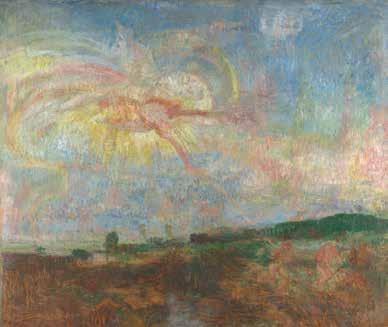
To side, James Ensor, The Fall of the Rebel Angels, Royal Museum of Fine Arts Antwerp, Communauté Flamande Collection
reverberates with echoes of the Flemish masters Hieronymus Bosch and Pieter Brueghel, and then Francisco Goya. But there is more. “Ensor also observed popular culture, carnival masks, magic lanterns and satirical shows”, transforming the scenes he painted into theatrical spectacles. It seems that he drew inspiration for his grotesque characters from tourists visiting Ostend, where he lived and where his family ran a souvenir shop. His masks reveal the nature of humankind, and the 20th-century German avant-garde, especially Emile Nolde and George Grosz, soon discovered

To side, James Ensor, Adam and Eve Expelled from Paradise, 1887. Royal Museum of Fine Arts Antwerp, Communauté Flamande Collection. Above, James Ensor, Masks Confronting Death, 1888. MoMA, New York. Mrs Simon Guggenheim Fund, 1951. From the exhibition “In your wildest dreams. Ensor beyond impressionism”, KMSKA (28 September 2024 -19 January 2025).
his work. The subject is taken up once again in “Masquerade, Make-up & Ensor” at the MoMu (Museum of Fashion, Antwerp) in an exhibition exploring his contemporary significance, while the FOMU (Museum of Photography) compares him to another rebel, the photographer Cindy Sherman, with her costumes and fashion commissions (until 2/2/2025). Finally, Ensor’s unmissable graphic adventures in engravings and prints could be seen at the Plantin-Moretus Museum, with “Ensor’s States of Imagination” (until 19/1/2025).
Architect and designer, artist and sculptor. Michele De Lucchi’s work on creating and transforming the environment embraces many forms of expression, all sharing an emphasis on the central role played by nature
by Marta Bernasconi - ph. courtesy by AMDL CIRCLE
Nothing can be taken for granted when interviewing illustrious architects who are also great thinkers. Their soaring vision makes it impossible to remain tied to the classic question-response format. The dialectic flow of Michele De Lucchi, architect and founder of AMDL CIRCLE, is an example of this. It starts from the original question and takes
flight, leading the interviewer on a journey of discovery, revealing unexpected aspects of architecture and design, beginning with the role of the architect and his or her responsibilities. “Being an architect doesn’t simply mean constructing large buildings, imposing edifices – it’s about inspiring a type of behaviour, a lifestyle, positing an idea of existence that is most in harmony

Above: the Fornetta, a house on Lake Maggiore that seems to be in an ideal symbiosis with its surroundings. Designed by AMDL CIRCLE and Michele De Lucchi, it is built entirely in wood using ancient techniques, without the use of glues or chemical substances. It uses solar and geo-thermal power. Right: Michele De Lucchi, architect and founder of AMDL CIRCLE. The distinctive beard is his “first design”, inspired many years ago by his desire to distinguish himself from his brother


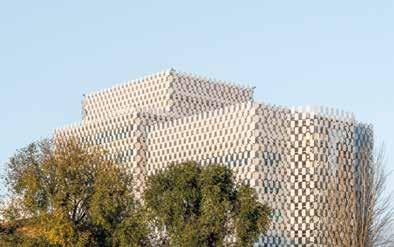
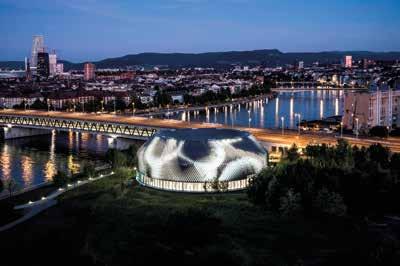

Above and left: the Nordic Pavilion for Expo 2025 in Osaka. Above: the circular Novartis Pavilion in Basle. Below, left, the Towers on the OpenZone scientific campus near Milan’s Parco Nord. Page to side, clockwise: the Portrait Hotel in Milan; the San Barbato Pavilion in Basilicata, a structure intended for fairs and events; the Teseo collection designed for Roda comprises table and chairs in teak slats sewn together with cord; the Pulcina cafetiere, designed for Alessi; Lana by Antrax, a modular radiator in 100% recyclable aluminium (with Tolomeo lamp in the foreground)
with the context it exists in. In my professional life, as well as building houses, office blocks, hotels and many other things, I try to organise visions that are the most attractive and seductive, ones that inspire new behaviours and a new idea of humankind’s artificial life”. This human-centred approach has always been a constant in Michele De Lucchi’s work. When he was one of the figures involved in Alchimia and Memphis, when he was head of Design Olivetti between 1988 and 2002, when he created the world’s best-selling lamp, the Tolomeo by Artemide, which was awarded the Compasso d’Oro prize in 1987, and now, too, with his inter-disciplinary AMDL CIRCLE studio, he operates in architecture, interior design, design and graphics, on
the basis that the new projects must interpret change and, when possible, inspire them. The Circle carries out projects for public and private bodies and collaborates with large companies like Intesa Sanpaolo, Deutsche Bank, Novartis and UniCredit, designs buildings and display systems for institutions like Berlin’s Neues Museum, the Milan Triennale and the Gallerie d’Italia in Milan, Turin and Naples. It also works in the hotel sector – a recent example of this is the Portrait Milano hotel, the result of the restoration of an episcopal seminary in the heart of the city. In the context of product design the Milanese studio has designed lamps, products and furnishings for Alessi, Artemide, Cassina, Hermès, Poltrona Frau and UniFor.

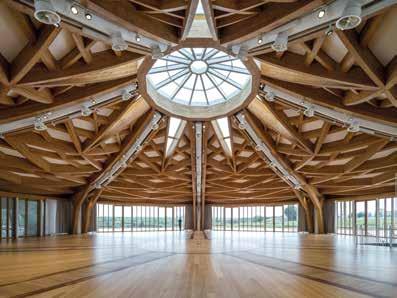



However, for the moment we focus on the subject of changes and the work of the designer. The architect thinks that creatives should not simply latch onto changes but also become a promoter of virtuous evolution. “Change is unstoppable, it’s a certainty. The point is, how should it evolve? We’re all seeking an orientation and when it seems we’ve found it something happens and we have to change again. Knowing that everything changes, that we are living in an exponential age when everything is changing at a dizzying rate, we have to find an orientation while remaining aware that we also need to adapt constantly”. De Lucchi describes himself as an adaptation specialist, a term that for a creative involves the
possibility of reinvention and renewal. He has studied architecture and worked as a designer, artist and finally as a sculptor. In 2003 he began designing and carving, decorating objects in wood in his studios in Milan and Angera, a way of seeking out the existentiality of the architectural form. Seeing him at work makes us think he experiences a special pleasure in establishing a direct link with natural materials. “I realised that this nature, which is so dear to us, is now rooted in our emotions, and from being a simple element of our surroundings and decorating our homes and other buildings it has been transformed into a central element, one with strong appeal. That’s an epochal change”.
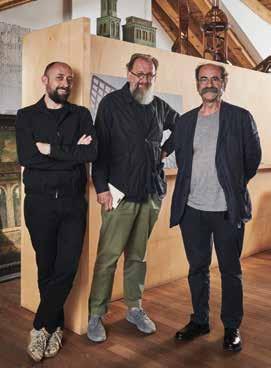
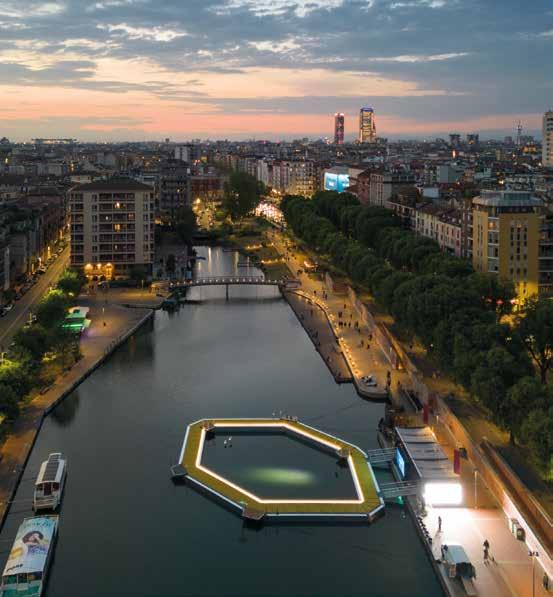
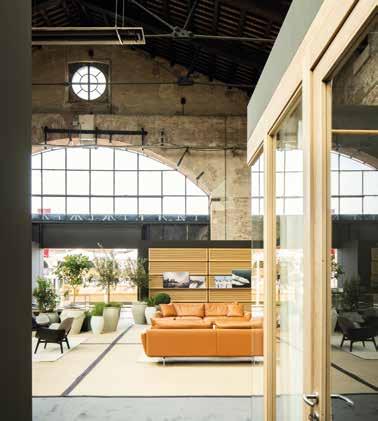
AMDL CIRCLE and Michele De Lucchi also have considerable experience in “working with water” – take, for example, the collaboration with the Azimut|Benetti yards or the renovation initiative for the Rapallo waterfront. For Michele De Lucchi, water is a surface that can host new residential construction possibilities.
“I think there’s a serious opportunity to build homes and urban centres on water, as we’ve already seen in places like the Philippines and Paris. I think the idea of not always using the land to solve housing problems but rather thinking about small floating towns is eminently sensible”.
De Lucchi maintains that contemporary problems can only be solved by looking forward – nowadays it’s all about finding a formula that that creates possible solutions that are financially feasible and environmentally sustainable. The architect tends to emphasis a very important idea that is still linked to the constant change we experience as our lives unfold. “I ask everyone to move forward with a very clear concept in mind – if we think pessimistically about a future world that’s worse than the one we live in, it’s not worth living and it’s not worth contributing to that world. But I want always to be more beautiful, so we have to believe in it and work towards it”. Enthusiasm and hope for the future – two key concepts with a constant presence in the life of Michele De Lucchi.

the water stage in the
hosted
installation
at the Milan Design Week 2024. The year 2025 will also see the completion of the architectural redevelopment by AMDL CIRCLE and Michele De Lucchi of the Azimut|Benetti Group’s historic base in Piedmont (below a render). The work aims to give new life to the spaces enriching them through the creation of new areas and a design that highlights the project’s visual relationship with its environment, enhancing the surrounding landscape



With many seeking a home-from-home feel from their yachts, the demand for spacious interiors, multifunctional layouts, and expansive outdoor areas has never been greater. Redefining expectations for yachts of its size, the Sunseeker’s new model adopts a unique approach to layout to create an unrivalled sense of space, flexibility and luxury
by Bryony Mc Cabe - ph. courtesy by Sunseeker

he right balance of onboard space can be a defining factor for the overall yachting experience, having the ability to enhance comfort, conviviality and connectivity with the natural surroundings. Sunseeker’s new model, the Ocean 156, embodies this philosophy with a unique approach to layout and a focus on penthouse proportions, maximising interior and exterior space to the extent that it can be considered a ‘pocket superyacht’.
With the yacht’s gross tonnage becoming the new benchmark for the Ocean range, Sunseeker emphasises the significant increase in usable space rather than the overall length. In fact, the Ocean 156 features an expansive 1,770 square feet of internal floor space spread over three levels – an impressive feat for a yacht of 25m length. As Andrea Frabetti, CEO of Sunseeker International, explains; “The global debut of the Ocean 156 is a proud moment for Sunseeker. It showcases our ability to push the boundaries of yacht design, delivering an extraordinary amount of space and flexibility in a model of this size.”
To deliver a sense of space typical of much larger yachts, an innovative interior layout was required. When developing this, Design Unlimited endeavoured to eliminate traditional boundaries, incorporating sliding glass doors between the interiors and exteriors and a full width bow opening door on the main deck to merge indoor and outdoor spaces. This also allows for panoramic views and ensures that natural light floods the interior, fostering a tranquil ambiance throughout the yacht. By also raising the ceilings and carefully considering furniture scale, the interior areas that feel spacious yet intimate.
This effect is best exemplified in the main deck saloon. Thanks to full-height glazing and an open-plan layout, the space is flooded with natural light and offers uninterrupted views from bow to stern. Sliding doors at both sides of the saloon seamlessly connect the interior with the exterior, while a floating staircase adds a subtle point of interest without detracting from the impressive setting. Maintaining a luxury penthouse feel, the layout can be customised with multiple arrangements including an open galley, dining area, bar and seating. With accommodation for up to 10 guests, the Ocean 156 offers the option of an owner’s stateroom on the main deck featuring impressive views and direct foredeck access via a sliding door. Configured with the ensuite to starboard and the ample wardrobe and dressing area to port, the result is a breath-taking space with an uninterrupted vista. The alternative full beam owner’s stateroom on the lower deck features ample storage, a vanity desk and connecting ensuite. Forward, the guest accommodation also comprises a VIP and two guest cabins. Sunseeker has once again ensured a completely level floor between all cabins on the lower deck – something that is rare on a yacht of this size and will benefit those on board in the subtlest of ways. An array of exterior spaces further blur the lines between indoors and outdoors and instil a sense of connection with the sea. The upper deck encompasses the central pilothouse with a single helm, port side access to the forward terrace and wide sliding doors to the aft fly deck. The beach club to the stern is available with Sunseeker’s X-TEND™ convertible seating. These exterior areas offer plenty of space for either fixed or free-standing furniture and can be easily transformed to suit different uses and occasions. For the interiors, Design Unlimited brings a contemporary, cohesive palette to all spaces and blends timeless elegance with modern sophistication. This involved collaborating with some of the world’s most prestigious suppliers, many of which are British-owned companies, including Porta Romana Lighting, Concept Hand Tufting and Turnstyle Designs. With an array of meticulously curated materials, innovative design elements, and an understated but opulent palette to choose from, owners can truly make their yacht feel like a home-from-home.
www.sunseeker.com


This page, the Ocean 156 boasts a greater sense of spaciousness than other yachts of this size thanks to a smart layout that prioritises multi-functional spaces. Opening page, the enclosed upper deck and single helm station frees up considerable space on the main deck below. The upper deck has also been designed with a Portuguese bridge, offering space for outdoor relaxation

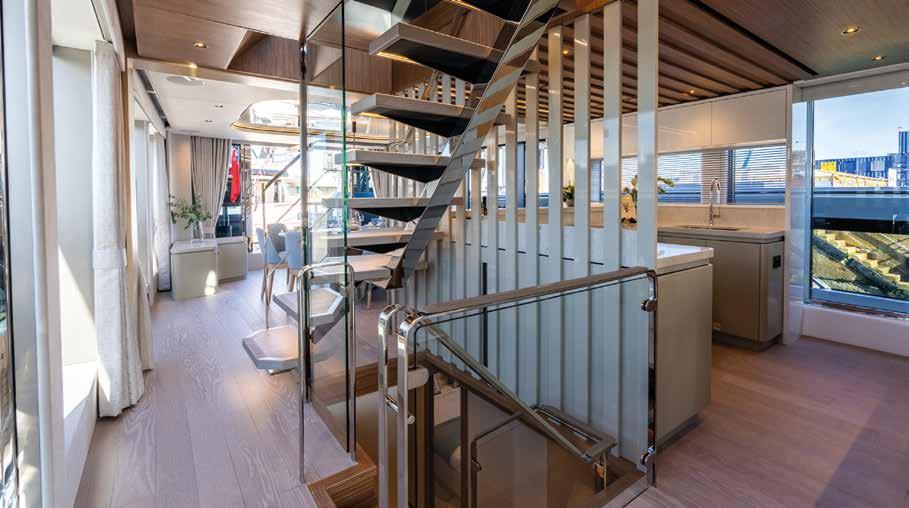

Above and right, the main deck layout is customisable, but the standard configuration places an open galley and dining space aft and a bar area forward and a floating staircase centrally. Opposite, top, the main saloon has a luxury penthouse feel with an open-plan layout that prioritises 360-degree views. Bottom left, a floating staircase adds a subtle point of interest without detracting from the impressive setting
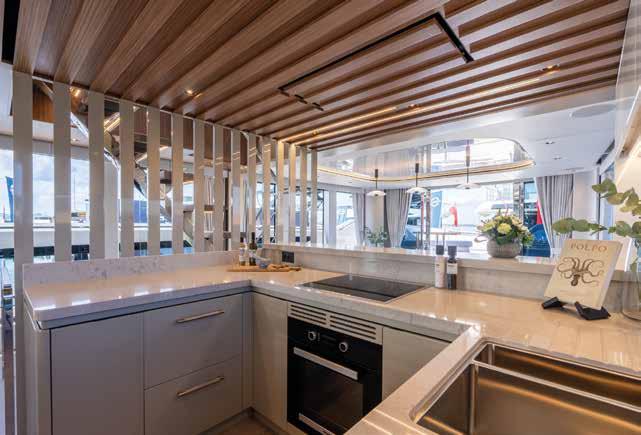
As the smaller sibling of the 90 Ocean and her sistership the Ocean 182, the Ocean 156 was conceived with a planing hull and a bluff bow. The in-house design and engineering teams were briefed to maximise interior volumes and exterior spaces within a 25m LOA while paying homage to Sunseeker’s unmistakeable styling heritage and DNA and evolving the Ocean silhouette.
One of the major directions given to the team was to engineer the main deck superstructure with full height glazing throughout, interspaced with sliding doors on the forward and aft ends and sides. The sweeping curves and voluptuous coamings are an important signature feature of any Sunseeker design and this vertical superstructure direction challenged the designers in terms of packaging the rectangular spaces within a flowing, attractive profile, with particular attention paid to the three-quarter views and overall proportions. The rectangular profile of the main deck superstructure is cleverly embedded and softened in between a sweeping hull sheer line and elegantly proportioned upper superstructure and wheelhouse.
Some of the highlights of the exterior design include an unusual but extremely practical asymmetric seating arrangement across the beam of the foredeck, providing an external dining or entertaining space for larger group interaction. The external main deck aft comprises a generous cockpit area that extends down onto the lower beach club area, with optional X-Tend available, and generous lifting transom platform. On the upper deck, the full height side glazing and aft sliding door of the wheelhouse and upper saloon provide easy access to both the Portuguese deck forward and the upper flybridge area aft. These exterior spaces truly blur the boundaries between inside and outside spaces, offering a sense of space and a feeling of oneness with the sea.



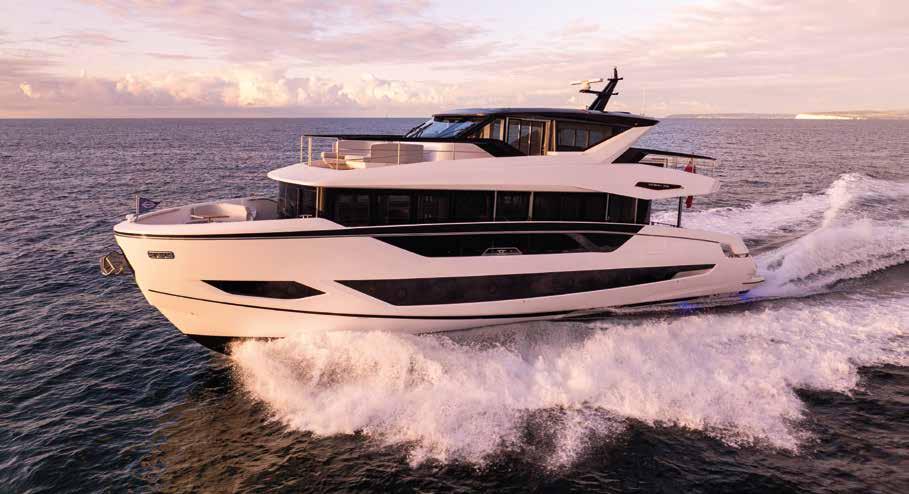
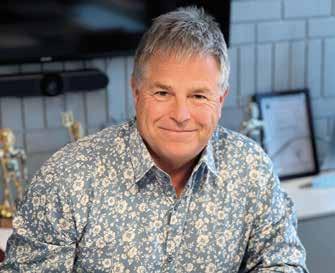
The design brief for the Ocean 156 was to create an interior that delivers an immersive, luxury living experience, balancing opulence with the practicalities required for extended cruising. The brief focused on crafting an expansive, open-plan interior that optimises space, maximises natural light, and creates a seamless connection between the yacht’s interior and exterior environments.
As such, the design draws inspiration from the natural world, particularly the ocean and coastal landscapes. A muted, neutral colour palette, enhanced by soft blues and greens, evokes a sense of serenity and connection with the sea. The furniture, designed to combine comfort with luxury, is upholstered in rich fabrics and leathers that complement the yacht’s relaxed yet sophisticated aesthetic. The interior design is distinguished by its use of cutting-edge materials and bespoke finishes. We sourced high-performance woods for the carpentry and flooring, which offer both durability and a warm, inviting aesthetic. The wall treatments blend textured natural fibres with metallic accents, reflecting light and adding depth to the design. Bespoke joinery solutions, such as the lighting design behind the master headboard, and feature stones are used selectively to create focal points that balance modern elegance with timeless craftsmanship. With panoramic views and natural light flooding into the interior thanks to the extensive glazing onboard, the result is a space that feels both expansive and intimate, offering a luxurious environment for relaxation, entertaining, and extended cruising, all while respecting the yacht’s performance capabilities and the natural surroundings.



For the interiors, Design Unlimited brings a contemporary, cohesive palette to all spaces and blends timeless elegance with modern sophistication. Bottom right, the alternative full beam owner’s stateroom on the lower deck features ample storage, a vanity desk and connecting ensuite (top right). Opposite, the guest accommodation comprises a VIP and two guest cabins.



Rather than using the boat’s length within its model name, the Ocean 156 references its gross tonnage figure – the measurement of a yachts interior volume. While this is a new and unexpected naming convention for Sunseeker, it captures why this new model is unique by referencing the significant increase in interior volume in a yacht measuring 80ft compared with a conventional yacht layout of a similar size
The Ocean 156 was conceived from the start to have a single level main deck saloon, dining and galley layout and an upper deck enclosed wheelhouse and upper saloon. This flexibility of layout options and the truly amazing space and volume for this size of yacht offer our clients a remarkable and bespoke opportunity on what is still a production platform. The new Ocean 156 series is indeed a mini superyacht in scope. A significant driver of our innovation is the invaluable feedback we gather through daily conversations with our customers. They share their visions of life onboard, and we strive to bring those dreams to life. As more of our customers spend extended time aboard and embark on longer journeys, the demand for a true home-away-from-home experience has grown. This calls for larger living areas and intelligently designed layouts that seamlessly balance social togetherness with private retreats, ensuring ultimate comfort for extended travel and exploration. Since her global debut at Southampton International Boat Show in September 2024, the Sunseeker Ocean 156 has exceeded all expectation. She’s already won two critically acclaimed industry awards and is nominated for another. As the order book grows, our team revels in the opportunity to showcase their amazing work at international boat shows into 2025. Meanwhile, a very exciting pipeline of new models has been in the making for quite some time. While these are currently under wraps, further details about the exciting things we have in store will be revealed at the Düsseldorf International Boat Show 2025. The future is exciting!


Buccellati adorns tables with silver objects inspired by nature, creating precious, cultured settings where artisanal skills reach new heights
by Marta Bernasconi - ph. courtesy by Buccellati
he silver tableware by Buccellati overturns what had seemed to be the unassailable conventions ruling the mise en place, with decorative objects placed in the centre of the setting, surrounded by tableware articles playing a spectacular supporting role.
The company was founded in Milan over a century ago by Mario Buccellati, and since that time the high jewellery and silverware brand has made objects that give form to a very special concept of beauty, taking advantage of the artisanal heritage of jewellery-making traditions to create original, imaginative pieces. This has given rise to the Buccellati style – in the silver tableware sector this stands out for its unusual silver working techniques and creations inspired by the natural world that have become icons. One of these is the artichoke - in the 1960s it was crafted with a cigar lighter hidden among its leaves, and now the Armatae Flores collection celebrates this vegetable’s intrinsic beauty in the individual version and the sumptuous centrepiece.
The brand’s creations are designed to create imposing mises en place, perfect for celebrations and special events that become enduring memories


Silver plays the dominant role of the table settings created by the historic house founded by Mario Buccellati. The brand opened its first shop in Milan in 1919. The silver objects are surrounded by other precious materials like porcelain and Murano glass, which go together to create mises en places infused with a warm, refined conviviality
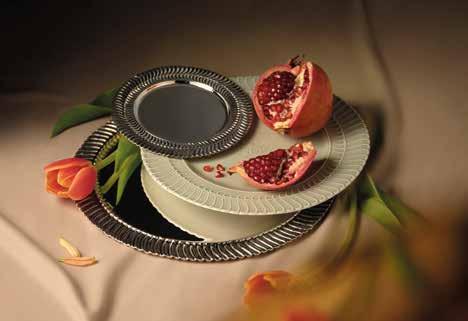


for guests. Maria Cristina Buccellati offers some valuable advice for creating a truly unforgettable table setting. “The presence of a charming centrepiece with artistic floral compositions immediately increases the setting’s visual appeal, while the quality of the table linen helps create a warm, elegant atmosphere. The lighting also plays a crucial role – whenever possible you should enhance natural light with candles, generating a suffuse lighting effect that creates intimacy and warmth”. To achieve the correct balance between the various elements and materials Maria Cristina Buccellati uses porcelain as the ideal basis for the combination with the silver cutlery,
candlesticks and various decorative objects, as, she explains, “Silver immediately provides an air of timeless elegance”. To add a lighthearted touch to the table top she introduces colourful accents in Murano glass with wood elements. This creates a warm, welcoming material excellence.
Reason and emotion come together to create the Maison Buccellati table setting – and one of its distinctive touches is the signpost. “If it’s accompanied by hand-written card, it becomes an even more important sign of welcome for guests, generating an immediate emotional connection”. buccellati.com

The Buccellati tabletop also features porcelain elements from the Double Rouche collection (top, opposite page). Created in collaboration with Ginori 1735, it shows a decorative motif inspired by the “rouche” pattern introduced by Buccellati in the 1950s
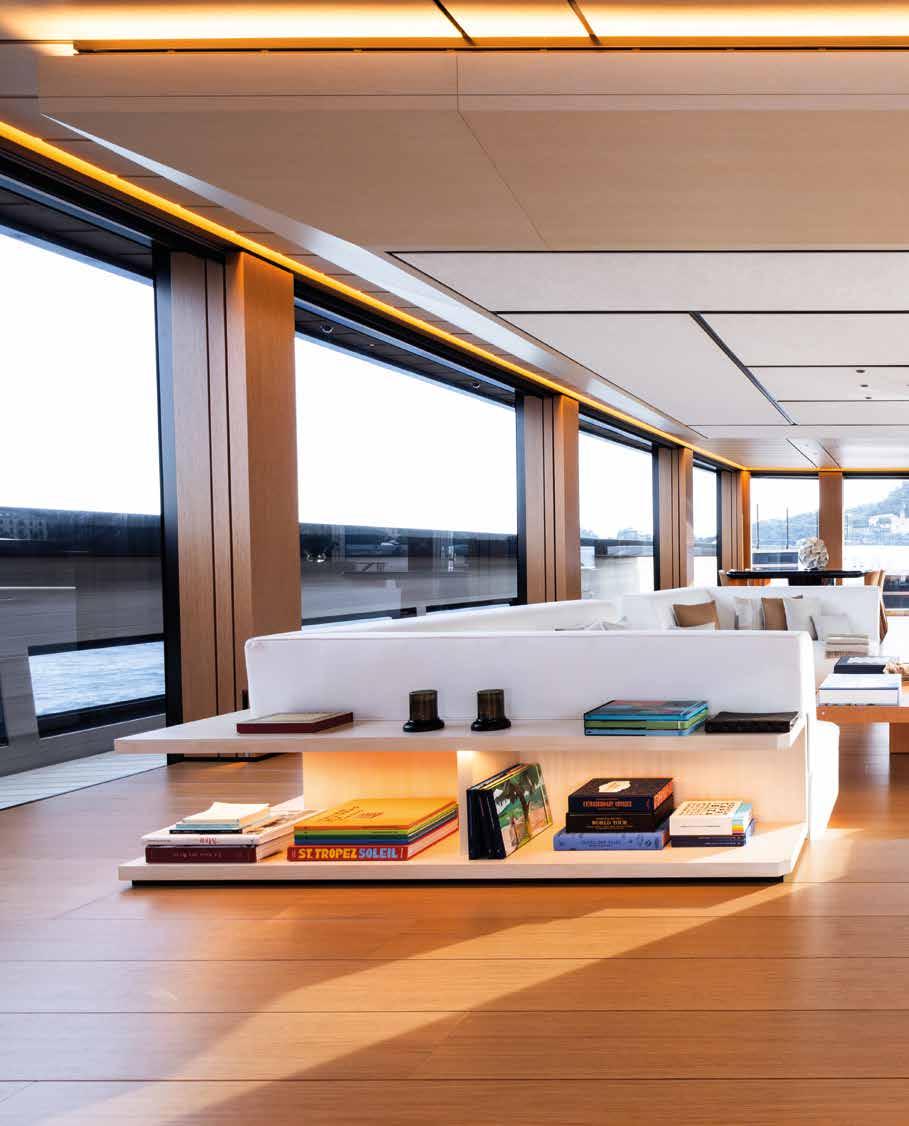
Designed to forge a close connection with the natural environment, this 45 meter by Alia Yachts maintains a sleek profile and constant visual contact with the sea while enhancing interior living spaces and onboard comfort


ustom yachts are more than just vessels; they are highly personal expressions of an owner’s ideal life at sea. Increasingly, these designs embrace a profound connection to their natural surroundings, forging stronger ties with the ocean itself. At the forefront of this trend is the 45m SAN, designed by Sinot Yacht Architecture & Design, built by Alia Yachts and with naval architecture by Lateral Naval Architects. From the outset, SAN’s owner envisioned a yacht where the water would be ever-present. This vision is most vividly realized in the open-plan main deck saloon, where floor-to-ceiling glazing, framed by narrow mullions, blurs the boundary between indoors and outdoors. With thoughtful cutouts in the bulwarks, the sea remains a constant backdrop, even when seated.
This seamless connection with the water extends to SAN’s outdoor spaces, designed to invite guests to fully embrace life al fresco. The expansive main deck, featuring shaded sofa seating, flows seamlessly down to the beach club area in the stern. Here, sunpads and folding bulwarks transform the space into a private terrace by the sea. Multi-functional furniture, such as the hi-lo teak dining table that adapts from a coffee table to a formal dining setup, ensures the area can be tailored to any occasion. On the foredeck, a versatile lounging space includes a large sunpad and a convertible table that can be lowered and covered with cushions for additional comfort.
In some ways, SAN’s onboard experience contrasts with the owner’s desire for her profile to appear as low in the water as possible. The solution was to combine streamlined, coupé-style exterior lines with a raised pilothouse configuration, maximising space without compromising aesthetics. “The main challenge on a yacht of this size and volume is that every square centimetre had to be optimised,” explains Paul Costerus, Senior Yacht Designer and Project Manager at Sinot. “While developing the layout, we had to push the boundaries everywhere while taking care
that you could still move around the boat comfortably, so the ergonomics were important too.”
To maintain SAN’s sleek profile, a portion of the ceiling in the main saloon was lowered to provide sufficient standing room in the pilothouse. This design challenge was ingeniously addressed by creating a cosy, Japaneseinspired recessed seating and dining area. Despite these adjustments, the ceiling height in the main saloon remains a generous 2.3 metres, which would be considered generous even on a much larger yacht.
The interior design’s minimalist yet refined aesthetic ensures seamless flow between indoor and outdoor spaces. Based on a palette of teak, stained oak, eucalyptus, and tan leather, just 15 premium materials were used throughout the yacht. Despite its simplicity, the design exudes warmth, with intricate details such as butterfly joints in the woodwork, saddle-stitched leather, and polished stainless-steel accents. Apart from a few pieces of free-standing furniture, all the fitted furniture is by Alia Interiors Atelier.
For the design team, maintaining strong communication with the owner throughout the process was essential. “Remarkably, this is their first yacht, but they had a very clear vision of what they wanted. The design of SAN is the result of long and in-depth conversations with the owner regarding the desired layouts, functionality, and style,” says Davide Siggia, Senior Interior Designer & Project Manager at Sinot.
The refined palette of materials continues in the accommodation on the lower deck, accessed via a spiral staircase behind the bar in the main saloon. There are four guest suites, each subtly personalised in different shades. The golden beige Luget limestone in the bathrooms was quarried in France and personally chosen by the owner. The master stateroom is forward beyond a walk-in wardrobe and bathroom. Taking advantage of the bow shape, the bed is flanked by cushioned bench seating and long windows of compound-curved glass for plenty of natural light. aliayachts.com
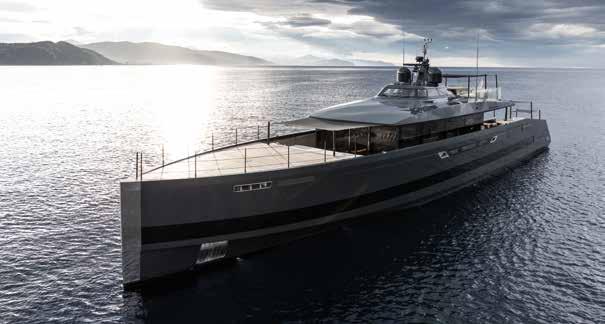
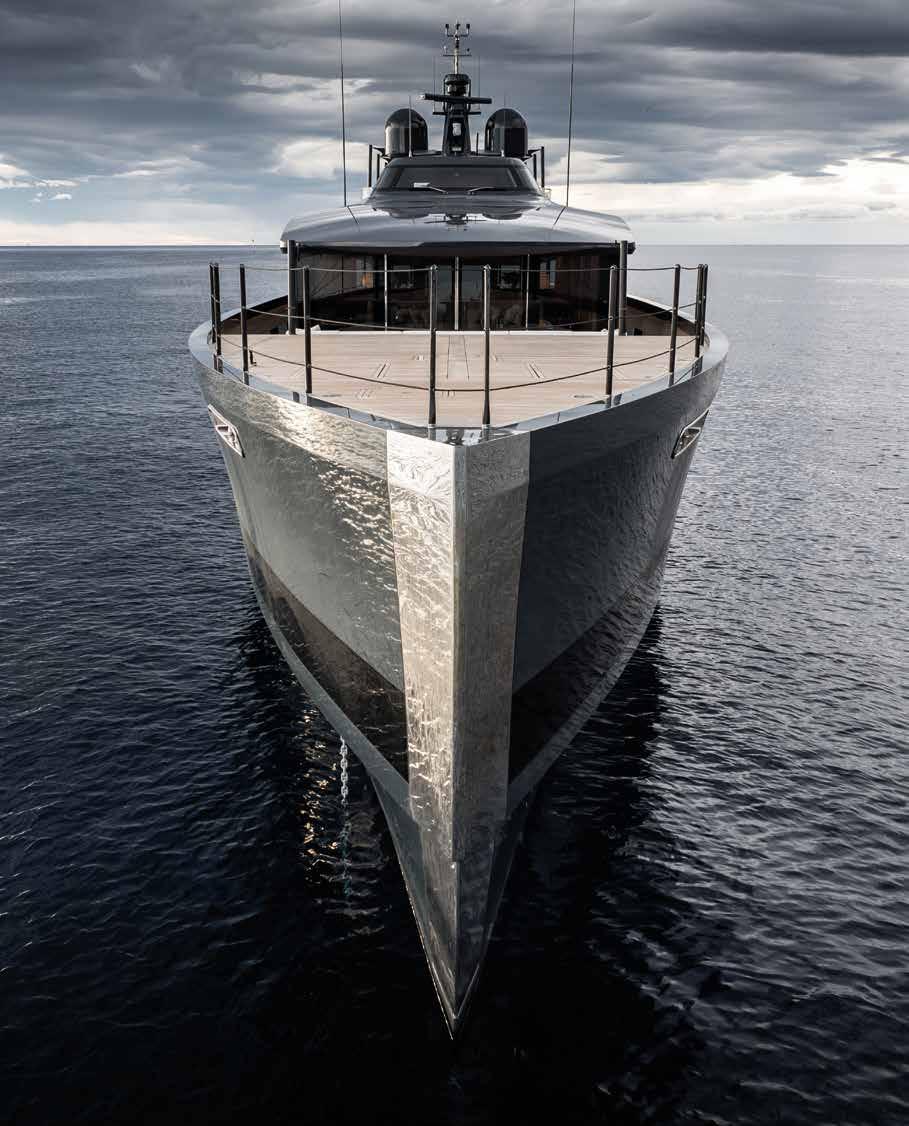
Pictured here, hidden under the foredeck is a tender garage and dedicated crane. Also on the foredeck is a large sunpad and accompanying table, which can also be lowered and covered with cushions. Opposite page, to maintain a sleek profile, SAN’s wheelhouse has been pared down to occupy the least volume possible. Opening page, the openplan main saloon is surrounded by full-height glazing and thoughtful cut-outs in the bulwarks
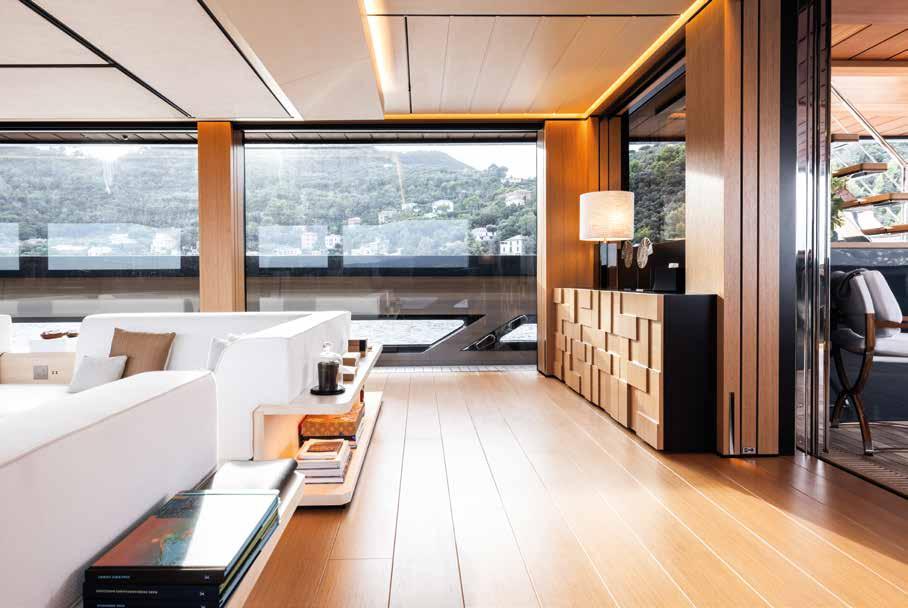

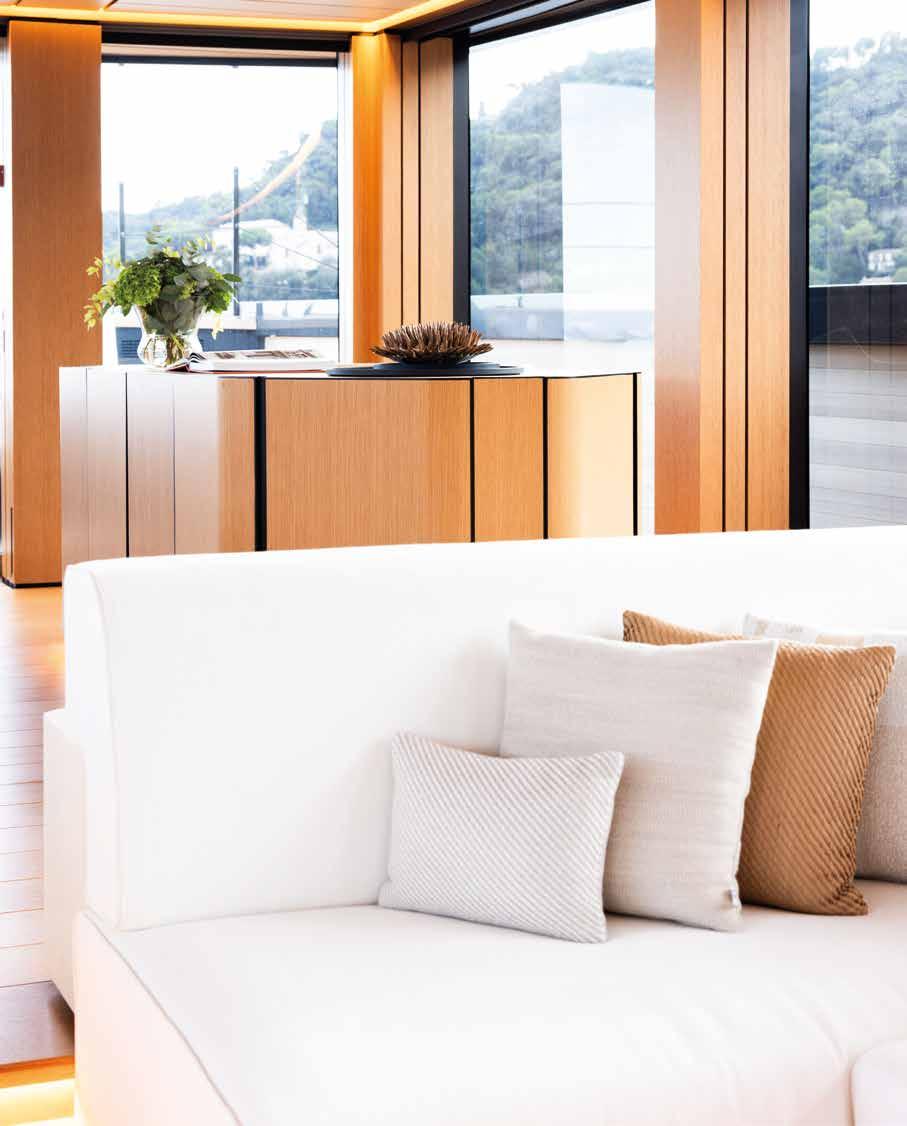
This page, the understated luxury, neutral material palette, and harmonious design of the interior create a calming environment that feels effortlessly inviting. Opposite top, the quality and craftsmanship of the carpentry stand out as a defining feature of SAN’s interior. Opposite bottom, while most of the furniture onboard was customcreated, dining chairs from Cassina were chosen for the main deck saloon, adding a touch of iconic design


Above, SAN’s streamlined, coupé-style exterior lines were the starting point for the designers. Opposite top, the sundeck table hides storage, the sofas transform into a sunbed and the sculptural bar is designed to be a functional serving area. Opposite bottom, an expansive main deck aft with shaded sofa seating and terraced steps leads down to sunpads and folding bulwarks to expand the beach club area in the stern
SAN’s owner envisioned a low-profile, sleek, open superyacht that offers a seamless connection to the water. Their key requirements included a loft-like ambiance, versatile deck spaces featuring transformable furniture, and an unobstructed line of sight from stern to bow.
Being involved from the project’s inception allowed us to embed these priorities into the very DNA of the yacht. During the development of the general arrangement and early profile studies, we prioritised creating an exterior design that harmonised the sleek aesthetics with functional adaptability. The low profile was achieved through meticulous scaling and streamlined proportions, while the open line of sight was ensured by optimising layout and deck levels. Transformable furniture was integrated to allow dynamic use of the deck spaces, enhancing the yacht’s versatility without compromising its elegance.
The approach of pushing boundaries to optimise space while maintaining ergonomics is evident throughout SAN’s design. One standout example is the owner’s suite, located forward in the hull. Designing this space posed a significant challenge due to the sculptural contours of the hull. To create a spacious and luxurious feel, we had to innovate with layout configurations and interior detailing while ensuring ergonomic functionality. The result is a suite that feels open and inviting, despite the inherent constraints of the space.
Similarly, the guest accommodations were designed with both luxury and practicality in mind, ensuring seamless serviceability for the crew without compromising privacy or comfort. The crew areas and engine room also exemplify this approach, providing functional layouts that prioritise both operational efficiency and comfort in compact spaces.


SA N’s owner sought an interior that embodied luxury without feeling ostentatious, guided by the principle that ‘less is more’. This vision called for a refined yet understated design, achieved through simplicity and meticulous attention to detail.
To translate this brief into reality, we developed an interior design centred around minimalist elegance, exceptional spatial design and innovative features. A limited material palette was chosen, focusing on natural textures and finishes. These were applied to meticulously crafted details, creating a sense of quiet sophistication. High ceilings on both the lower and main decks amplify the sense of space and openness, delivering a feeling of luxury that is unparalleled in vessels of similar size and volume. To meet the client’s specific practical needs, we collaborated closely with the shipyard to push technical boundaries. Innovations include automatically hiding mirrors and heavily integrated hardware, which seamlessly blend practicality with aesthetic refinement. The end result is a testament to the successful collaboration between the clients and our design team, bringing their shared vision to life. SAN exudes a relaxing atmosphere, combining understated luxury with exceptionally high levels of comfort. The neutral material palette, paired with meticulous detailing, creates an environment reminiscent of a comfortable beach house on the water. This unique ambiance ensures that life on board feels both sophisticated and inviting, perfectly aligning with the client’s desire for a space that prioritises elegance without ostentation.

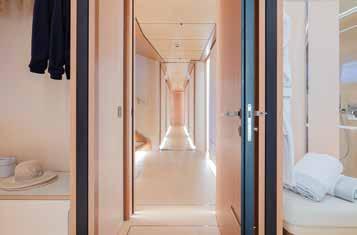

This page, a spiral staircase connects the main deck with the accommodation, featuring the same refined palette of materials and finishes. Opposite top, the master stateroom takes advantage of the bow shape. Opposite below, innovations such as invisible speakers, discreet smoke detectors, integrated AC slots, and subtle lighting preserve the design’s clean aesthetic




SAN demanded complex and innovative solutions, and the challenges ran throughout the vessel. The biggest challenge was to be able to fit every visionary demand of the owner into a relatively constricted package. The placement and size of the engine room, the completely open main deck, the jet style pilot house and the speed required were all issues that needed to be analysed and solved with innovative thinking and building solutions to make sure that at the end function and comfort would match or supersede style. Furthermore, having a main deck structure with no walls wrapped in floor to ceiling glass with minimal mullions, and establishing all functions in the lower deck within the main hull, required very intricate as well as delicate design and building skills.
But that’s what we do as full-custom yacht builders. In fact, every project at Alia is a first with its own set of challenges and rewards, but we strive to learn from every project we build. This could be a technical issue or a new piece of technology or equipment, but the most valuable thing for us is the experience our teams accumulate with every project to adapt to challenges and work around them to still deliver the highest quality expected. SAN was no different and perhaps even more rewarding in that sense since it required more than the usual number of challenges.
I think the yacht turned out exactly as how the owners have envisioned it. They knew pretty much exactly what they wanted and how they wanted to live on the sea and SAN is the manifestation of their vision. By delivering such a superior project based on innovative engineering and eye-catching design, SAN further strengthens Alia’s status as one of the top custom yacht builders in the world.
This page, SAN boasts an obstruction-free sightline from the aft deck looking forward through the main saloon to the exterior foredeck lounge. Demanding innovative and complex engineering solutions, SAN was a challenging but rewarding project for Alia Yachts



With its Mercury Verado V12 600s the American brand is accelerating towards the future. These outboards are taking power, technology and comfort to a new level
by Paola Bertelli - ph. by Mercury
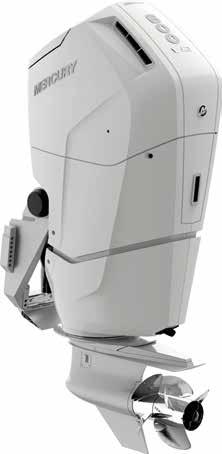

The first outboard to feature a steerable gearcase, the Mercury Verado V12 600 can mount contra-rotating props (left) that integrate perfectly with the twospeed transmission, providing true Mercurystyle acceleration. Below, the Pirelli 50 with dual installation reaches a top speed of 50 knots.

The message the modern, aerodynamic lines of this sculptured monolith are intended to send is clearly one of power, technology and a wonderfully refined sailing experience. We’re talking about the Mercury Verado V12 600, an outboard with explosive power, a distillation of engineering and innovation designed to take on the most demanding sea conditions while providing silent, comfortable sailing.
Along with growing interest among large yacht owners for this type of unit, the race to produce ever more powerful outboards has encouraged the American company to develop a propulsion unit that re-writes the book on power, comfort, design and innovation.
The motor was introduced three years ago, and in the words of Alessandro Conti, Country Manager Italy & Dealer Development EMEA Director of Mercury Italia, “The interest it aroused from the moment it caught the attention of press and public has never subsided, and has resulted in a growing series of applications, most frequently on yachts around 60 feet in length in triple or quadruple configurations, but also in a number of dual set-ups on 36-footers and above. Typically, the speed achieved is around 60 knots”. As a result the Mercury Verado V12 600 features on models like the Wallypower 58X, the Rebel 55 by Sacs Marine and the Pirelli 50. The beating heart of this outboard is its narrow V12 cylinder architecture that combined with its 600 hp develops an extraordinary fluid power. The two-speed automatic transmission ensures spine-tingling acceleration in pure Mercury stye. Also notable are the dual contra-rotating props, specially
developed by Mercury for this outboard, that help lift even large, heavy craft onto the plane fast and efficiently with that wake-churning surge that only outboards can produce. Their enhanced grip in the water also facilitates manoeuvres in restricted spaces.
The first outboards to feature a steerable gearcase – the part of the unit out of the water remains stationary and does not turn on its axis – the Mercury Verado V12 600 models can be mounted closer together, creating valuable space on the transom.
“With the introduction of the Verado V12”, says Alessandro Conti, “Mercury is writing another memorable page in Nautical history. It has developed a market segment that was previously closed to these propulsion solutions, inspiring many new applications designed and developed around this outboard. Power, design, perfect fit in the boat’s dimensions and the steerable gearcase are popular solutions among those choosing the outboard – the surprise and the “wow” effect are provided by its incredible lack of noise”.
The Mercury Verado V12 600 outboards have raised the technological bar, setting new standards of luxury and freedom. Noise and vibration are minimised – even when under way the stern area, despite the horsepower being generated, is a space for relaxation and conversation. The impressive performance is accompanied by extremely supple functioning – enjoying all the power of these outboards in great comfort is the new luxury offered by Mercury.
www.mercurymarine.com


Providing a flawless sailing experience, the Mercury Verado V12 600 outboards are surprisingly quiet. Every aspect of the motor has been developed to cut noise and vibration to a minimum. Page to side, the outboard version of the wallypower58X can mount up to four Mercury Verado 600s for a total of 2,400 hp. The same quadruple configuration also features on the Rebel 55 (above) by Sacs Tecnorib

by Paola Bertelli- ph. courtesy by Omikron Yachts

Able to charm and surprise lovers of both motor and sail yachts, the OT-60 marks the arrival of the Omikron Yachts yard in the market. It’s a functional, efficient 18-metre craft with uncluttered elegance. Juan Kouyoumdjian handled the hull lines, Lorenzo Argento the exterior and interior design and interior décor is by Ciarmoli Queda Studio

OT-60 is a motor yacht that looks beyond contemporary norms. This aerial view shows the shape of the hull and bowsprit for anchor deployment, a typical sail yacht feature

S“low yachting” is the philosophy behind the OT-60, where the word “slow” encompasses a love for the sea combined with aware, relaxed sailing and the typical lifestyle of the Greek islands against the background of the sundrenched rhythms of the Mediterranean.
OT-60 is the first model by Omikron Yachts, a brand that is part of the Greek Olympic Marine group. In 2019 the group revamped and renamed its long-established Olympic Yachts yard, which became Omikron Yachts.
With innovative design, high construction quality and an ecologically-aware approach, this intriguing18-metre craft offers new, fresh, perspectives on the motor yacht, chase boat and navette concepts – so it should come as no surprise that in 2024, the year the yard and the yacht made their debut, the OT-60 won three important prizes, the European Powerboat Award in the Long Range Yacht category, the World Yachts Trophy as Revelation of the Year and the Best of Boats Award in the ‘Big Boats’ category. The influence of sail yacht design is evident in the hull shape and
deck details – inevitable, really, as the team behind it included expert sail yachtsmen like the hull designer Juan Kouyoumdjian, a top designer better known as Juan-K, who in the racing world has been responsible for many winning boats, and Lorenzo Argento, another name closely linked to sail and racing, who created the exterior design and interior layout. Interior decor is by the Ciarmoli Queda Studio.
It’s a yacht that’s “designed to sail without sails”, as the yard likes to describe it, and this is embodied by the simple, functional, efficient and very seaworthy design that expresses the “slow yachting” concept with great elegance and comfort. This philosophy has also encouraged a move towards more sustainable solutions without increasing complexity and costs for the environment and owners. The coachroof features large, glazed surfaces - when the aft windows are open the cockpit and dinette integrate smoothly, thanks to details like the flush deck, uniform floor and complementary furnishings. The large, sociable space that is created is equipped with sofas and tables. Two side stairways connect the cockpit to the

The opening windowed partitions (above) make it possible to create a large space comprising the dinette and cockpit. Double height for the kitchen area (below), which is drenched in natural light flooding in through the large coachroof windows. The design is clean and functional throughoutthis is even more evident when the yacht is under way (opposite page)

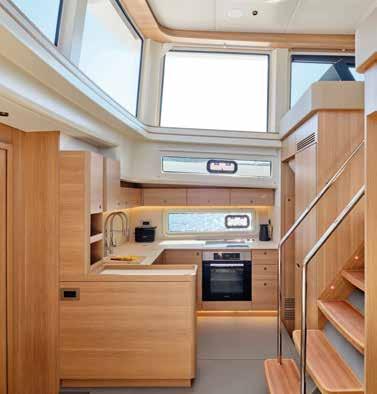


Natural materials, neutral colours and tactile finishes invite guests to relax in total comfort. Above, the helm console shares the dinette space. The three guest cabins on the lower deck (a four-cabin version is also in the works) with the full-beam owner’s cabin forward (left) and two cabins aft. The yacht has been optimised to sail at a relaxed speed of around 10-12 knots


bathing platform. A classic sunpad is located forward.
The lack of flybridge is a deliberate design choice, as on a yacht of this type and size it would compromise the sleek, casual style.
The interior colour palette is made up of light, neutral shades, with natural fabrics and bright, fresh spaces inviting relaxation. The central area of the lower deck is especially interesting - not all the lower deck is actually “below deck”. Coming down the stairs, guests land in an open-concept, double-deck height annexe that comprises galley and dining area. This space is very bright, exploiting the light streaming in through the coachroof windows.
There are two planned layouts, with three or four cabins fore and aft of the galley.
The hull and engines are optimised for easy-going sailing at speeds of 10-12 knots while sipping frugally at the fuel, consuming only about 1.25 lt/h. According to research carried out by Omikron, these are the ideal speeds for laid-back sailing, as they enable passengers to enjoy the pleasures of the voyage and on-board life while travelling from one destination to the next. omikronyachts.com

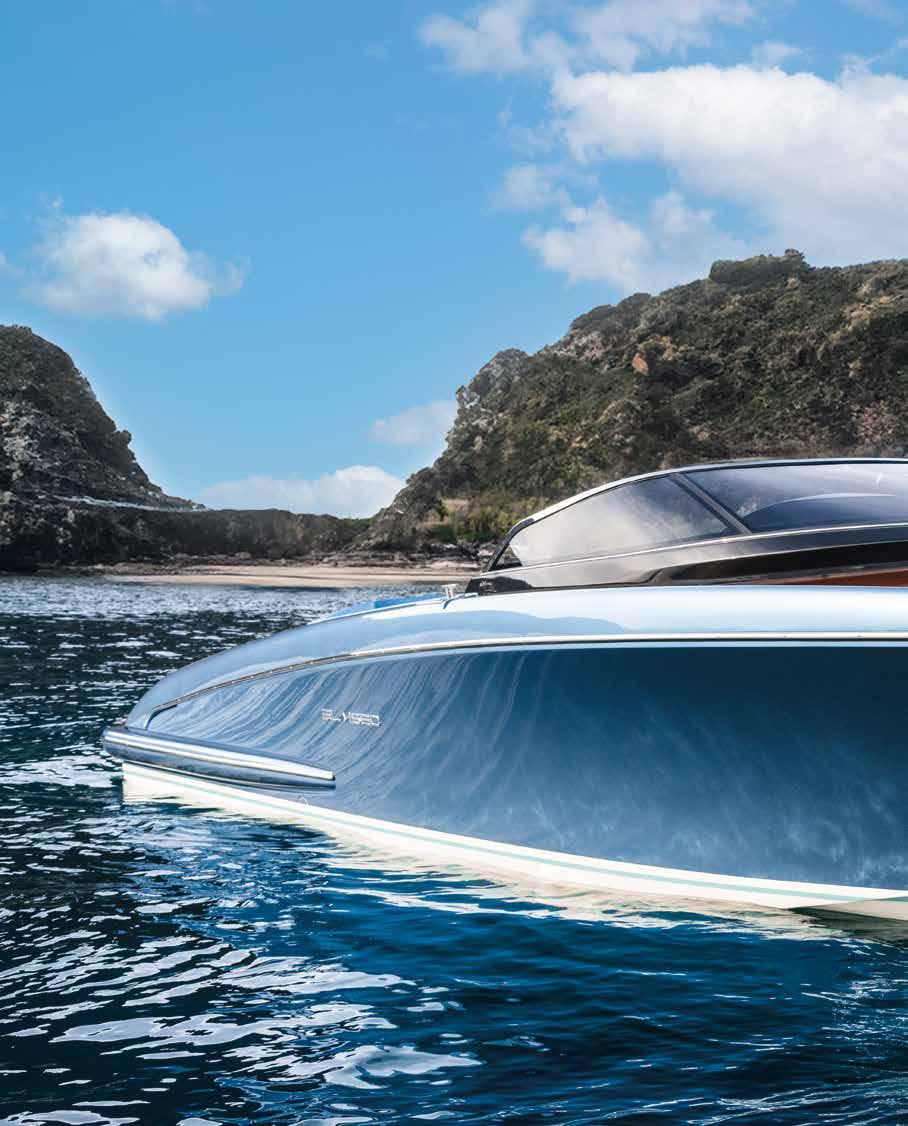
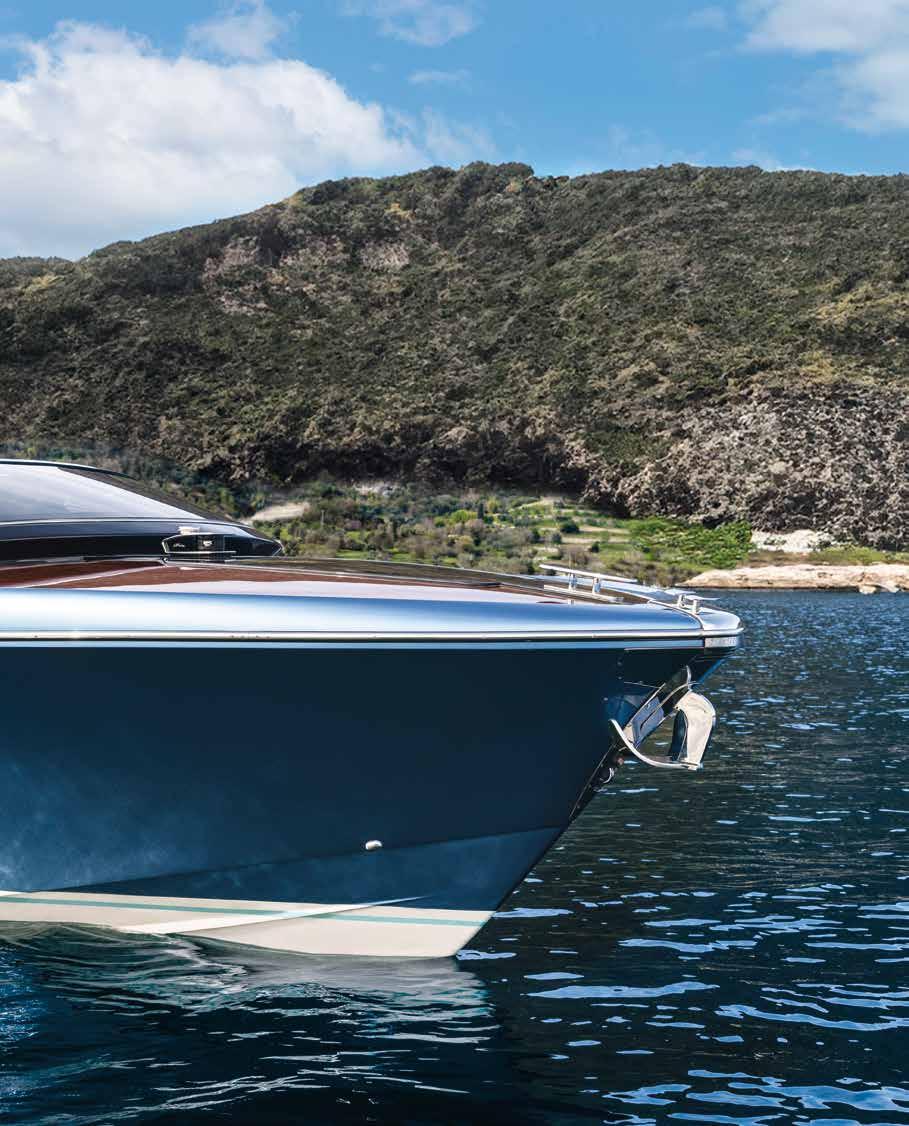
Each new Riva model looks ahead while remaining rooted in a rich legacy of elegance, craftsmanship, and design that spans more than 180 years. As the brand’s first all-electric boat, the Riva El-Iseo takes this to the next level by striking the difficult balance between tradition and sustainable innovation
The 8.4m Riva El-Iseo marks a landmark moment in tender design.
The first fully electric boat from the iconic Riva brand, it represents a considered approach to sustainable innovation, while retaining the classic elements that define Riva’s heritage. Designed by Officina Italiana Design – like all Riva creations – in partnership with the Strategic Product Committee led by Piero Ferrari and the Ferretti Group Engineering Department, the El-Iseo is a modern interpretation of the much-loved Riva Iseo, a model known for its balance of practicality and elegance. In fact, the Iseo represented the ideal starting point for Riva’s journey into new territory. “First and foremost, in terms of its size,” explains Mauro Micheli, Chief Designer at Officina Italiana Design. “The fact that it is an eight-metre open makes it the perfect yacht tender and ideal for getting to areas where the waters are very shallow.”
Innovations plays the most important role in the El-Iseo’s development. The fully electric propulsion system delivers performance previously unheard of in this segment. Able to reach speeds of 40 knots in complete silence, the boat offers a dynamic and comfortable experience without compromising on environmental responsibility. The lithium battery system includes advanced safety features such as liquid cooling and thermal insulation. While changes were made to the styling to make the design more contemporary,
the design also retains key elements of Riva’s identity, including the polished mahogany deck and stern platform, stainless steel detailing of the lateral grills, and the signature aquamarine beauty line. The choice of a novel ‘California Sky Blue livery’ for the first hull underscores the vessel’s sustainable focus while creating a striking contrast with the traditional wood elements.
The reimagined bridge is another thoughtful point of difference. With all-digital instrumentation integrated into a clean and simple design, it combines contemporary functionality with the sophisticated classic car-inspired lines. This creates a contrast between traditional and contemporary that sums up the very concept of the boat. “We have succeeded in creating a stylish boat very much in line with the times using the very successful Iseo model, which has particularly deep links to Riva tradition,” reflects Sergio Beretta, CEO of Officina Italiana Design.
Blending tradition and innovation, the El-Iseo represents the next generation of a model that embodies the signature elegance and attention to detail that Riva is known for, proving that sustainability and heritage can coexist without compromise. “Riva El-Iseo isn’t only the world’s most beautiful fullelectric powerboat, but also proof that investing in research and development opens up new paths to sustainability and environmental awareness,” adds Ferretti Group CEO Alberto Galassi. www.riva-yacht.com





He peeps out through the sapphire crystal as if taking a slightly disturbing look at the world outside. Companion, the famous character created by contemporary artist Kaws, overturns conventions to become the star of the latest creation from Audemars Piguet
by Diego Tamone - ph. courtesy by Audemars Piguet

Afew years ago, some will have seen, flying over some of the world’s most important cities, a 42-metre high balloon in the form of Companion, perhaps the most famous character by the artist Kaws, which in a short time has become a contemporary pop icon. Others will have seen him floating serenely, securely tethered by strong cords, over Broadway, New York during a Thanksgiving Day parade. A few months ago, though, Companion also made a surprise appearance in the Vallée de Joux, in Switzerland’s Jura region, again in inflatable form but this time appearing




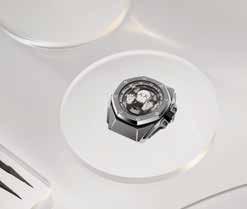

on the roof of the Audemars Piguet headquarters in Le Brassus.
For many, it was an unequivocal sign that something was about to happen in the factory. And that turned out to be true, as the Swiss brand, universally known for its iconic Royal Oak model, has launched a new designer collaboration. This time it has chosen to work with the eclectic artist from New Jersey, miniaturising his Companion, a sort of dystopian Mickey Mouse combining clown-like elements with cartoonish references to death, placing the figure literally in the centre of a watch, the Royal Oak Concept Tourbillon “Companion”, engineered by Audemars Piguet and then produced in a limited edition of 250. In this way the brand presents a very real and undeniably substantial interpretation of the amusing yet also disturbing character created by Kaws. Its technical content is based on a manually-wound mechanical movement with tourbillon, whose uniqueness lies in the way it displays the time, shown not by classic timepiece hands but by two rotating rings attached to two arrow indicators. This technical solution was chosen to ensure that nothing distracts from the Companion’s presence centre stage. audemarspiguet.com

Top, front and back of the model display the watch’s mechanism and the creativity involved in its production. Above, the final stages in assembling the manual movement and case. Below, the “Companion” by AP, in 250 examples






















Art, nature, and craftsmanship intertwine in the new Diorama & Diorigami high jewellery collection, designed by the visionary Victoire de Castellane for Dior
by Gianfilippo Versari - ph. courtesy by Dior

A monochrome take on the Toile de Jouy print, blending various diamond cuts with abundant white pearls to portray a lush, precious forest. This page: Diorama Forêt Blanche Diamond Necklace in yellow gold, diamonds and white cultured pearls. Next page: Diorama Earrings and Brooch with pear-cut diamonds and diamondpaved rabbits.
With the Diorama & Diorigami high jewellery collection, designed by the visionary Victoire de Castellane, Dior celebrates in two chapters the dialogue between tradition and innovation, transforming flora and fauna into timeless masterpieces. In the first chapter, Diorama, the enchanted garden of Milly-la-Forêt comes to life.
The historic toile de Jouy, a symbol of French art de vivre, is reimagined in jewellery pieces that seem to emerge from a dream. These creations narrate a poetic stroll through an enchanted garden where delicate creatures and natural details merge into breathtaking scenes.
Close your eyes and imagine a golden rabbit leaping through diamond-studded bushes, majestic swans reflected on sapphire-

adorned ponds and two owls soaring amidst branches ablaze with fiery rubies. This couture vision of nature includes deer and squirrels carved in chrysoprase, framed by foliage in yellow and rose gold and adorned with gems capturing every shade of green.
The glyptic technique, masterfully executed by Dior artisans, sculpts each precious stone, crafting enchanted landscapes reminiscent of a lost Eden. The Maison’s signature lacquer enhances the vibrant hues, from the intense green of emeralds to the delicate tones of tsavorite garnets, transforming every jewel into a tableau vivant.
The second chapter, Diorigami, is an ode to geometric poetry in jewellery, taking inspiration to new frontiers. It honours the art of origami with the precision and lightness characteristic of the
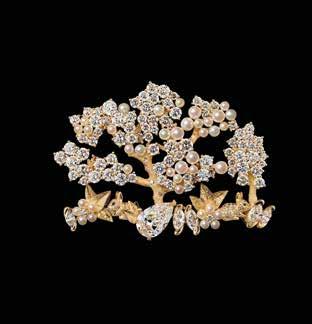



iconic Bar suit. Here, nature transforms into refined geometries: delicate paper-folded flowers become precious sculptures, while necklaces and rings celebrate sartorial artistry with pleated folds of extraordinary grace.
Iconic symbols of Dior’s design continue to enchant in Diorigami, an imaginary world populated by vibrant flora and fauna. Sets unveil an enchanted forest inhabited by animals with joyful designs, alongside necklaces, rings, and earrings adorned with delicate flowers that evoke the precision of origami.
A dreamy journey, a multifaceted tribute to the intricate wonders and timeless charm of nature, so dear to Dior’s heart. Sapphire necklaces, rings, and earrings replicate details inspired by nature: a doe hidden in a grove or swans gliding over a pearlescent pond.
Among the collection’s standout pieces are a double rose gold ring adorned with spinels, sapphires, and garnets evoking an eternal bouquet, and dazzling necklaces capturing the magic of a fairy-tale forest. Each piece is a symphony of vibrant colours and harmonious shapes, where the balance between tradition and modernity translates into a unique jewel, telling stories of beauty and wonder.
With Diorama & Diorigami, Dior reaffirms its role as a master of high jewellery, transforming precious stones and noble metals into works of art that celebrate nature and tradition—a dreamlike Eden where the savoir-faire of the Parisian Maison intertwines with the eternal enchantment of nature. Each creation is not just a jewel but a fragment of poetry to wear, a hymn to beauty that transcends time. www.dior.com


Top, clockwise, all from the Diorigami collection: a ring with a diamond-paved rabbit and a majestic diamond; earrings and a necklace featuring diamonds, emeralds, sapphires, and Paraibatype tourmalines; a double ring in white, pink, and yellow gold with diamonds, rubies, emeralds, pink sapphires, red spinels, spessartite and tsavorite garnets

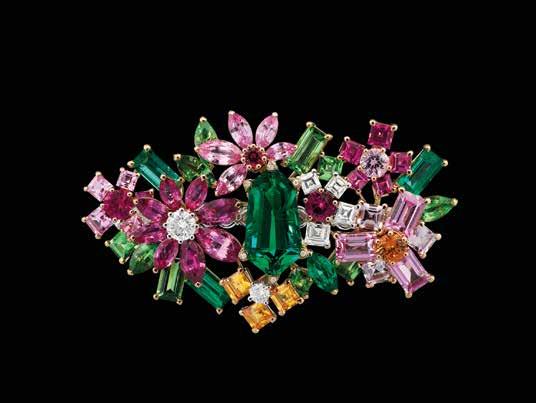

●The expansive terraces provide the perfect vantage point for panoramic ocean views from sunrise to sunset
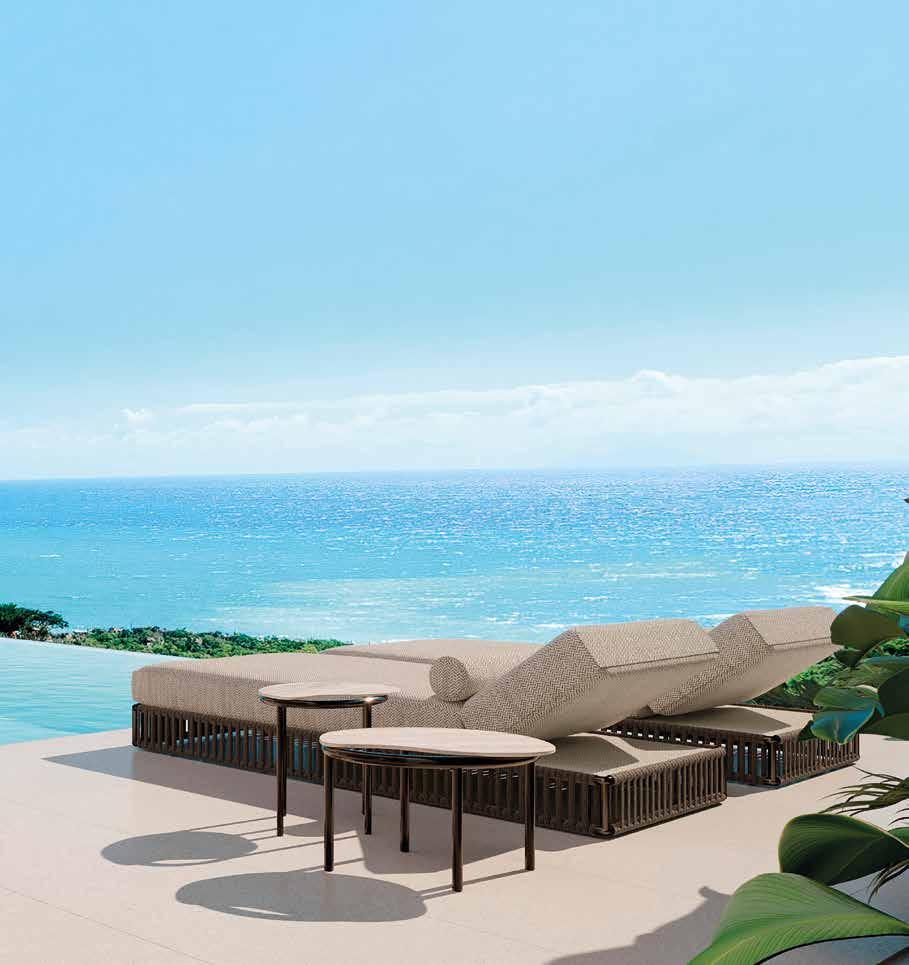
Founded in 1982, ELIE SAAB has become a global icon of couture, beloved by celebrities, royalty, and discerning clients worldwide.
Marking a bold step into luxury real estate, Infinity Villas by the ultraluxury brand redefines opulence in the Caribbean, set against the mesmerising backdrop of Sint Maarten’s Indigo Bay
by Jane Catchpole

This landmark development, a partnership between ELIE SAAB and visionary developer, Classique Realty, introduces the Caribbean’s firstever branded villas. Nestled within Indigo Bay’s exclusive 150-acre retreat, the villas boast over 1,200 meters of white-sand coastline and Caribbean Sea views. Centrally located yet secluded within a secure gated enclave, residents enjoy both convenient access to the island’s attractions and a tranquil, private sanctuary. Featuring 12 impeccably crafted residences that blend contemporary design with timeless elegance, Infinity Villas sets a new standard of luxury living in Sint Maarten.
“Bringing the ELIE SAAB brand to the Caribbean allows us to craft an unparalleled luxury experience,” shares Nikhil Gurnani, Founder of Classique Realty. “Infinity Villas combines our expertise in sustainable, iconic developments with ELIE SAAB’s signature sophistication.”
The villas boast a striking aesthetic fusing modern minimalism with opulent craftsmanship. Designed with four or five bedrooms, they are perfect for families or discerning individuals seeking a private retreat. Every detail - from the architectural form to the interior finishes - carries the distinct touch of ELIE SAAB’s renowned style. As Elie Saab Jr., CEO of ELIE SAAB Group, remarks, “This collaboration showcases our brand’s values through architecture and design, bringing the ELIE SAAB experience to
life in an extraordinary setting.”
Infinity Villas exemplifies indoor-outdoor living. Expansive terraces and private gardens offer breathtaking views, while heated pools and Jacuzzis beckon relaxation under tropical skies. Inside, the ELIE SAAB Maison furniture infuses every room with refined comfort, complemented by airy textures and tropical-inspired hues. A glass lift adds another touch of modern luxury, ensuring every detail speaks of convenience and class.
To make each villa uniquely personal, residents can select from three curated mood boards—Coastal Charm, Tropical Retreat, or Sophisticated Island Elegance. These tailored options allow owners to craft spaces that truly reflect their individual tastes.
Beyond the homes themselves, Infinity Villas offers a suite of exclusive amenities, including an All-Day Concierge service and integrated smart home systems. Designed with sustainability in mind, these villas are as eco-conscious as they are luxurious, blending seamlessly into the lush Caribbean environment.
As construction progresses, the anticipation builds. With the first villas ready for occupancy by early 2025, the Infinity Villas by ELIE SAAB promise to redefine what it means to live luxuriously in paradise. eliesaabvillasstmaarten.com
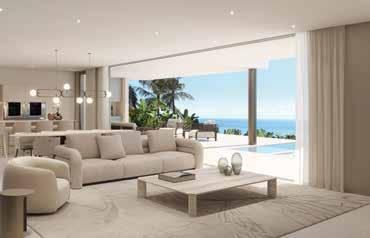


●Clean lines and natural materials define the modern design of Infinity Villas. Each villa is crafted to embody ELIE SAAB’s distinctive elegance. ●The open-plan layout creates a seamless space for modern living and entertaining. Opposite, ●Infinity Villas seamlessly blend into the lush greenery of Indigo Bay, whilst offering breathtaking views of the Caribbean







theoneyd.com platinummedialab.com
EDITOR IN CHIEF
Barbara Del Duca
MANAGING DIRECTOR
Désirée Sormani desireesormani@platinummedialab.com
ART DIRECTOR
Laura Larese de Santo lauralarese@platinummedialab.com
CONTRIBUTORS
Sergio A. Barlocchetti (Aviation), Marta Bernasconi (Furniture & Design), Paola Bertelli, Jane Catchpole, Roxanne Huges (Properties), Veronica Lempi (Furniture & Design), Bryony McCabe, Diego Tamone (Cars and Watches), Samuela Urbini, Gianfilippo Versari (Luxury Goods), Micaela Zucconi (Art & Design)
TRANSLATIONS
Chris Thompson
PUBLISHER
Deborah Bazzoni ph. + 39/02-36683420, mobile + 39/335 6282058 deborahbazzoni@platinummedialab.com
MARKETING & EVENTS
Gioia Bianciardi (Marketing & Events, Furniture and Design) mobile +39 392 2287058 gioiabianciardi@platinummedialab.com
PRINTING
ROTOLITO Spa Via Sondrio, 3 Pioltello - Milano
DISTRIBUTION FOR ITALY AND ABROAD
SO.DI.P. “Angelo Patuzzi” S.p.a. Via Bettola, 18 - 20092 Cinisello Balsamo (MI), Italy ph. +39/02-660301- fax +39/02-66030320 e-mail sies@sodip.it
SUBSCRIPTION SERVICE
ph.: + 39/02-36683420 (Italy’s office hours) www.theoneyd.com/magazine-subscription
BACK ISSUES
Double the cover price + delivery costs
NEWSSTAND DISTRIBUTION
The ONEYacht&Design is distributed in the major newsstands and airports in the following countries: Austria, Belgium, Brazil, France, Germany, Greece, Hong Kong, Italy, Luxenbourg, Malta, Norway, Poland, Portugal, Principality of Monaco, Slovenia, Spain, Sweden, Switzerland, Taiwan, The Netherlands, Turkiye, U.a.e., U.s.a., United Kingdom
ALTERNATIVE DISTRIBUTION
The updated list of our distribution among Platinum Media Lab’s premium partners can be found on our web site platinummedialab.com
All rights reserved for Italy and abroad The One, Registered at the Milan law court n° 22 - 30/01/2015
Via San Calimero, 1 20122 Milan Italy ph. +39/02-36683420 a.r. - fax + 39/02-36683421 info@platinummedialab.com
CEO
Matteo Galbiati matteogalbiati@platinummedialab.com
Platinum Media Lab publishes the following international magazines
onder

#cocktailnapkins

Mytable_Milano

mytable_milano
www.mytablemilano.it
